

VisitParaguay.net
Your Guide to Paraguay
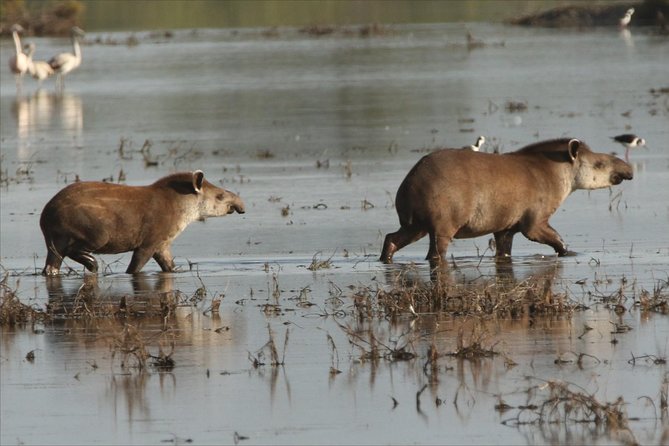
Chaco, Paraguay – Land of Ecotourism
While Asuncion and eastern Paraguay provides plenty of modern cities and conveniences, the area known as Chaco in Paraguay is rich in environmental resources, indigenous culture and agriculture. Chaco in Paraguay is part of a larger scrubland region of South America known as “ Gran Chaco ”. Gran Chaco is the largest dry forest in South America and is a direct corollary to the Amazon Rainforest .
Chaco in Paraguay is huge- in fact, it covers nearly 60% of the country mostly to the west and north. A little over 10% of Paraguayans live in Chaco. Most of these are farmers and cattle herders, though about 30% are indigenous natives who still practice the way of life they’ve lived for thousands of years.
Paraguay’s Chaco is protected by The Nature Conservatory, who works annually to protect the scrublands, savannas and wet marshes that dominate the Chaco lands. Paraguay’s Chaco has two key wildlife reserves: Medanos National Park and Defensores del Chaco National Park . Both contain mammals and plant species that many tourists travel across the world to see.
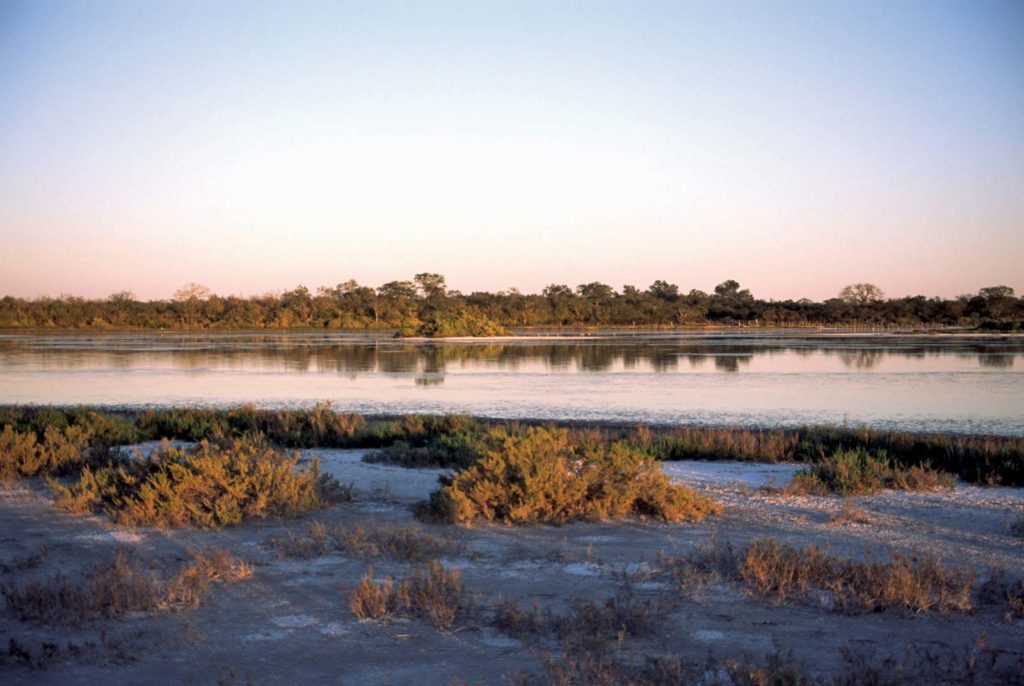
For the ecotourist, Chaco provides an opportunity to see some very rare wildlife. Chaco’s northernmost district, home to the Defensores del Chaco National Park, is called Alto Paraguay. Alto Paraguay is home to jaguars, puma, tapir, tagua, giant anteater and the night monkey. The large region is also home to over 500 species of native birds . For the bird watching tourist, Alto Paraguay in Chaco is an once-in-a-lifetime chance to spot rare avian species. The tourist can access Defensores del Chaco National Park via Route Route 9.
The Boquerón district in Chaco is home to Russian Mennonite communities. There’s about 45,000 Paraguayans living in Boquerón, mostly near the Russian Mennonite communities of Fernheim, Menno and Filadelfia. The agricultural farmers in this area produce cattle meat and milk for most of Paraguay, owing their success to the Mennonite communities. The Mennonite communities are open to visitors and are a good way to visit local indigenous populations that share relationships with them.
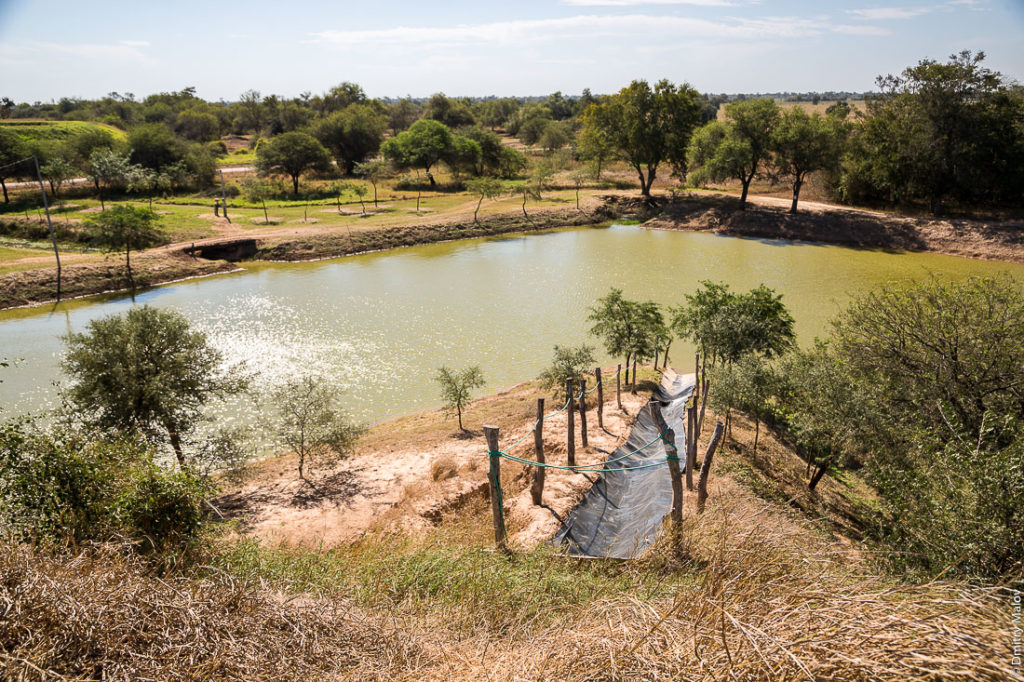
Presidente Hayes is a department in southern Chaco that attracts many tourists and trades heavily with Argentina. The region has the Tinfunqué National Park, another spot to see rare species. Several other Mennonite communities are located in this region as well, and the Parque Trebol provides a safe campground for travelers who want to truly “get away” from it all.
Traveling to Chaco in Paraguay can be accomplished a few ways. Flying into Asuncion , a traveler can drive up Route 9 to access almost all parts of the Chaco region. Route 12 is another road to the western part of Chaco, but it is not well-paved and sometimes impossible to drive during the rainy season. Most parts of Chaco in Paraguay are between 4-6 hour drive from Asuncion.
The Chaco region is Paraguay’s last untouched natural forest with hundreds of rare sights for the ecotourist. Easily accessible, Chaco is a great 3-4 day getaway for the Paraguayan traveler. Few places in the world exist where you can experience nature in its raw beauty like you can in Chaco.
Chaco Canyon Day Tour An authentic, cultural and vivid encounter with the mystery of Chaco Canyon
Saturday 7:15 am - 5:45 pm, additional info.
BOOK NOW [ CANCELLATION POLICY ]
What to Expect: Chaco Canyon Day Tour
Read About our Chaco Tours in 360 West Magazine Article, The Dallas News, Adventure Pro Magazine and Cowboys & Indians
We’ve been preparing for your visit for over 1,000 years
Did you know the U.S. has a pre-historic Puebloan place of mystery that has been likened to Macchu Picchu, which is little seen or visited?
Transport yourself into another world, at Chaco Canyon! This UNESCO World Heritage Site and National Park lies on top of the southeastern Colorado Plateau’s physiographic province in the San Juan Basin and had a diverse thriving culture from 850 A.D. to 1250 A.D. It served as the heart of spiritual and ceremonial practices for the Chacoan people.
Experience this major ancestral Puebloan center of migration, grand construction, and cultural integration and see why Chaco is a fascinating place of mystery.
To the Pueblo man it is spoken to be the cradle of civilization and the burial place of their ancestors. To the Dinetah, it is the center of the world they evolve from. To the Hopi, it is the final destination. Take a journey with us back in time to experience these highly organized large-scale structures, featuring multi-storey construction and sophisticated coursed masonry, which illustrate the increasing complexity of Chaco social structure.
Chaco distinguished itself within the regional ancestral Puebloan culture and dominated the area for more than four centuries. These structures weren’t farming villages, they were public buildings used by communities and regions for ceremonies, trading and civic events.
More than 150 distant communities emulated Chacoan architectural designs, layout, and construction of their public buildings. Linking the sites, there was an elaborate system within the canyon of carefully engineered roadways, stairways, and ramps to sites far beyond, that can still be traced.
Yet, with their high level of complex infrastructure, architectural development, economic reach and social organization, no one knows what caused their sudden collapse in the 13 th century. Quickly, villages were permanently abandoned, never to be revisited or revived again.
So here is your opportunity, beneath the expansive skies of northern New Mexico, to soak in this ancestral corridor that paints an expansive story.
Day Tour Overview – Roads to the Soul Aren’t Paved
Our journey begins with a visit to Una Vida, an L-shaped Great House where you can explore a petroglyph panel etched in the canyon’s cliffside sandstone. These petroglyph panels are pecked, incised and abraded into the sandstone and their significance is still recognizable today by Puebloan and Navajo peoples because they symbolize specific clans or story elements.
If the short steep climb seems too much for you, the other option is to visit Chaco Canyon’s Visitors’ Center museum and watch the 20-minute interpretive film. After either excursion, you will enjoy a picnic lunch.
Following lunch, we will explore the largest Great House, Pueblo Bonito, a Spanish word for “pretty village.” This important epicenter of ancestral homeland showcases the core-and-veneer walls that distinguish Chacoan great-house construction.
Pueblo Bonito is the most thoroughly investigated and celebrated cultural site in Chaco Canyon. The term “great house” is an archeologist term to describe the large sites in Chaco. These great houses shared many architectural features such as planned layouts, multi-storied construction, distinctive masonry, very large rooms, plazas, and huge subterranean ceremonial chambers called “great kivas.”
You will learn about the first excavators and their findings as you explore the important Room 28 where 111-cylinder jars, a tall and narrow form of pottery, were found. These cylinder jars were used for drinking a chocolate beverage made from the cacao tree brought from Central Mexico, believed to be drank by high-ranking people during rituals. This journey would have been nearly 1200 miles away from Chaco!
You will conclude your visit to the greatest kiva, Casa Rinconada. Casa Rinconada is a large round building complex. The symmetry of the axes creates a perfect circle and some speculate it physically represents the Ancestral Puebloan cosmos and served as an important religious center.
Throughout the day, you’ll be dismayed at the obvious societal advances and ponder what created their sudden failure and destruction.
Heritage Inspirations wishes to provide you with an authentic, culturally vivid encounter with the mystery of Chaco Canyon.
In order to accomplish that, Heritage Inspirations plans all the logistics so that you can simply experience a beautiful scenic drive. Our informative guides offer you special insight and knowledge into the area and will also provide you with the tools needed to dive deeper into the mysteries of Chaco.
Don’t miss out on this authentic, cultural and vivid encounter with the mystery of Chaco Canyon!
These tours have limited space and sell out fast. Book your tour in order to experience the elemental beauty of eroded sandstone and desert wind while you imagine the presence of ancient voices.
How to Get Here, What's Included, What to Bring + Traveler Tips
Difficulty rating: 2.
1 = Easy | 3 = Moderate | 5 = Difficult
GUEST MIN/MAX: 4 min / 10 max
How to Get Here
FLY DIRECT to Albuquerque, Santa Fe, or Taos Learn More ›
MEET AT: Hotel Chaco in Old Town Albuquerque Get Directions › -->
RETURN TO: Hotel Chaco in Old Town Albuquerque
What's Included
Breakfast Snack Transportation Snacks and water to enjoy on the drive Interpretive pamphlets about Chaco Canyon Entry into Chaco Canyon Guided Interpretive Exploration of Pueblo Bonito Picnic lunch provided by Hotel Chaco
What's Not Included
Gratuity for your inspired guide.
Traveler Tips
Chaco Canyon is a very remote, open and exposed landscape, at high elevations and in a high desert environment. Proper hydration and sun protection is a necessity. New Mexico weather can change without much notice.
ENJOY LOCAL CUISINE BY:
Hotel Chaco & Your Inspired Hosts
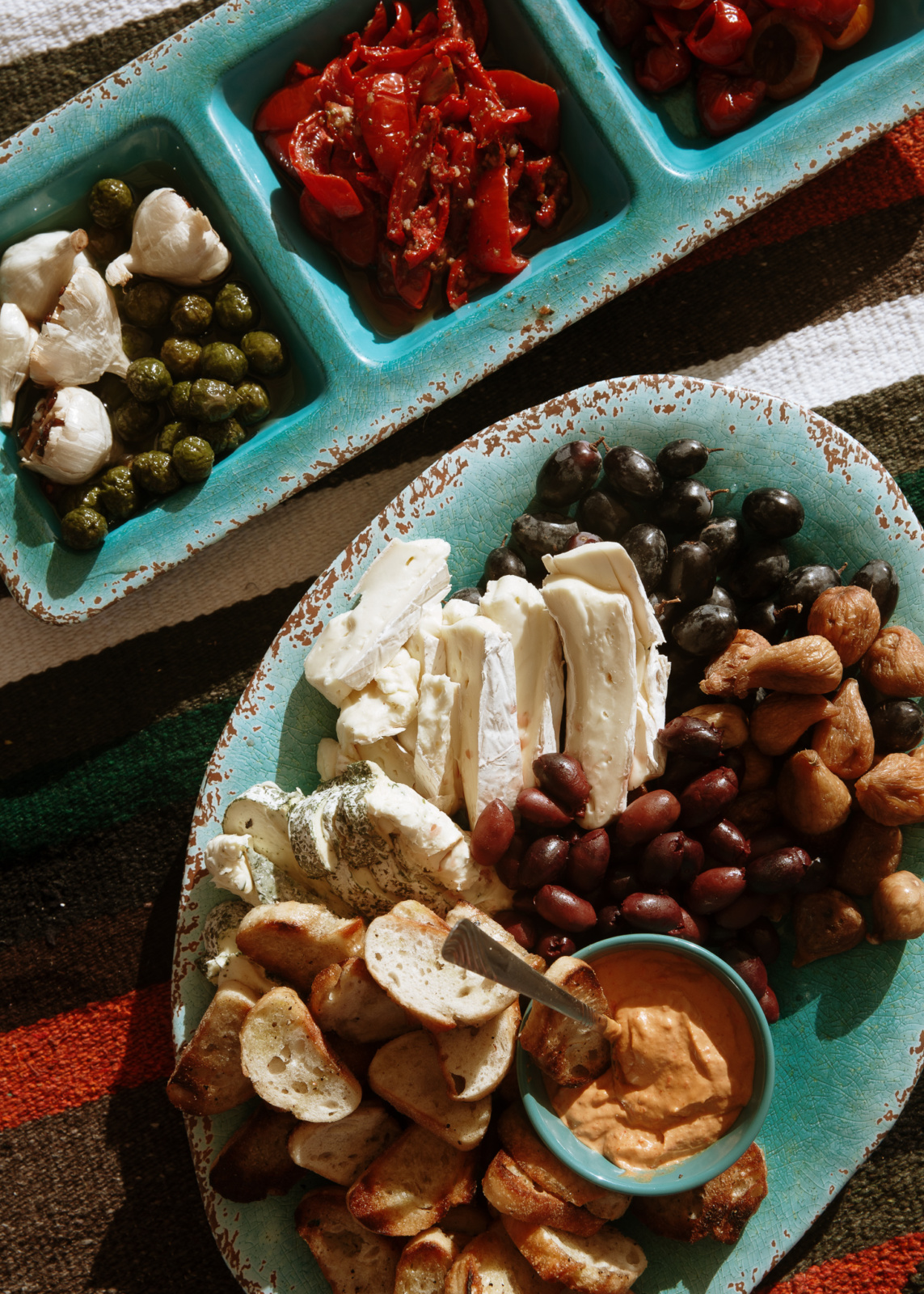
Your breakfast snack and lunch are provided by Hotel Chaco. VIEW MENU »

Speak with your inspired travel planner
1-888-344-tour(8687).
H.I. HQ TOUR HUB, TAOS inside EL MONTE SAGRADO RESORT 317 Kit Carson Road | Taos, NM 87571 575.737.9827
NEW MEXICO TOURS Santa Fe Tours Taos Tours Chaco Canyon Tours Albuquerque Tours
GLAMPING E-BIKE PRIVATE TOURS
Road Trip Itineraries Virtual Inspirations
Explore the Photo Gallery
MEET THE TRIBE Our Mission: Travel for Good Press Blog Shop H.I. Gear Shop Curated Collection Careers Getting Here: Fly Direct Contact + Locations
Download Our Brochures Cancellation Policy Privacy Policy Terms of Use
-->
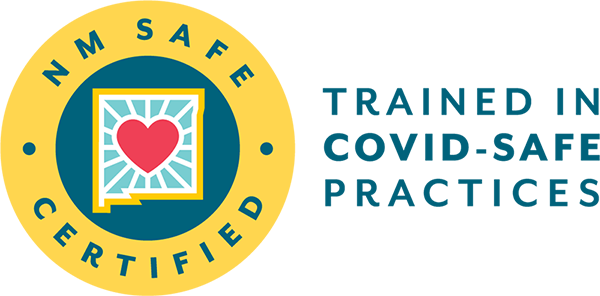
© 2024 Heritage Inspirations LLC
Photographer Credits: Paulina Gwaltney Photography , Amanda Powell · adrift a dream photo . video
© All Rights Reserved. All materials and photographs on website by Heritage Inspirations LLC. Absolutely no usage without written permission.

How To Visit Chaco Canyon: A Complete Guide To The Ancient Structures
Preserving the largest concentration of large-scale ancient structures in the Four Corners built by the Ancestral Puebloans, Chaco Canyon is one of the most studied archaeological sites in the U.S. Southwest. Along with Aztec Ruins and several smaller Chacoan sites, the ancient ruins in Chaco Canyon are a designated UNESCO Heritage site since 1987, recognized for their universal value.
Table of Contents
Its monumental ceremonial and public buildings feature a distinct architecture that marks Chaco as an ancient ceremonial, political, and trade center. Chaco Culture National Historical Park preserves these ruins, while allowing visitors to enjoy and learn about them.
Fortunately, as well-known as it is, Chaco’s fame doesn’t translate into being overcrowded. Yet. Although over the years I have noticed a growth in the number of visitors.
The site is one of my family’s favorites in the Southwest; we revisit the ancient structures year after year, yet I still seem to learn something new every time we go. We also see changes in the park, some we like, others not so much…
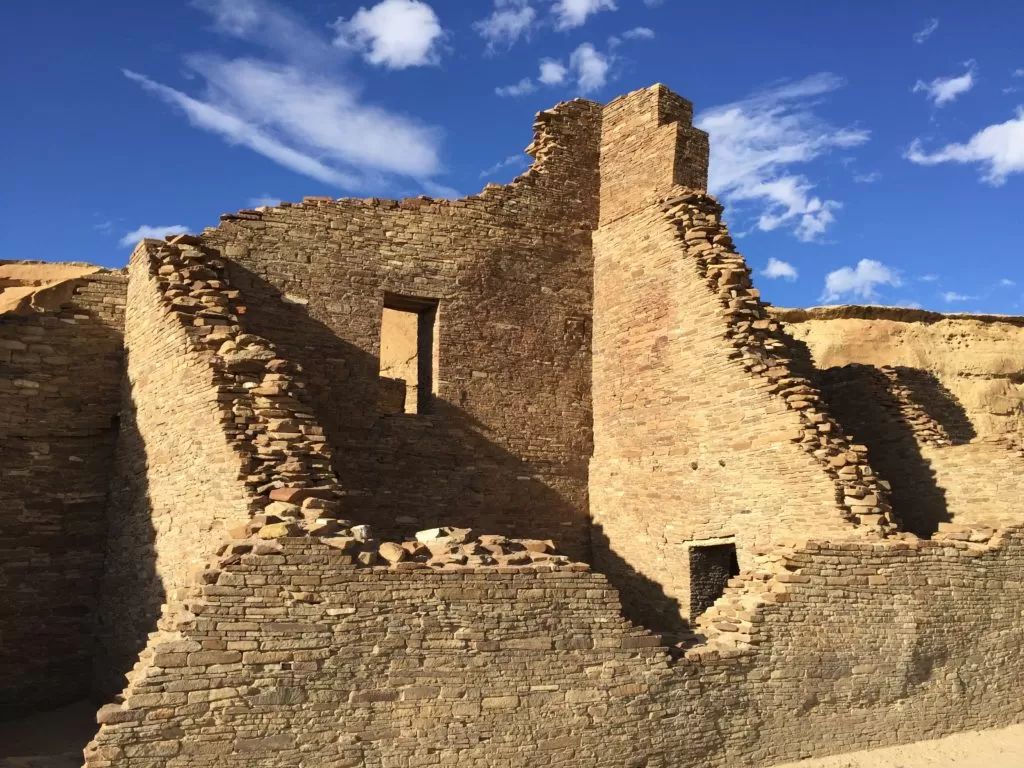
Getting To Chaco Canyon
The ruins in Chaco Canyon are still some of the least visited ones showcased in national parks. The reason for this is their remoteness. Laying in the middle of the Navajo Nation, reachable only by dirt roads, Chaco is far from any tourist route.
You need to drive about 20 miles on a dirt road to reach Chaco Culture National Historical Park from either direction. You don’t need a four-wheel drive to get through it, but a high-clearance vehicle is helpful. However, most cars can make it in good weather, as long as they can handle large potholes. I wouldn’t recommend it for low-clearance luxury cars though. They would most likely bottom out in several places.
The road from the northeast is usually in better shape, though during our latest visit a couple who drove through in a compact car told us it was almost impassable for them in some areas. The east side where we came from seemed better in comparison, though they made it in and out with their car in one piece.
We drive an SUV into Chaco most of the time, although we drove in a compact car (a VW Jetta) about twenty years ago.
So you know you have to be dedicated to see the site before setting off on this adventure.
Because visiting Chaco is always an adventure.
However, even with the dusty, often rough dirt road experience, the way to Chaco has a magical element to it. Especially at sunrise and sunset, when the desert colors are at their best.
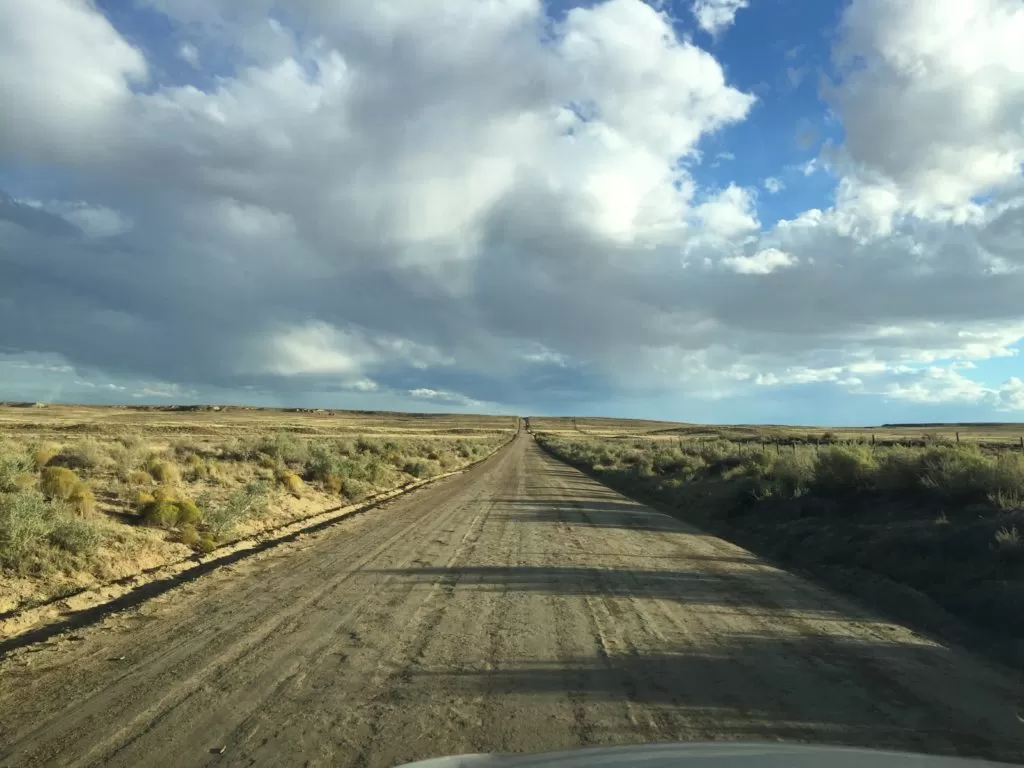
Chaco Culture National Historical Park
After the long dirt road, it always surprises me that the loop within the National Park is paved. After all, people who made it there, already drove over twenty miles on dirt. However, the smooth pavement offers a nice change.
Stop At The Visitor Center
The best way to start your visit is to stop at the Visitor Center. Chances are, by this time, you also might need a restroom break. At least I always do. The Visitor Center has traditional flush toilets, something you won’t find in the rest of the park, although you’ll find no-flush toilets in at every parking stop along the loop.
Along with traditional flush toilets, you can find water refill stations for your water bottle.
But the best part of the Visitor Center is the new museum and the film they play about the archaeological site.
The museum is missing most artifacts at this time (in September 2023). However, it still has several exhibits that explain the natural and human history of the canyon. In the center, an interactive replica of Chaco Canyon with all its major buildings offers facts about them in a highlighted question-and-answer format.
You shouldn’t leave without watching the short movie about Chaco. Told from several perspectives, including members of the Hopi nation, descendants of the people who built Chaco, the film gives you a new perspective, a deeper understanding of the archaeological site.
Rangers in the Visitor Center are happy to answer any questions and offer additional insight into the area. And, if you are there at the right time, you might meet archaeologists working at the site. You can get all the information here, including some about ranger talks and guided tours of Pueblo Bonito, the largest and best preserved structure at the site.
Una Vida, The Site Near The Visitor Center
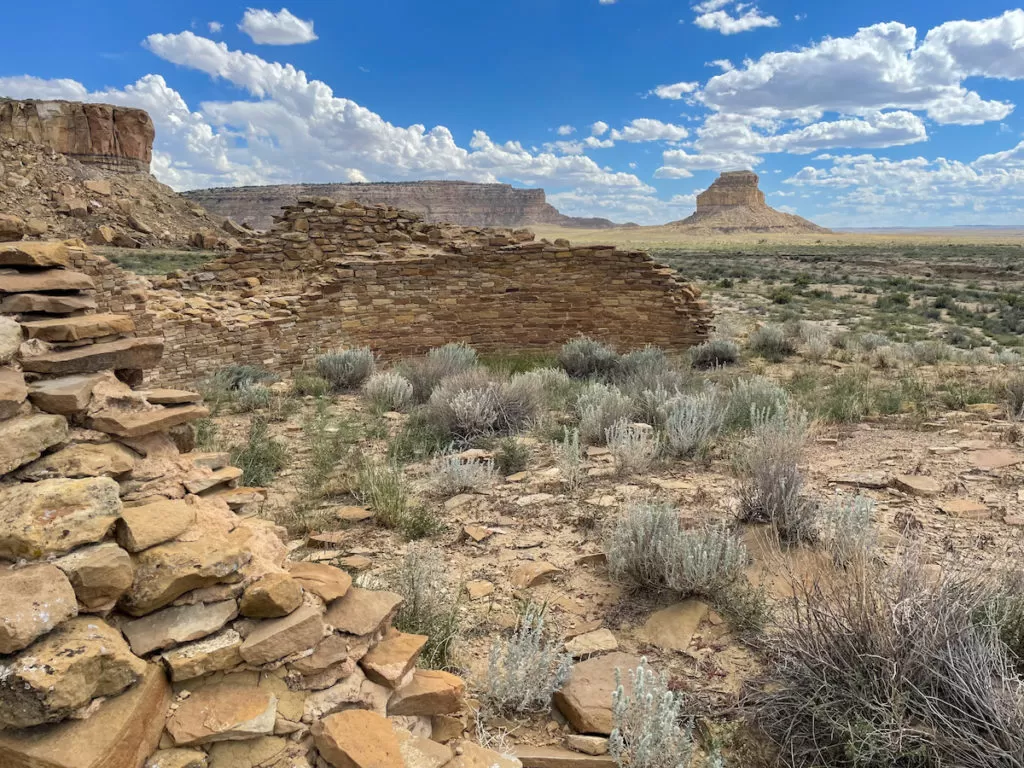
One of the Great Houses of Chaco Canyon, Una Vida, is easy to reach from the Visitor Center.
According to the interpretive sign on the trail, building this site started in 850 AD and it continued for about 250 years. It had about 100 rooms and kivas in an enclosed plaza.
However, you wouldn’t know this by looking at it, since it is only partially excavated. Centuries of dust and dirt covered the site, giving you an opportunity to see it in its natural state.
You can reach it by an easy, one-mile long round-trip trail starts near the Visitor Center. Though not much to look at as an archaeological site, it offers a gorgeous view of Bajada Butte and its surroundings.
A vertical, steep offshoot of the trail leads to several well-preserved petroglyphs.
After returning to the Visitor Center, get in your car to drive the nine-mile loop road leading to the larger sites.
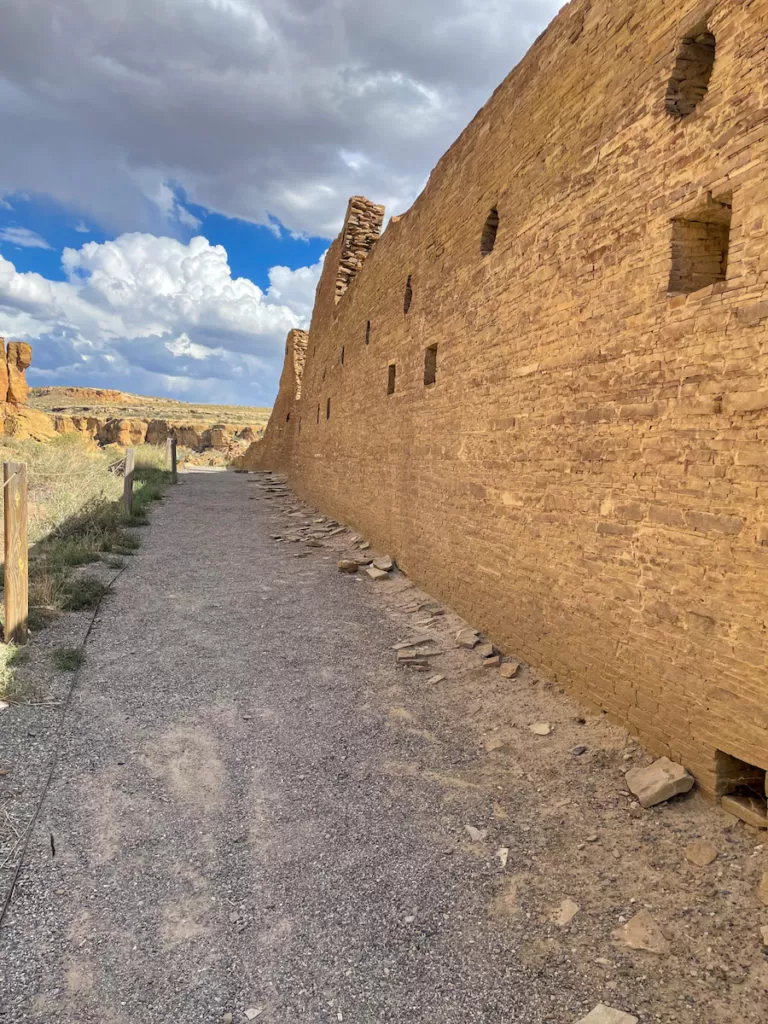
About a mile into the road, the first stop is the trailhead to Hungo Pavi. Another Chacoan Great House, occupied between AD 1000 – 1250s, it is a set of ancient buildings comprising 100 rooms, some of them four stories high, and a great kiva in an enclosed plaza.
The short trail leads through several structures and kivas, and continues behind the largest structure, offering shade from the sun.
Next Stop Along The Loop
The next parking lot offers access to both Chetro Ketl and Pueblo Bonito, two of the largest sites in Chaco Canyon. You can start with either one, but we generally opt to start with Chetro Ketl, take the Petroglyph Trail to Pueblo Bonito, and return to the parking lot from there. It is a large circle loop trail this way.
Chetro Ketl
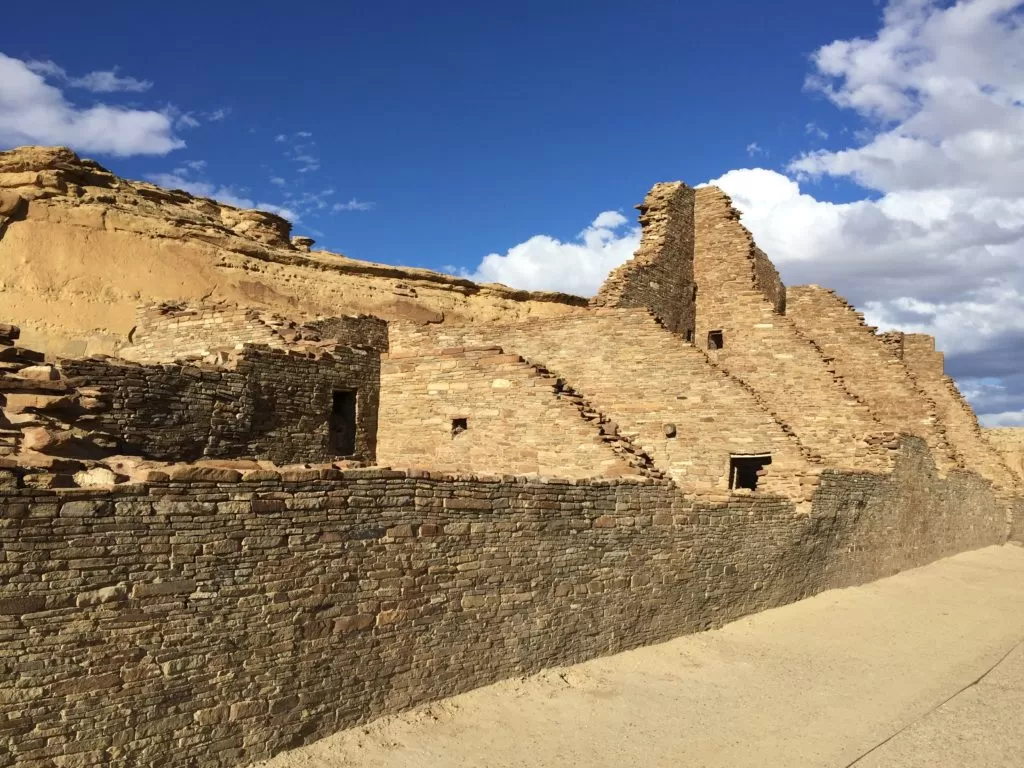
One of the largest Chacoan great house, Chetro Ketl, showcases some of the unique architectural features of the site.
It had about 400 rooms, some of them four stories high, spread over three acres. Half of it was enclosed in an enclosed plaza, lined with rooms to the north, east, and west.
The great house is a D-shaped structure, with its longest wall (on the north) running parallel to the canyon wall.
Besides all the rooms, Chetro Ketl has twenty kivas. One of them is a great kiva, a few other large ones, and one elevated, or tower kiva.
The half-mile-long trail through Chetro Ketl takes you through some of these rooms and around the great house’s perimeter.
The Petroglyph Trail
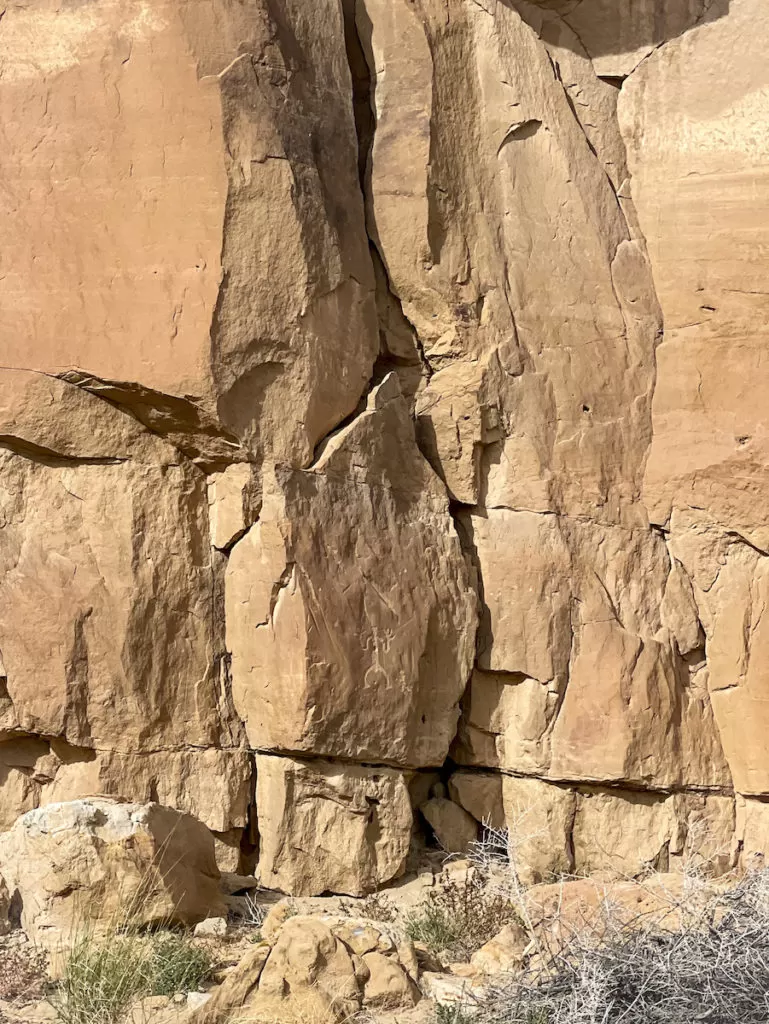
The Petroglyph Trail, running along the canyon walls, connects Chetro Ketl and Pueblo Bonito. This quarter-mile trail is always our choice of visiting the two sites.
However, you can return to the parking lot and take the other trail to Pueblo Bonito, if you prefer. A short trail to one of the better petroglyphs runs from the parking lot, if you need to return to the car in between the site visits.
You’ll find many petroglyphs all along the wall, from eroded to sharp and clear others. Over the years, I noticed the best time to see them is in the mornings or afternoons, when the sun hits them on an angle. The midday sun washes them out.
Pueblo Bonito
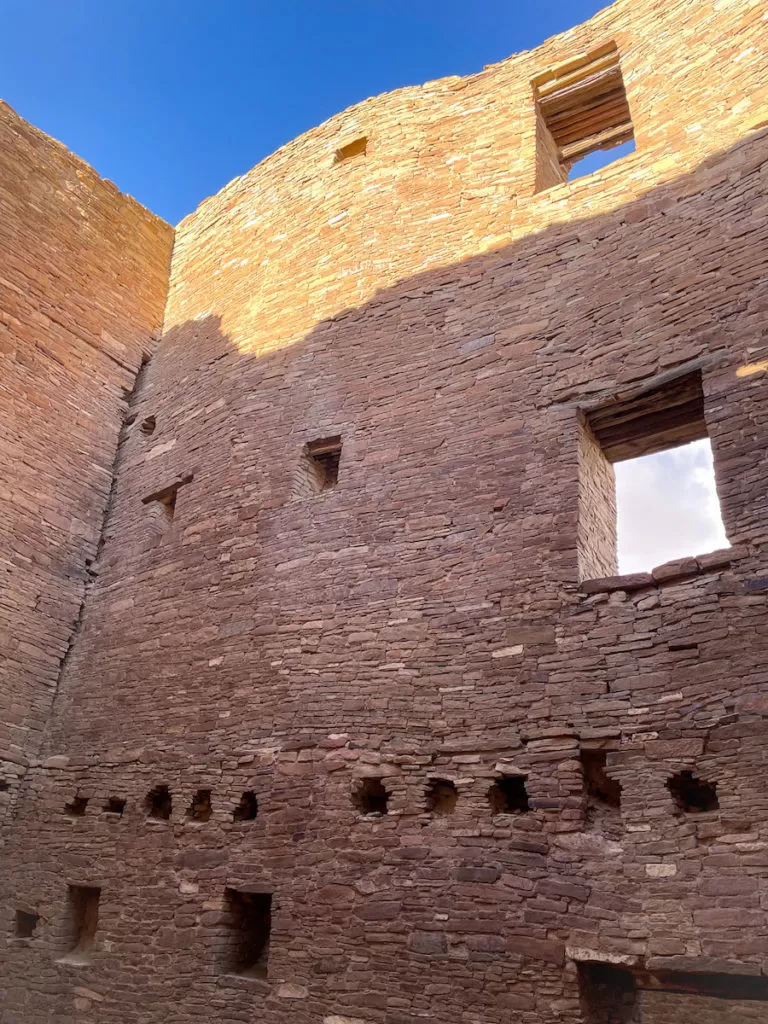
The highlight of any Chaco Canyon visit, Pueblo Bonito, is the most famous of the Chacoan great houses. Built between AD 828 and 1126, it is the most thoroughly investigated site in the canyon.
With over 650 rooms and 35 kivas, it was the center of the world for the Ancestral Pueblo people. It had many roles, including ceremonial, administrative, and astronomical center, trading, storage, hospitality, communications, and burial of the honored dead. A small portion also served as living quarters.
The famous great house is divided into two sections by a perfectly aligned north to south wall running through the central plaza. Two Great Kivas sit on the two sides of this wall, in a symmetrical pattern. Besides the Great Kivas, over thirty other kivas and ceremonial centers pepper the large central courtyard.
Besides the kivas, the highlight of your visit is most likely the multi-story structure you can walk into, explore its separate, interconnected rooms, inside and out.
Considering it is the largest site, you will most likely spend the longest time here. If you end up here during midday, the shaded rooms inside the structure offer respite from the harsh high desert sun.
The trail through Pueblo Bonito is only a quarter of a mile long, but exploring the structure adds time to the visit – and makes it a lot more fun. Doorways are low though and some are narrow, but anyone can fit through. Of course, kids will have the most fun in there, but everyone can enjoy these rooms.
You’ll also find a corner window in one room, built so the sun can shine through during the solstices.
Kin Kletso And The Sites On The Mesa Top
Though not part of the nine-mile loop, if you continue along the road without crossing the bridge over Chaco Wash, you end up in another parking lot. From here, several trails lead to the more remote sites in the park.
To hike to these sites, you need a permit or at least to sign in at the trailhead, showing how many hikers are in your party. Depending on how much time you have, and how much hiking you plan on doing, you can skip this area, and continue along the loop to the next stop, Casa Rinconada.
However, if you plan on spending a full day at Chaco, you have time to explore some ruins in this area.
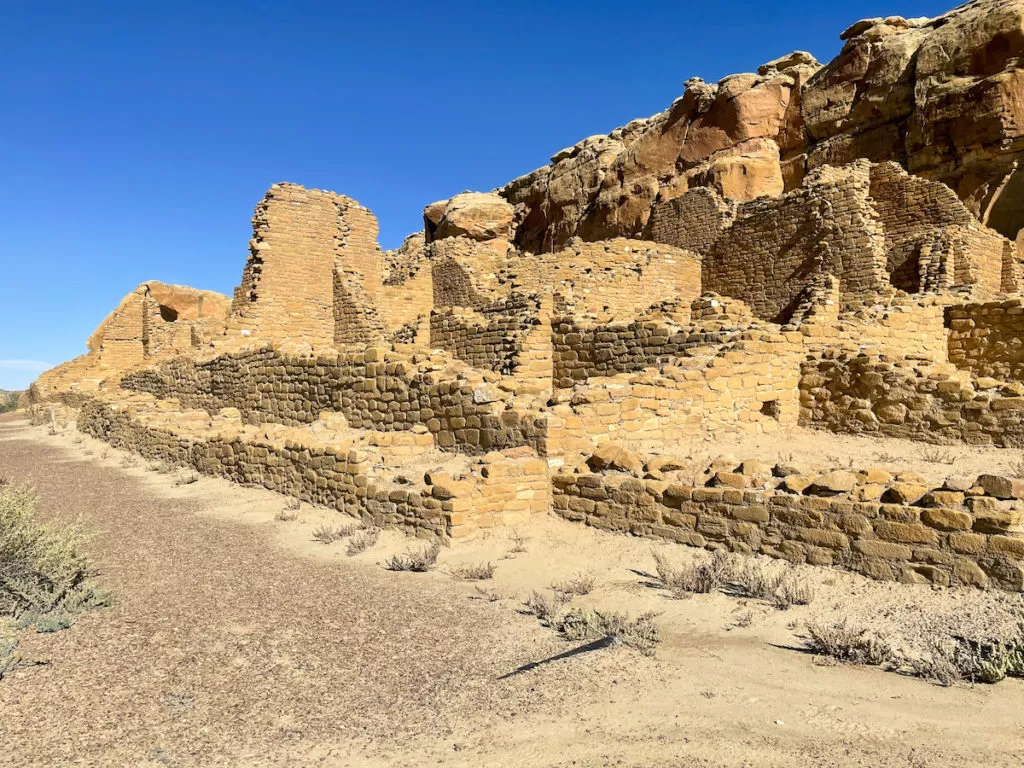
A compact, rectangular unit, Kin Kletso is smaller than the previous great houses. Built later in the Chacoan timeline, between 1120-1130, it lacks most of the features like the great kivas and enclosed plaza like the earlier great houses of Chaco.
You can walk around the building, then look for the trail leading to the mesa top – if you signed in and can do the hike.
Mesa Top Trails

To get to the mesa top, you’ll follow the trail that starts with a vertical climb through boulders and a narrow opening between the canyon walls. Though not an easy hike, it’s not impossible to do – and can be fun in some areas – especially for younger people.
At the end of this climb, you reach the mesa top that offers some of the best views of Chaco Canyon, Klin Kletso, and at the end of another half-mile trail, of Pueblo Bonito.
The hike is worth it for the views of Pueblo Bonito, but the trail leads farther up to several other sites.
Pueblo Alto and New Alto

Another Chacoan great house, built on the mesa top, Pueblo Alto housed a smaller number of people. However, archaeologists believe it hosted larger groups who traveled to Chaco for ceremonies.
Following the trail on the mesa top towards Pueblo Alto and New Alto, you’ll pass near a Chacoan road and a stairway.
The sites themselves are not as spectacular as the ones below in the canyon. The highlight of this side-trip is the actual hike up to and on the mesa top.
Pueblo del Arroyo
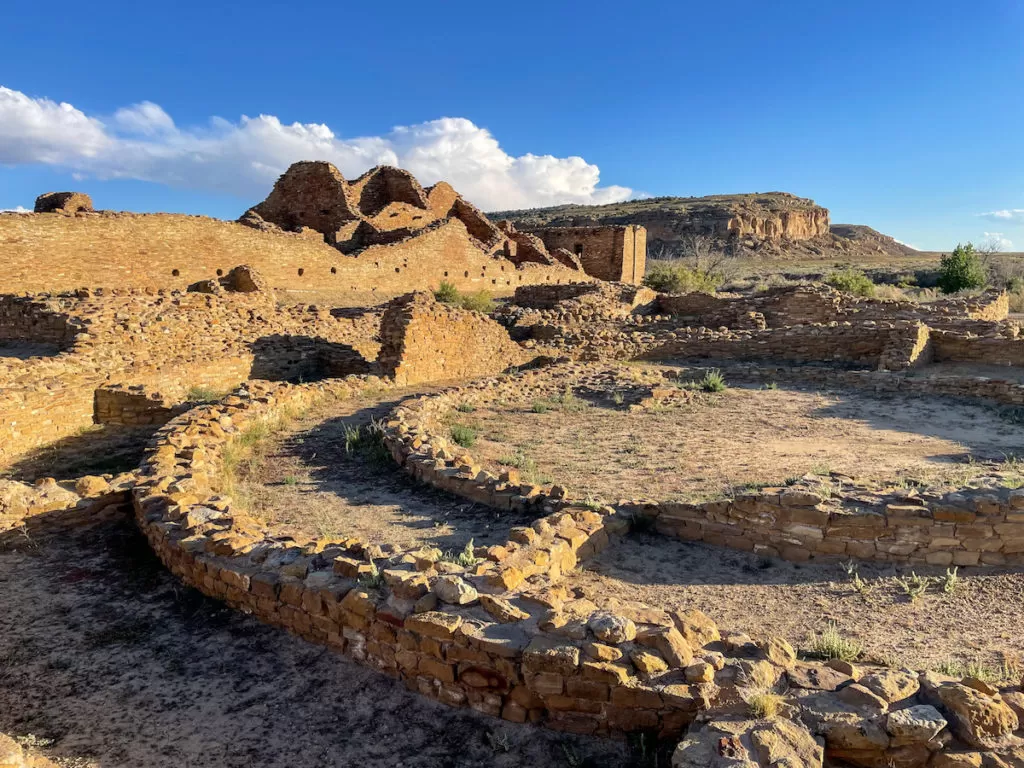
Before getting back onto the nine-mile loop trail, you can explore Pueblo del Arroyo, from the same parking lot you took the hike from.
Another Chacoan Great House, Pueblo del Arroyo, sits on the edge of the riverbed. Occupied between 1075 and 1250, it has all the features of the other great houses in the canyon: enclosed walls with kivas within, and multi-story high rooms.
However, the interesting part of this site is the arroyo, the riverbed on its edge. Though I haven’t seen water in it (yet) during any of our visits, a seasonal river still flows in it, making it greener than the surrounding area.
The trail through Pueblo del Arroyo is 1/4 mile long round-trip.
Past Pueblo del Arroyo, you make your way back on the other side of the one-way loop.
Casa Rinconada and the Largest Great Kiva in Chaco
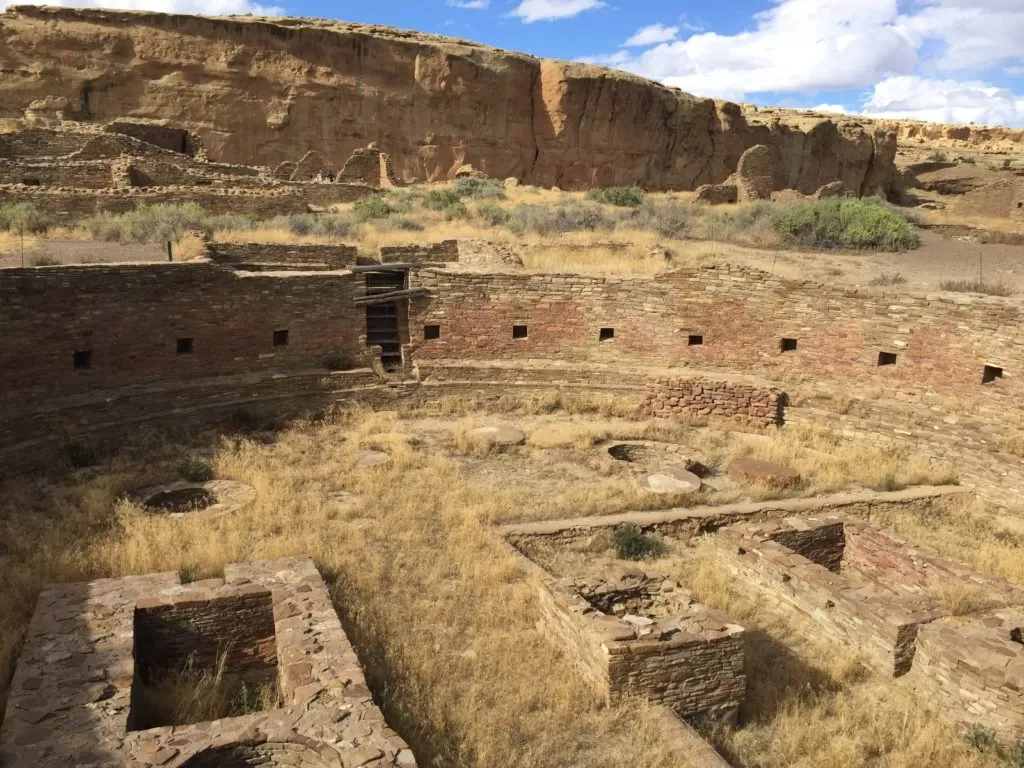
The Casa Rinconada Chacoan Great House featuring the Great Kiva is the next stop along the loop. The trail leads forks and leads to either the house structure or the Great Kiva. The largest kiva in Chaco Canyon, the Great Kiva, has a diameter of 64 feet.
A kiva is a large, circular structure, used by the Pueblo people for ceremonies and political gatherings. Great kivas differ from ordinary kivas not only by size – they are generally much larger – but also by several distinctive floor features. They have “foot drums” and artifacts like large serving bowls that reflect communal feasting. (definition from Crow Canyon Archaeological Center’s website ).
After walking to the Great Kiva, you can take the connecting trail to the Casa Rinconada great house. Or just enjoy it from afar, especially if you are there at sunset.
Learn About The People Of Chaco Canyon
Since you are exploring the structures they built so long ago, it is natural to learn about the people who once lived in Chaco Canyon.
Although, I’m sure if you make the trip, you know about them – and the site – beforehand, and it’s the reason you are there. But if not, the best way to learn about the people who built these structures and lived here for an extended period is at the Visitor Center.
The Museum offers a great overview of the landscape and its people. But I found the short film they play answers even more questions, since it looks at the history of Chaco not only from an archaeological perspective, but from the perspective of the descendants of those who built it.
The Chacoans didn’t “mysteriously disappear”
For many years, archaeologists were guessing why the people of Chaco left the city they built. Yes, a long drought and depletion of resources influenced their timing. But they never intended to stay there forever.
It wasn’t until archaeologists and anthropologists started working with the descendants of the people of Chaco that a clearer picture emerged.
According to the Hopi, one of their descendant nations, Chaco was only a stop on their migration to the center they were seeking.
I loved the analogy of the clouds they used. One of them said that people are meant to move like the clouds. Clouds never stay too long in one place, and it is the same with the people.
Sometimes, if they find the right place, they may build cities and stay for longer, even a few centuries, like the huge thunderclouds that can linger above a landscape for a while. But eventually they move on.
That’s what happened to the Chacoans, they say. It was time for them to move on. Different clans went in different directions, and those who became the Hopi, moved onto the Hopi mesas.
Still, Chaco is a sacred land for them all. It’s part of their history. But they don’t mind sharing it with the rest of the world. After all, places should be experienced by anyone who walks through. However, we, all visitors, need to respect their history, should treat the site as sacred.
The National Park System acknowledges this, and the latest signs reflect it. All the trailheads have signs designating them as Sacred Sites, asking visitors to treat them with respect.
Who Were the Chacoans?
Archaeologists used to call people who lived here the Chacoan Anasazi. The name originated from Navajo, meaning “the ancient ones”.
The Navajo, whose tribal land surrounds Chaco, migrated into the area long after Chaco was abandoned. Since they didn’t know who built the structures, they called them “the ancient ones”, Anasazi, a name archaeologists adopted.
Eventually, they found out that the ancient people of Chaco were the ancestors of the present-day Pueblo people . To reflect this, and honor the relationship, the name we use for the people who built the ancient structures in Chaco Canyon is Ancestral Puebloans .
How ancient people built a civilization in Chaco
Chaco Canyon was a good place to settle in ancient times. In the middle of a high desert where not much grows, Chaco Wash offered enough water for the survival of large groups.
The first evidence of people living here dates back 4000 years, although they built nothing lasting until 400-500 AD. That’s when the first pit houses originate from. Around the end of this period, they also built more centralized structures.
However, it was the 9th when the area went through the biggest growth and transformation. This is when they started building the Great Houses, the remains of which we see today. They are such a distinctive feature of Chaco Canyon, archaeologists call it the Chacoan Phenomenon.
They continued the tradition of building these Great Houses for the next 250 years. During this time, they also built dams, canals, and a road system. They established trade routes with other cultures from the Southwest and Mesoamerica.
They built outlier communities, like Aztec , and even farther, Chimney Rock , among others. People from these outlier communities came to Chaco for special events and ceremonies, establishing the site as a cultural, political, and ceremonial center.
But this only lasted til around 1150, when Chaco started losing its importance as a center, and eventually its people left.
Where Did The Chacoans Go?
Different clans from Chaco moved in different directions.
In the Museum of the Visitor Center you’ll find an exhibit of Chaco’s name and its meaning for all the modern Pueblo nations, and several Navajo clans, that trace their lineage back to Chaco. If you count, you’ll find 26 of them. They live throughout the Four Corners, in the regions surrounding Chaco in all directions.
In the stories of most of these nations, Chaco was an important stop along their migration. These are the stories of the Hopi, Zuni, Acoma, Tewa, Laguna. For others, it is simply the place of their ancestors.
Some of these nations, specifically the Hopi that I know of, still hold pilgrimages to Chaco to continue their connection with their ancestors.
Honoring these histories should be part of each visitor’s journey through Chaco. We might enjoy the ancient structures, but it is the history behind it that gives them meaning. Adding an understanding of the history their descendants tell makes our experience richer.
Dark Skies In Chaco
Chaco Culture National Historical Park is an International Dark Sky Park , with its own observatory, built in 1998. The park offers night sky programs from April through October, that start with staff presentations on archaeoastronomy, cultural history, and other topics, followed by telescope viewing of celestial objects.
If you really want to enjoy the night sky in Chaco, you can camp at the site – in the summer months.
Practical Tips For Visiting Chaco
Where to stay.
Besides camping, you won’t find other lodging in the park. The closest towns are at least an hour away, so you need to plan accordingly.
You’ll find a selection of hotels in Aztec (69 miles away), Farmington (74 miles away), or Gallup (94 miles away).
Though it is the farthest, we often use Gallup as a starting point – at least when we visit Chaco on a weekend. Gallup also seems to have the largest selection of hotels for all budgets. We also found that highway driving for part of the way makes up the distance.
Bring your own food
No matter where you spend the night, you need to bring your own food when visiting Chaco. The park has no restaurant or grocery store, so make sure you have enough food. The visitor center has a store, but you’ll only find snacks there. You can fill up your water bottle at the refill station in the Visitor Center, but bring enough to get there.
Hiking in Chaco
Remember that you are in the high desert, where the sun can be extremely strong, especially in the summer. You will also find little shade at the structures, and none on the trails, so plan accordingly. While exploring any of the ruins, make sure you carry water and wear a hat and sunscreen.
Wear comfortable shoes, no matter how long you plan on hiking.
For best views and pleasant temperatures, consider staying until sunset, even if you have a long drive back.
If it’s your first time here, consider joining a guided tour, offered from May to October. Check the park’s website for times and availability.
FAQ – Facts about Chaco Ruins In a Nutshell
What is chaco canyon known for.
Chaco Canyon is known for its extensive ancient ruins, especially its Great Houses, unique to the region that originated here. The ancient city in Chaco Canyon was once the most important cultural, religious, and political center of the Four Corners area of the US Southwest.
What are the Chaco Ruins?
The Chaco ruins comprise the largest concentration of ancient Pueblo sites in Chaco Canyon, best-known for their “great houses”. These Great Houses comprise large multi-story structures and include several kivas. The largest and most famous of them is Pueblo Bonito.
What is Chaco Culture National Park?
A World Heritage Site, Chaco Culture National Park is a US National Park protecting Chaco Ruins, the largest concentration of ancient pueblos in the American Southwest.
What does Chaco mean?
According to the National Park Service site, Chaco is derived from the Spanish colonial word “Chaca”, meaning a large expanse of open and unexplored land. The name was first used by Spanish cartographer Bernardo de Miera y Pacheco on a map he drew of the area in 1778. Other explanations they cite have to do with misunderstood or mispronounced the place name the Acoma used for Chaco. The Acoma name for the area is W’aasrba shak’a, meaning “place of greasewood”, which might have been shortened and mispronounced as chaca. The Hopi name for Chaco is Yupkoyvi, meaning “the village beyond the horizon.”
Why are the ancient ruins of Chaco Canyon important?
The Chaco ruins are the remains of an important cultural, religious, political, and astronomical center in the Southwest. Many of the buildings are aligned to showcase solar and lunar cycles and astronomical events. Besides this, a large concentration of ceremonial kivas proves the site’s cultural and religious importance.
Who were the ancient people that lived in Chaco Canyon?
Called Ancestral Puebloans, the people who lived in Chaco Canyon and built the structures we see there were the ancestors of the present-day Pueblo nations and several others.
When did the Ancestral Puebloans live in Chaco?
Though they lived in the area earlier, the timeframe known for the Ancestral Puebloans living in Chaco was between 900 and 1150. This was the time Chaco was the most important cultural, political, and religious center in the Four Corners.
Where is Chaco Culture National Park?
The ancient ruins of Chaco and Chaco Culture National Park are in the Navajo Nation, in the state of New Mexico, in the Four Corners region of the US Southwest.
What are the closest towns to Chaco?
The closest towns to Chaco are Farmington (72 miles away) and Gallup (92 miles).
How to get to Chaco Culture National Park?
You can only reach Chaco Culture National Park through dirt roads, from two different directions. You’ll drive 20 miles on a dirt road, most of it passable even by car in good weather. It always helps to drive a high-clearance vehicle, though.
Where to stay when visiting Chaco Canyon?
The best way to experience Chaco Canyon is by camping in the National Park; the campground offers sites in the shadow of a cave dwelling. Besides staying in the proximity to the ruins, camping in the park offers the best views of the night sky, since Chaco is a Dark Sky Park. It also has a small observatory near the Visitor Center that might open during some nights. If you are not a camper, you can find hotels for every budget either in Farmington (72 miles away) or Gallup (91 miles).
Bibliography:
Besides learning about the ruins of Chaco in the park, during many trips to the site, my knowledge is also based on my readings over the years. The following are only a few of them:
- Pueblo Bonito, Center of the Chacoan World, Edited by Neitzel, Jill E., Smithsonian Institute, 2003
- Chaco. A Cultural Legacy. Chaco Culture National Historical Park, Strutin, Michal, Western National Parks Association, Tucson, Arizona, 1994.
- Lister, Robert H and Florence C, Chaco Canyon. University of New Mexico Press, Albuquerque, 1981; Fifth printing: 1997
Though some of the information might be outdated in the older editions, you can find newer editions of the same, reflecting more recent studies. Though I don’t own the newer editions, I have read most of the additions to them.
About Chaco’s outlier sites:
Aztec Ruins
Chimney Rock
Edge of the Cedars
Escalante Pueblo in Canyons of the Ancients
and other Ancient Ruins in the Four Corners area
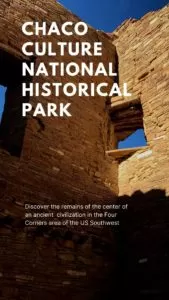
- Skip to global NPS navigation
- Skip to this park navigation
- Skip to the main content
- Skip to this park information section
- Skip to the footer section

Exiting nps.gov
Alerts in effect, plan your visit.
Last updated: February 12, 2024
Park footer
Contact info, mailing address:.
PO Box 220 Nageezi, NM 87037
505 786-7014
Stay Connected
- Skip to primary navigation
- Skip to main content
- Skip to primary sidebar

Chaco Culture Conservancy
A New Mexico nonprofit 501(c)(3) organization created to assist and support Chaco Culture National Historical Park and Aztec Ruins National Monument
Chaco Culture National Historical Park: Center of Chacoan Culture

Chaco Culture National Historical Park is a unique cultural place, designated as a UNESCO World Heritage Site. Chaco Canyon was the center of a thriving ancestral Puebloan culture a thousand years ago. The monumental scale of its architecture, the complexity of its community life, the high level of its community social organization, and its far-reaching commerce created a cultural vision unlike any other seen before or since.
The cultural flowering of the Chacoan people began in the mid 800s and lasted more than 300 years. The great houses of Pueblo Bonito, Una Vida, and Peñasco Blanco were constructed in the mid-to-late-800s, followed by Hungo Pavi, Chetro Ketl, Pueblo Alto, and others. These structures were often oriented to solar, lunar, and cardinal directions, and lines of sight between the great houses allowed communication. Sophisticated astronomical markers, communication features, water control devices, and formal earthen mounds surrounded them. The buildings were placed within a landscape surrounded by sacred mountains, mesas, and shrines that still have deep spiritual meaning for their descendants.
By 1050, Chaco had become the ceremonial, administrative, and economic center of the San Juan Basin. Its sphere of influence was extensive. Dozens of great houses in Chaco Canyon were connected by roads to more than 150 great houses throughout the region. Pueblo descendants say that Chaco was a special gathering place where many peoples and clans converged to share their ceremonies, traditions, and knowledge. Many Southwest Indian people look upon Chaco as an important stop along their clans’ sacred migration paths – a spiritual place to be honored and respected. This long and unique history is one reason why Chaco Culture National Historical Park was named a UNESCO World Heritage Site in 1987.
Explore more

Chaco Canyon Adventure
Explore the UNESCO World Heritage Site of Chaco Culture National Historical Park in northwest New Mexico. Marvel at the thousand-year-old, resilient architecture of Chaco Canyon, where the Ancestral Pueblos showcased their exceptional engineering skills in designing Great Houses with celestial alignments over vast distances. This iconic location continues to hold deep significance for modern indigenous communities, keeping their ties alive through kinship and sacred ceremonies.
Chaco Culture NHP - archaeoastronomy
Story - local history, indigenous knowledge
Guided routes - 2.5-kilometers, 5-hrs, Pueblo Bonito, Chetro Ketl, and more!
Small groups - maximum of 10-12 people, enjoy an authentic experience
Booking - full deposit required
Start/end - meet at Visitor Center parking lot, or at scheduled meet-up location
Pricing List
Maximum 10-12 people per tour
Six years and under FREE
BOOK NOW SUBSCRIBE


Best of the Southwest: Escape to Chaco Canyon
Kate Siber, a Durango, Colorado-based writer, has reported five feature stories on the best trips of the Southwest for National Geographic Adventure. Her most recent, “ Best of the Southwest ” highlights 14 winning new journeys. Here she shares some notes from the field.
After nearly eight years living in the Southwest, I finally made it to Chaco Canyon, the mother of all ancient Indian sites, on an impromptu getaway. It’s only a two-hour drive from my home in Durango, but my friend Danielle and I arrived to find a dry, monochromatic, lunar landscape, as if we had somehow traveled between planets rather than states.
Formally dubbed Chaco Culture National Historical Park, it can only be accessed by a rough dirt road, which scares away tour buses and pansy drivers, keeping annual visitor numbers down to a scant 50,000-70,000. (Compare that to Zion at about 2.5 million.) And yet Chaco has an unparalleled ability to inspire the imagination. Archaeologists believe that it was a ceremonial center for the entire four corners region because of the unique artifacts they found there, like wild jewelry, exquisite jet-and-turquoise ornaments, and colorful macaw feathers, presumably traded from Mexico. But no one knows the whys and hows of that place with certainty except for what we can see: a veritable metropolis of stone ruins, some three stories high with hundreds of rooms and intriguing astronomical alignments.
Danielle and I poked about several ruins sites, including Pueblo Alto, a 3.5-mile hike from the road. Sitting there in solitude amongst the centuries-old walls made of delicately stacked and mortared stones, we imagined the spirits of the original inhabitants lingering about. The spring wind wailed through the ancient windows—a delightfully spooky effect.
We happened to be there on an evening when the park offered an astronomy talk at its observatory, equipped with a 25-inch-diameter telescope. A tall, white-bearded ranger named G.B. Cornucopia narrated a slide show of the curious astronomical alignments among the many structures. “We don’t know for sure what any of this meant,” he said, noting that there were no written records left behind. “They could all just be extraordinary coincidences.” He smiled, leaving room for interpretation.
- Nat Geo Expeditions
After spotting craters on the moon’s surface and Saturn’s rings and moons through the telescope, Danielle and I lingered. I’m incorrigibly curious, and both Mr. Cornucopia and the visiting astronomer, a retired professor, indulged my endless questions. Until the wee hours, they explained their own theories as to why the Chacoans lined up their buildings with the solstices and why a certain petroglyph might depict a supernova that burned as bright as the sun in 1054 and that the Chacoans surely witnessed. They explained black holes, the red limit, and other phenomena that lie beyond the confines of our comfortable earthly atmosphere.
Contemplating the night sky and the doings of those who came before us in a wild, remote location always has the unique effect of making me feel both very small and very miraculous. I become overwhelmed with the improbability of it all, and it’s a feeling to which I’m now genuinely addicted. It’s also precisely why I live in the Southwest. Year after year, I can still find new, wild, beautiful places that remind me that I am wonderfully small and the world is wonderfully big. Still, after eight years, there’s always something new to do, something new to learn, someplace new to explore. There's always some other corner of these American hinterlands calling my name.
Related Topics
- Best of the World
- Environment
- Paid Content
History & Culture
- History & Culture
- Out of Eden Walk
- Mind, Body, Wonder
- Here Not There
- Terms of Use
- Privacy Policy
- Your US State Privacy Rights
- Children's Online Privacy Policy
- Interest-Based Ads
- About Nielsen Measurement
- Do Not Sell or Share My Personal Information
- Nat Geo Home
- Attend a Live Event
- Book a Trip
- Inspire Your Kids
- Shop Nat Geo
- Visit the D.C. Museum
- Learn About Our Impact
- Support Our Mission
- Advertise With Us
- Customer Service
- Renew Subscription
- Manage Your Subscription
- Work at Nat Geo
- Sign Up for Our Newsletters
- Contribute to Protect the Planet
Copyright © 1996-2015 National Geographic Society Copyright © 2015-2024 National Geographic Partners, LLC. All rights reserved
Discovering Hidden Gems
Chaco Culture National Historical Park: Things To Do (2024)

Want to know how to see all of Chaco Culture in just one day? We’ve got you covered with everything we know from our day trip!
Chaco Culture National Historical Park, also known as Chaco Canyon, is a 1,000+ year old UNESCO World Heritage Site in northwestern New Mexico.
It’s a collection of ruins built by the Ancestral Puebloans that inhabited this region from about 900 AD to 1150 AD .
It can all be visited in just one day and is an easy day trip from places like Farmington, Gallup, Durango, and some other nearby tourism spots.
When we visited Chaco Culture, it was part of a larger road trip around New Mexico .
We had spent the previous night in Farmington after spending the day at Aztec Ruins National Monument , so the drive in was only about an hour and a half.
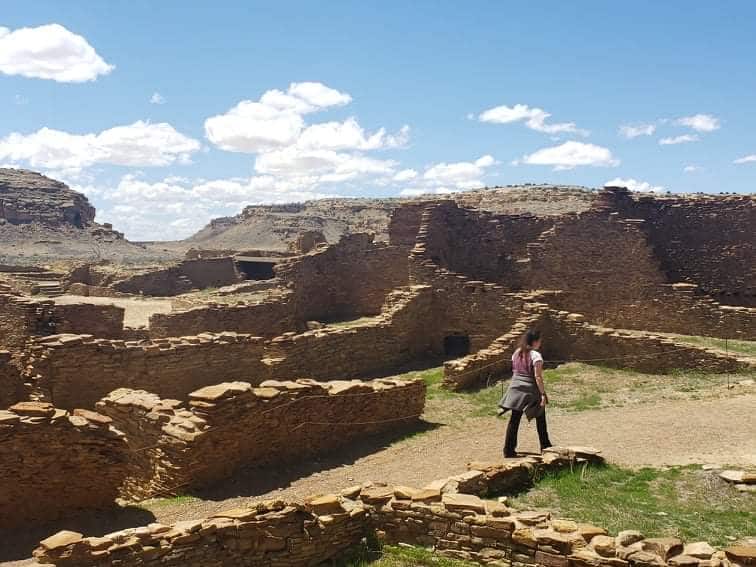
Planning A Trip? Use Our Favorite Resources Below!
Accommodations Tours/Experiences Flights Car Rentals
Chaco Culture National Historical Park
If you’re taking a trip to New Mexico or anywhere near the Four Corners, I highly recommend adding Chaco Culture to your itinerary.
The ruins here are well preserved, so you can go inside many of them and explore many rooms throughout the site.
This site is quite large and requires a little bit of driving to get to each place along the route, but it’s only a 9 mile loop in total.
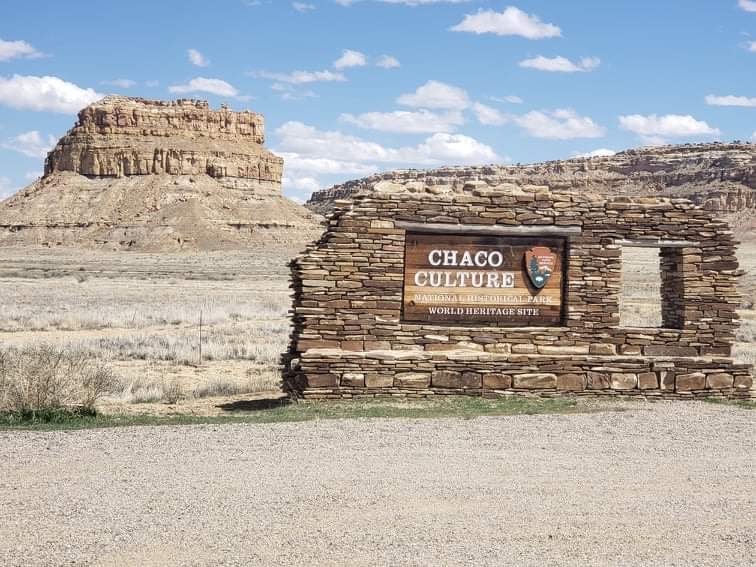
Things To Do At Chaco Culture
When driving to Chaco Culture National Historical Park, the first place you’ll come across is the visitor center.
From there, you can follow the loop drive to each of the pueblos that are still intact.
You can also participate in ranger programs or the junior ranger program if you have kids traveling with you, depending on the time of year.
There’s even a more modern day cemetery just beyond one of the pueblos.
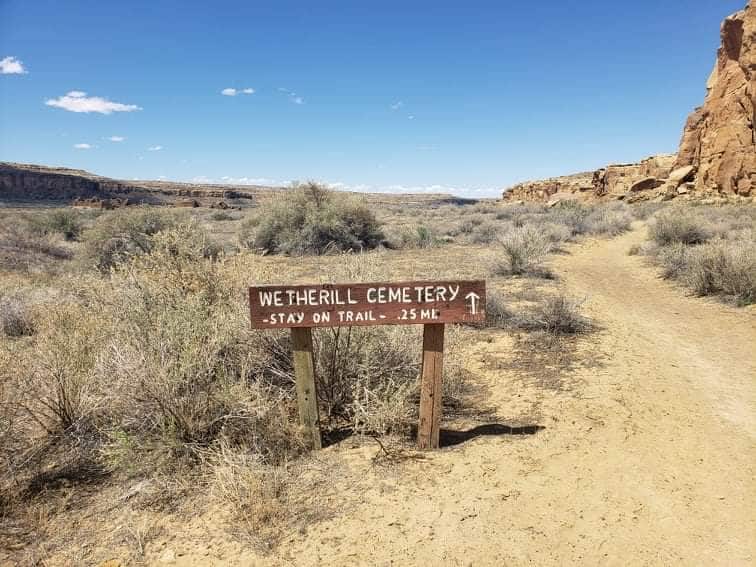
1. Visitor Center
You always want to stop at the visitor center first when visiting national park sites .
After the long drive in, it’s a good idea to stop for a bathroom break here, as well as get a map of the park, get a stamp in your national park passport, and ask the rangers any questions you have.
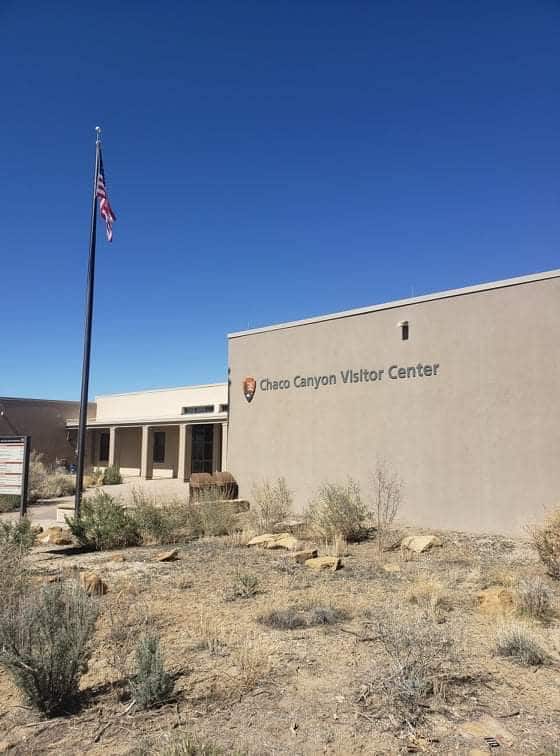
2. Museum & Movie
At the visitor center there is also a small museum with artifacts that have been excavated around the Chaco Culture site.
You can also watch a 26 minute film about the site.
We personally like to do these things before heading out and exploring the park because it gives us more information and context to what we’re about to go see.
But if you wanted, you could always do this part last.
The beauty of this park is that it all follows a loop, so you can start and end wherever you’d like.
3. Una Vida
The first set of ruins to explore are just beyond the visitor center parking lot.
There is a 1 mile round trip trail that takes you to this “great house”.

You may also begin to see some of the petroglyphs that are found all throughout the park.
Plan to spend about 45 minutes here on this trail.
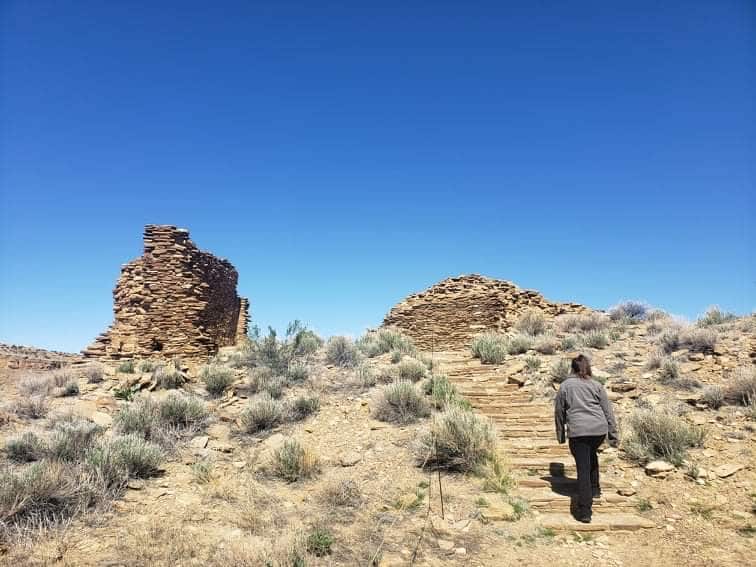
4. Hungo Pavi
To get here, you’ll get back in your car that’s parked at the visitor center.
You’ll drive about 2 miles along the 9 mile loop drive.
The trail here is only .25 miles round trip .
Hungo Pavi is another “great house” site, but this one has not been excavated like the previous one, so it looks a little different.
Plan to spend about 30 minutes at this stop.
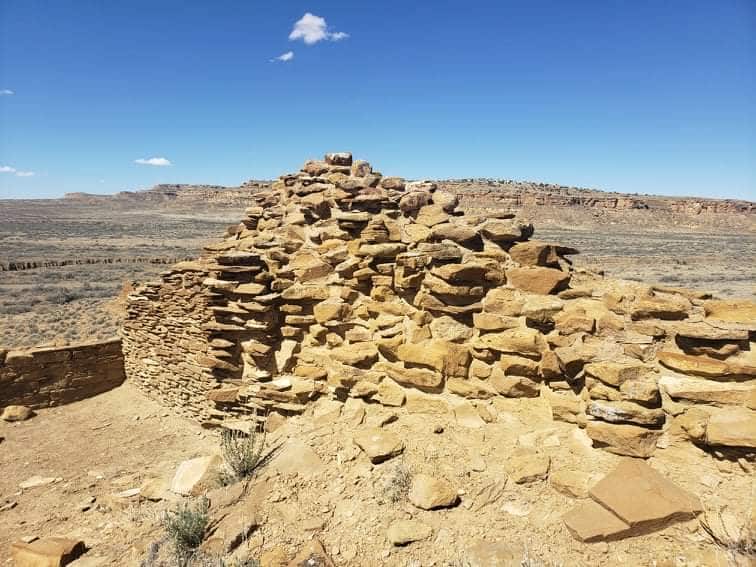
5. Chetro Ketl
Another 2 1/2 miles on the 9 mile loop drive is Chetro Ketl.
The trail here is about half a mile round trip , but you’ll want to plan to spend about 45 minutes here to explore the ruins.
This is the second largest great house at this site, with many rooms to explore.
If you only do a few stops on the full loop, this has to be one of them.

6. Petroglyph Trail
Along the rock wall connecting Chetro Ketl to Pueblo Bonito is the petroglyph trail.
This trail is about a quarter mile long.
If you want to take time to look at the various petroglyphs, you’ll want to plan to spend about 30 minutes walking along this trail.
Depending on the time of day and how the sun and shadows are hitting the wall, some petroglyphs are easier to see than others.
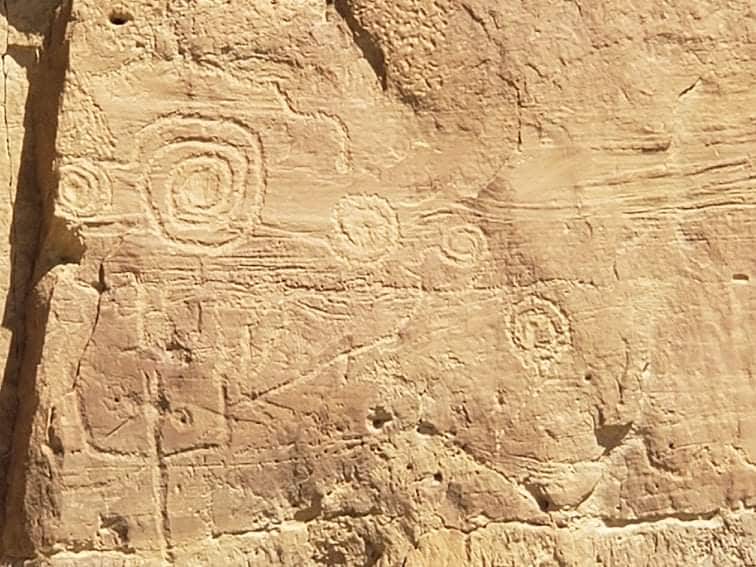
7. Pueblo Bonito
This was definitely my favorite spot in the whole park and it’s the #1 most recommended place to go in the park.
It’s right next to Chetro Ketl, so you don’t have to travel far for this next stop.
The trail here is about half a mile round trip , but you’ll want to spend about 45 minutes to an hour exploring the ruins here because there’s just so much.
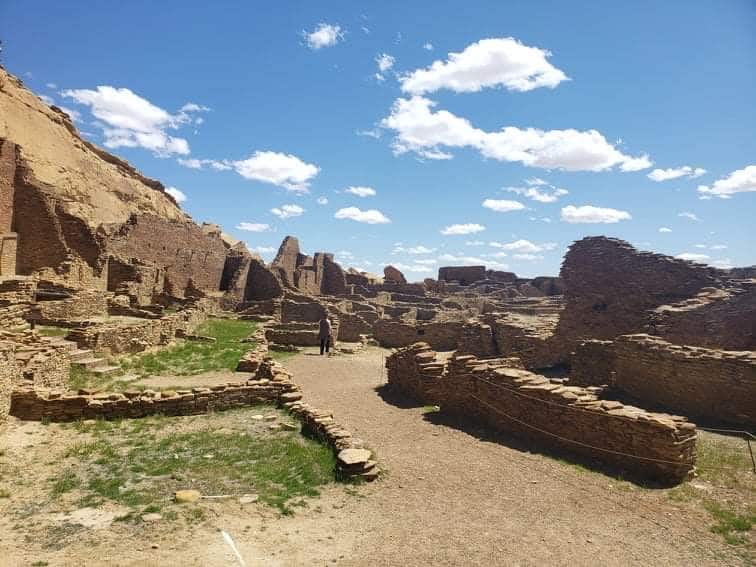
8. Casa Rinconada
Another 1.5 miles along the 9 mile loop drive is Casa Rinconada.
The trail through here is half a mile round trip and you’ll want to plan to spend 30-45 minutes here.
This site is also made up of smaller villages you can explore.
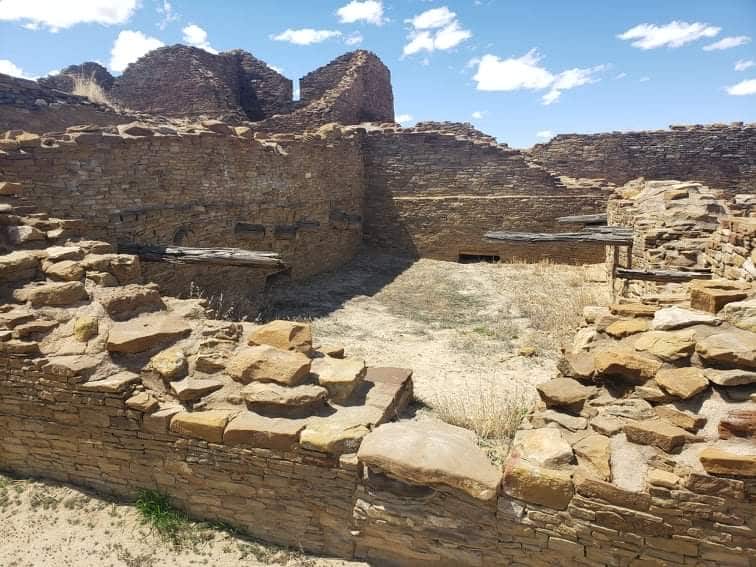
9. Pueblo Del Arroyo
About a half mile up the road is Pueblo Del Arroyo, the last stop on the 9 mile loop drive.
The trail here is 0.25 miles round trip and you can expect to spend about 30-45 minutes here.

10. Night Sky Programs
Back in the late 90s a permanent observatory was built by the visitor center.
Dark Sky designations are given to remote areas with clear, dark skies that have virtually no light pollution.
Generally from April through October they host night sky programs in the park on a variety of topics.
On solstices and equinoxes there are special sunrise programs, mostly at Casa Rinconada.
11. Junior Ranger Program
Each park that is part of the National Park Service system hosts junior ranger program activities.
Here, you’ll stop at the visitor center to pick up a booklet or worksheet.
You’ll have to go to the popular sites around the park to find all of the answers.
Once you’re done, you return your complete booklet to the visitor center and you’ll be rewarded with a badge.
The best part is that the junior ranger program is completely free!
Where To Stay Near Chaco Culture
There are not really any options in terms of hotels within about an hour of Chaco Culture National Historical Park, so you’ll have to drive to the nearest cities.
Depending on where this stop is fitting into your itinerary, you could go on to Farmington or Gallup from here.
✅ Camping at Chaco Culture
The Gallo Campground is just outside of the visitor center at Chaco Culture.
It’s open year round, except for on a few holidays.
Campsites are only $20 per night and they offer tent camping and RV camping sites.
You’re also able to just sleep in your car if you wanted to.
The campground has water and restrooms, but no showers and there is no shade.
✅ Farmington – Home2Suites by Hilton
When we did this trip we stayed at the Home2Suites by Hilton , which was built within the last 10 years.
Farmington is about an hour and a half north of Chaco Culture, but it’s closer to places like Aztec Ruins and Four Corners if you plan to have those in your itinerary.
We like these properties because it’s a little more space and amenities than a standard hotel room, but not as expensive as getting a hotel room with a separate bedroom.
Click Here To Book Your Home2Suites by Hilton Farmington Stay Today!
✅ Gallup – Hotel El Rancho
Hotel El Rancho is a historic hotel in Gallup, New Mexico that was built in 1937.
In general, we prefer to stay at Hilton hotels when we travel, but there’s a historic hotel or boutique property that is unique to the destination, then we like to stay at those too.
Gallup is about 2 hours south of Chaco Culture, but if you’re driving along Route 66 as part of your itinerary, then it’s not that far out of the way.
Click Here To Book Your Hotel El Ranch Stay In Gallup Today!
Frequently Asked Questions
These are the most frequently asked questions we see about visiting Chaco Culture National Historical Park.
Where is Chaco Culture National Historical Park?
Chaco Culture National Historical Park is located in northwest New Mexico.
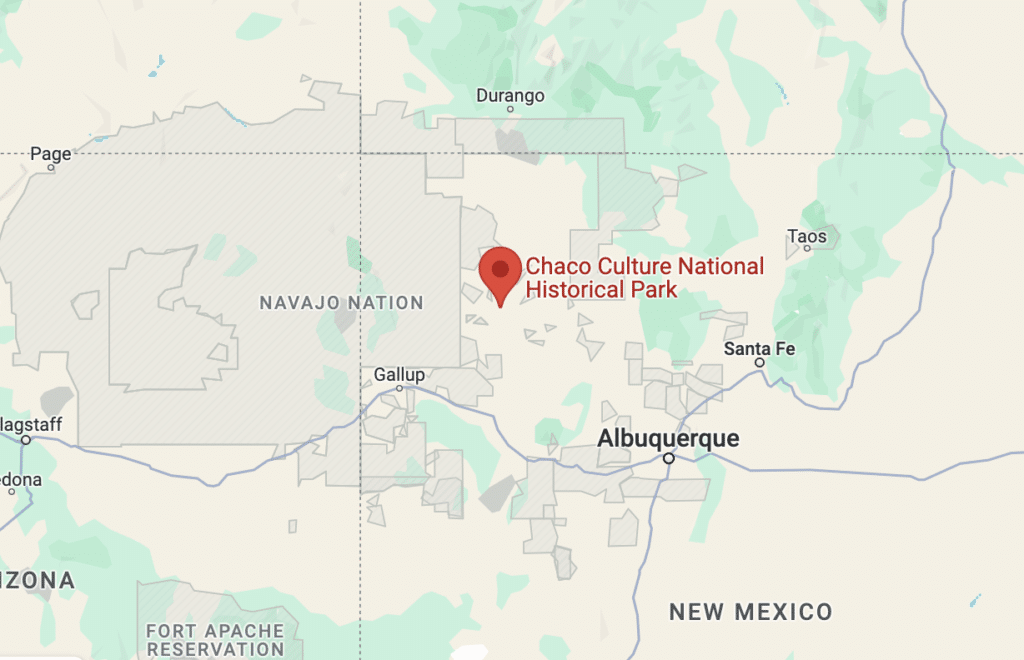
There are several places you could potentially drive in from, so here are some distances and driving times to get a good idea of how you might want to fit this into your itinerary.
- Aztec Ruins National Monument – 70 miles (1 hour 30 minutes)
- Gallup – 90 miles (2 hours)
- Durango – 104 miles (2 hours 15 minutes)
- Four Corners – 134 miles (2 hours 35 minutes)
- Albuquerque – 160 miles (3 hours)
- Santa Fe – 180 miles (3 hours 30 minutes)
- Tao s – 180 miles (3 hours 35 minutes)
The reason the driving time seems so much longer than it should compared to the distance you’re driving is that a huge portion of the drive in to the park is a very bumpy dirt road.
I think the speed limit is something like 25-30 miles per hour or even less depending on what your car can handle.
The picture below is actually from our drive leaving the park, but the roads are pretty similar.

What is Chaco Canyon?
Chaco Canyon is another term for Chaco Culture National Historical Park.
They are used interchangeably.
Why is Chaco Culture National Historical Park important?
Chaco Culture is a primary site for ancient Puebloan culture.
It served as a center for trade and ceremonies, in addition to being architectural marvels.
How much is it to get into Chaco Culture National Historical Park?
The entrance fee for each vehicle is $25.
If for some reason you’re walking through the middle of nowhere to enter the park, admission is $15 per person.
Motorcycles are $20 per vehicle.
If you have a National Park pass, that counts as your admission pass, so you won’t pay anything extra to enter.
There are some free admission days to national parks that are nationally recognized.
These days include:
- Monday, January 15 — Martin Luther King, Jr. Day
- Saturday, April 20 — First Day of National Park Week
- Wednesday, June 19 — Juneteenth
- Sunday, August 4 — The Great American Outdoors Act
- Saturday, September 28 — National Public Lands Day
- Monday, November 11 — Veterans Day
How long to spend at Chaco Culture National Historical Park?
If you want to spend the recommended amount of time at each spot along the 9 mile loop drive and visit the museum, you can expect to spend about 5 1/2 hours or so .
What happened in Chaco Canyon?
Chaco Canyon was actually abandoned long before most of the other ancient Puebloan sites.
To my knowledge there is no conclusive evidence of exactly what happened, but I have seen some sources say that it was due to new cultures moving through the area that had differing beliefs, which caused war to ensue.
Other sources think it is as simple as climate change forcing them out due a drought that lasted for over 50 years.
More Historic Places To Visit In New Mexico
Below are our favorite places we’ve explored all over New Mexico that we highly recommend.
✅ Aztec Ruins National Monument: The Ultimate Guide
In the eyes of UNESCO, which is the organization that designated Chaco Culture as a World Heritage Site , Aztec Ruins is included in the cluster of ruins in this area of New Mexico.
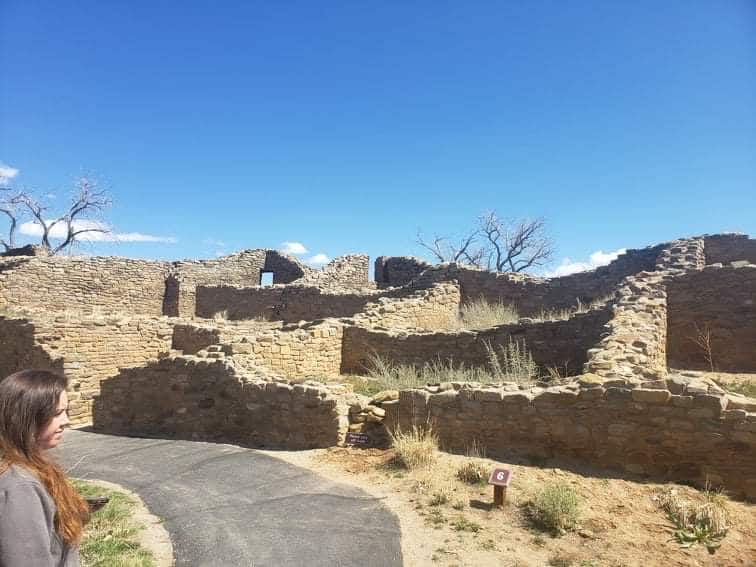
✅ Santuario de Chimayó
Santuario de Chimayó is a pilgrimage just 30 miles outside of Santa Fe.
The dirt here is said to have healing powers, so it draws hundreds of thousands of visitors per year, especially during Holy Week.

✅ Pecos National Historical Park
Pecos is just outside of Santa Fe.
It’s another hidden gem that most visitors to the area don’t go to, but it’s so worth visiting.
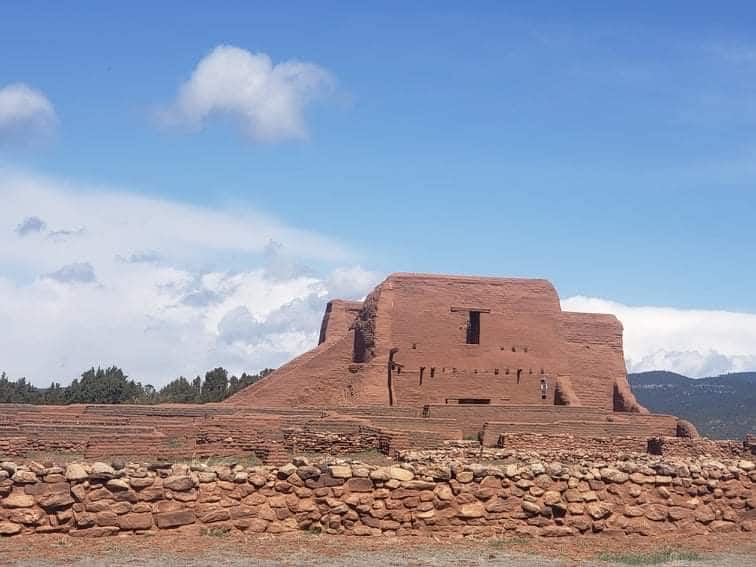
✅ Gila Cliff Dwellings
Over in Southwest New Mexico are the Gila Cliff Dwellings.
This place is so fun to climb around the caves and spend some time outdoors.
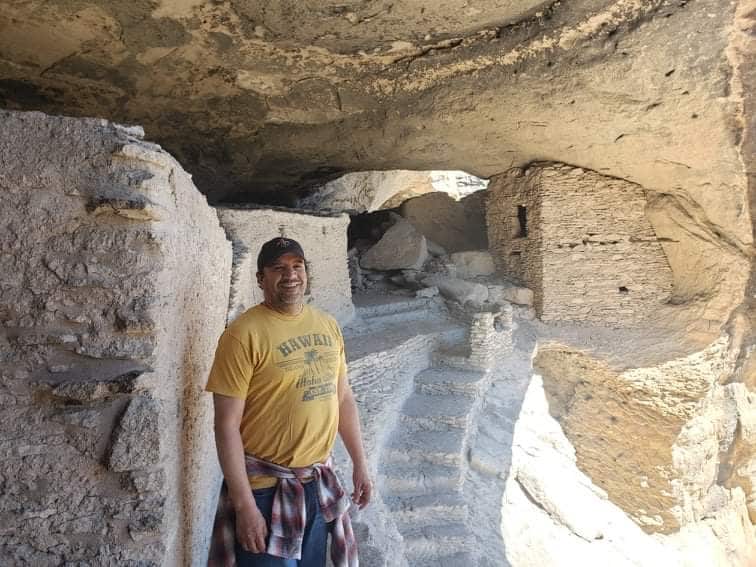
✅ Guadalupe Mountains To Carlsbad Caverns National Park
Over in Southeast New Mexico is Carlsbad Caverns National Park.
Just on the other side of the border is Guadalupe Mountains National Park, so these two make a perfect itinerary for a weekend getaway.
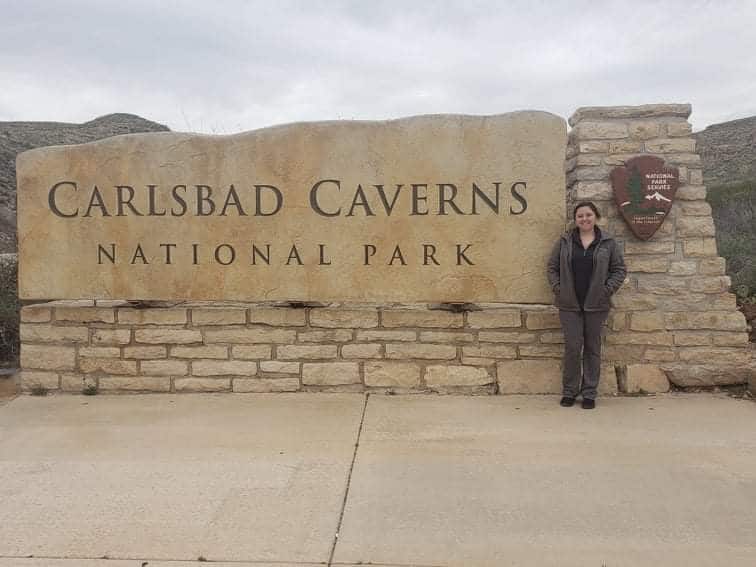
✅ The Best New Mexico Road Trip Itinerary
If you want to see all of the above plus a little bit more of New Mexico, I highly recommend this road trip itinerary.
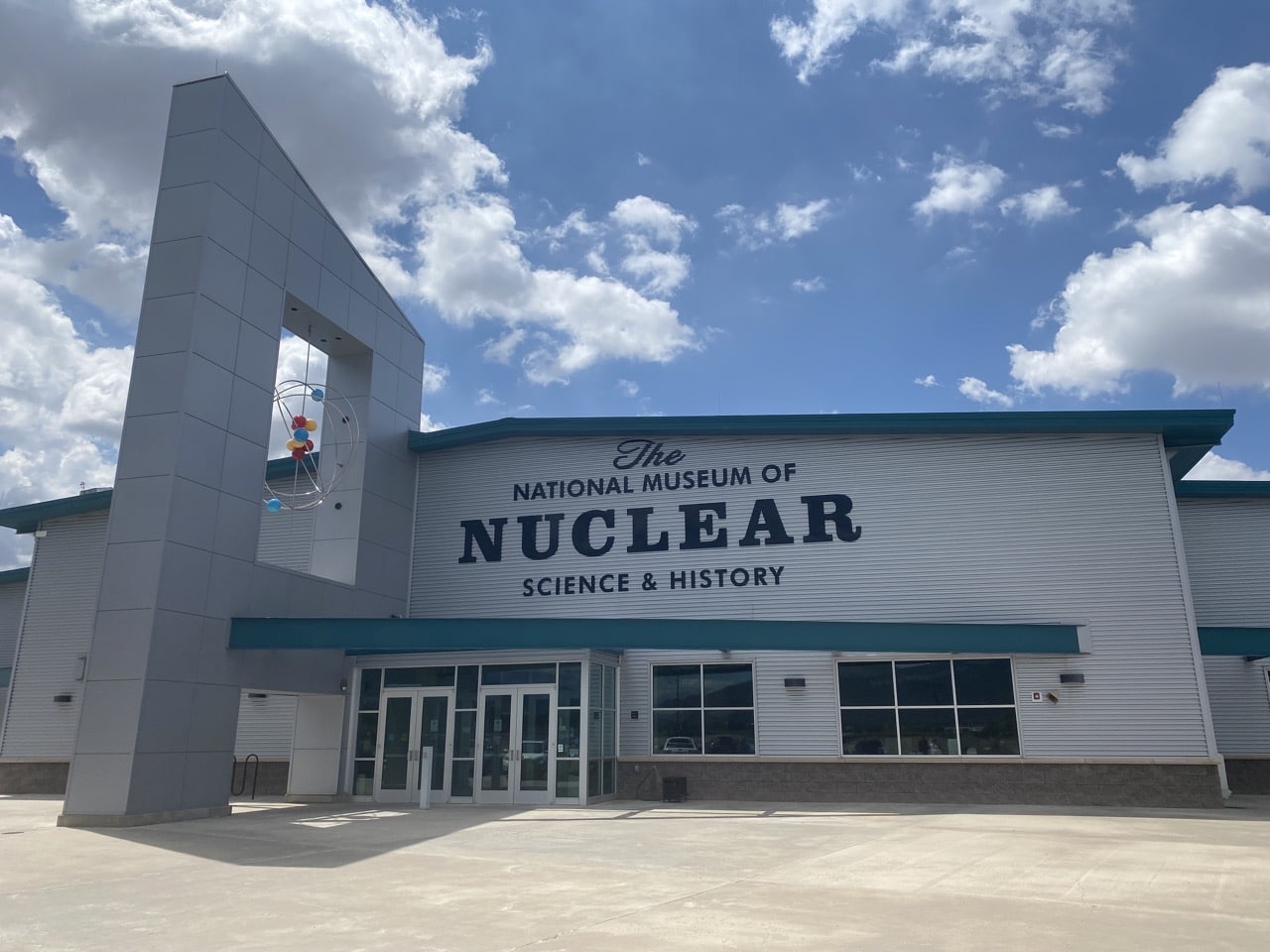
Conclusion: Chaco Culture National Historical Park
Chaco Culture National Historical Park is a wonderful hidden gem in the middle of nowhere New Mexico.
It’s a must visit if you’re road trip around New Mexico or near the Four Corners.
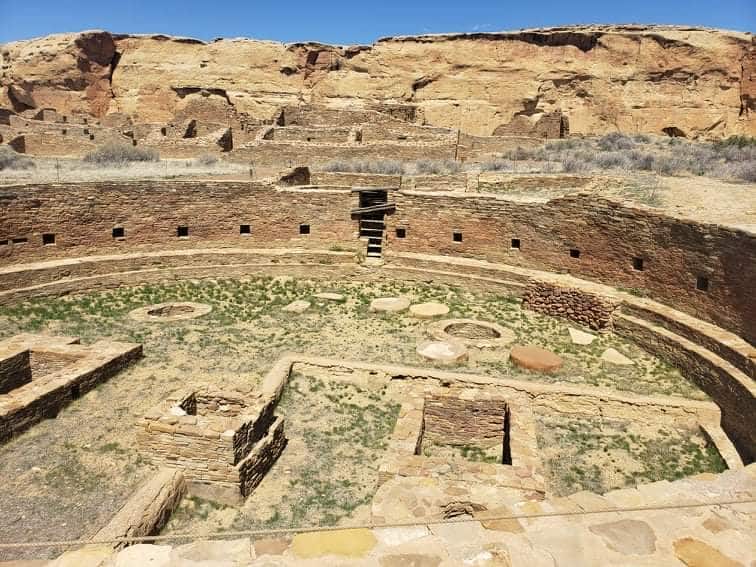
Eva is the founder and writer behind Discovering Hidden Gems. She spent a decade working in and studying the hospitality and tourism industry with experience in theme parks, hotels, guided vacation sales, and special events. In addition to sharing her expertise about traveling in the US, she offers mini courses on saving money on travel and traveling more for less.
Similar Posts


28 Fun Things To Do In Los Angeles In October (2024)

The Best San Diego Weekend Itinerary (2024)

The 33 Best Restaurants in Dayton, Ohio (2024) (From A Local)

Does It Snow At Universal Studios Hollywood?

The 26 Best Things To Do In Dayton In Spring (2024)

Is Santuario de Chimayó Worth Visiting? (2024)
An Acre in the City
Where I am when not traveling...
Visiting Chaco Culture: The Ultimate Guide

Only have one day to visit Chaco Canyon?
Fear not; you can still immerse yourself in the magic of this ancient site. Begin your adventure by understanding where Chaco Canyon is located. Situated in Chaco Valley, New Mexico, this hidden gem is approximately three hours northwest of Albuquerque, making it easily accessible for a day trip.
Chaco Culture National Historical Park is a fascinating destination nestled in the rugged landscapes of New Mexico. This UNESCO World Heritage Site offers a glimpse into the ancient Puebloan civilization, with its remarkably preserved ruins and rich cultural history.

In this blog post, we'll guide you on planning your visit to Chaco Canyon, highlighting the incredible things you can do and see, providing valuable tips, and answering frequently asked questions. One day in the park will give you an excellent overview of the park, but plan an overnight trip to enjoy the dark skies.
About Chaco Culture National Historical Park
Immerse yourself in the awe-inspiring history of the ancestral Puebloans as you step foot into Chaco Culture National Historical Park . This archaeological marvel boasts a collection of monumental stone structures, kivas, and intricate petroglyphs, all serving as a testament to the ancient civilization's advanced engineering and spiritual significance.
Chaco Canyon is a time capsule, offering a glimpse into the vibrant culture that once flourished in the arid landscapes. With their architectural prowess, the ancient Puebloans created an intricate network of Great Houses and sacred Kivas, meticulously aligning them with celestial events.
At the heart of Chaco Canyon stand the awe-inspiring Great Houses, such as Pueblo Bonito and Casa Rinconada, architectural masterpieces that leave visitors in awe of their grandeur. Each stone meticulously placed, these structures witness the ancient inhabitants' advanced engineering and cultural sophistication.
You are welcome to venture into the sacred Kivas—underground chambers that served as ceremonial spaces for the ancient Puebloans. Standing within these hallowed grounds, you'll feel the spiritual essence that once filled the air during sacred rituals and gatherings.

As you travel through the park, you will find that the canyon walls adorned with petroglyphs and rock art narrate the stories of the past. Decipher the intricate symbols and carvings that depict the beliefs, customs, and daily life of the Chacoans—a window into their spiritual and cultural world.
Beyond its historical significance, Chaco Canyon also boasts breathtaking natural landscapes. From the sunsets that paint the sky with vivid hues to the serene silence that envelops the canyons, nature herself adds to the allure of this ancient wonder.
Where did the People of Chaco Canyon go?
The story of the people at Chaco Canyon is one shrouded in mystery, and historians and archaeologists continue to piece together fragments of the past to unravel their fate.
The ancient Puebloans, also known as the Ancestral Puebloans, inhabited Chaco Canyon from approximately 850 to 1250 AD. They flourished in this region of the American Southwest, leaving behind a legacy of remarkable architecture, art, and advanced societal structures.
At its peak, Chaco Canyon was the center of an impressive civilization. The ancient Puebloans built intricate multi-story Great Houses, such as Pueblo Bonito and Casa Rinconada, using precisely cut sandstone blocks.

These monumental structures served as community centers, ceremonial spaces, and living quarters, displaying the Puebloans' sophisticated engineering and architectural skills.
Chaco Canyon was not merely a cluster of buildings; it was a hub of culture and spirituality. The Puebloans were deeply connected to the celestial cycles, and their architectural alignment with the sun, moon, and stars attests to their advanced understanding of astronomy.
Rituals, ceremonies, and observances were integral to their daily lives, fostering a profound relationship with the natural world.

Around the mid-12th century, a transformation began to unfold at Chaco Canyon. The reasons behind the decline of this once-thriving civilization are subject to debate among experts, but several factors likely contributed to the shift:
Environmental Challenges -The region experienced a series of prolonged droughts during the 12th and 13th centuries, altering the availability of water and impacting agriculture. These environmental challenges likely put immense strain on the community's resources.
Societal Pressures – As the population grew and resources became scarcer, competition for vital resources, such as water and fertile land, may have led to conflicts among neighboring communities.
Cultural and Social Changes – Internal cultural and social changes might have played a role in the decline as well. Shifting ideologies, leadership disputes, and changing trade networks could have affected the community's cohesion and stability.
As the challenges mounted, the Puebloans gradually began to disperse from Chaco Canyon to outlying areas, seeking more sustainable living conditions. Sites like Aztec Ruins and Salmon Ruins are examples of places where the ancient Puebloans may have relocated during this period.
Though the Chacoan society declined, their legacy lives on in the remnants of their ancient civilization. Chaco Culture National Historical Park stands as a testament to their ingenuity, spirituality, and cultural richness.
The story of the people at Chaco Canyon is a tale of resilience and adaptation. They navigated environmental challenges, cultural shifts, and the ebb and flow of history, leaving behind a legacy that continues to inspire wonder and curiosity to this day.
As we explore the ancient ruins and immerse ourselves in the enigmatic charm of Chaco Canyon, we honor the enduring spirit of the people who once called this place home—a spirit that whispers its tales through the silent canyons of time.

Planning your Visit to Chaco Canyon
A trip to Chaco Canyon requires thoughtful planning and preparation. From choosing the best time to visit for pleasant weather to arranging accommodations and guided tours, our comprehensive guide ensures an unforgettable and seamless experience.
Remote and Isolated:
Chaco Culture is located in a remote and isolated region. The dirt roads to the park can be narrow, winding, and predominantly rural so you may encounter few amenities or services.
Also note that there are no gas stations, restaurants, or other amenities within the park boundaries, so ensure you have enough fuel, food, and water for your visit.
Limited Cell Phone Reception:
Due to the remote location, cell phone reception can be spotty or non-existent in some areas. Have a paper map or a reliable GPS device to navigate.
Unpaved Roads:
Access to the park requires driving on unpaved roads. The access roads are rough, rocky, and rutted. The most accessible route to the park is from the North (From US 550, go to mile 112.5, 3 miles SE of Nageezi, and turn onto CR 7900 and CR 7950) – expect 13 miles of unpaved road.
It's essential to check weather conditions before heading out and consider the suitability of your vehicle for such terrain. Also, expect the unpaved road portion to take about 1.5 hours to drive.
Tip: The park rangers are only sometimes aware of road conditions. A ranger told us that the south access road would be good if we had made it a certain distance. Well, we passed that distance and came across an area covered in water, and we had to turn around. If it has been raining, call 505 786-7014 for road conditions.
Four-Wheel Drive Recommended:
While the main roads leading to Chaco Culture National Historical Park are generally accessible by regular vehicles, having a high-clearance, four-wheel-drive vehicle can be advantageous and give you a better piece of mind as you venture down the unpaved roads.
Wildlife:
Be cautious of wildlife crossing the roads, especially during dawn and dusk. Watch for signs indicating potential wildlife crossing areas.
Weather Conditions:
The region experiences a desert climate with hot summers and cold winters. Be prepared for sudden weather changes, especially during monsoon season, as flash floods can occur.
Tip: The route from the South has 21 miles of unpaved road and is impassable when wet.
Respect Nature and Archaeological Sites:
Chaco Culture is a place of significant historical and cultural importance. When driving within the park, be mindful of protecting the fragile desert ecosystem and respecting the archaeological sites and artifacts.

Getting to Chaco Culture National Historical Park
Chaco Canyon's remote location adds to its allure but requires careful consideration when planning your journey. Here are a few transportation options:
Self-Drive: If you prefer the freedom of exploring at your own pace, driving to Chaco Canyon is an option. Be prepared for rough roads and limited services along the way.
Chaco Canyon Guided Tours: Joining a guided tour is an excellent way to navigate the challenges of reaching Chaco Canyon. Sit back, relax, and let the experts handle the logistics while you soak in the awe-inspiring surroundings. Some local Chaco Canyon Tours include a day tour with Heritage Inspirations or a five-hour guided route with Navajo Tours USA .
Things to Do in Chaco Culture National Historical Park
Chaco Canyon offers a range of activities for history enthusiasts, outdoor adventurers, and nature lovers alike.

Visitor Center:
Start your journey at the visitor center to get an overview of the park's history and cultural significance in the museum and helpful information about your visit. There is also a 26-minute film that helps you understand the history of the site and bookstore. The National Park Service did a fabulous job with the visitor center; unfortunately, due to climate concerns, artifacts are not displayed at this time.
The Chaco Canyon hours vary by season but are open at 7 am, with closing hours ranging from 5 pm to 9 pm. The park is closed on Thanksgiving, Christmas and New Year’s Day.

Explore the Ruins:
Wander through the iconic Pueblo Bonito, Chetro Ketl, Casa Rinconada, and Hungo Pavi sites to witness the architectural marvels of the ancient Puebloans. Marvel at the precision of their stonework and imagine life in these old structures.
As you wander through the rooms and plazas of these ancient ruins, you will transport yourself to a time when this monumental structure thrived with activity and cultural significance.
Pueblo Bonito: Explore the park's largest and most impressive ancient Puebloan Great House. Pueblo Bonito contains over 600 rooms and served as the center of Chacoan society, showcasing the Ancestral Puebloans' intricate craftsmanship.
Chetro Ketl: Another remarkable Great House, Chetro Ketl, showcases the architectural expertise of the ancestral Puebloans. It's one of the most significant structures in the park.

Casa Rinconada: This large circular structure is believed to have been an ancient kiva, a sacred space for religious ceremonies and community gatherings.
Hungo Pavi: Another notable Great House within Chaco Culture National Historical Park that offers insights into the architectural prowess of the ancestral Puebloans with its interconnected rooms and classic Chacoan masonry construction.
Petroglyphs and Rock Art: Hike to various rock art panels and petroglyph sites, such as Una Vida and Hungo Pavi, showcase ancient artwork and symbols etched into the rocks.
Canyon Loop Drive at Chaco Culture National Historical Park
The Canyon Loop Drive is a scenic and informative 9-mile-long paved route that takes you around to explore five major Chacoan archaeological sites and the natural beauty of Chaco Culture National Historical Park.
This self-guided driving tour comprehensively overviews the park's history, culture, and stunning landscapes. The loop will take 3 to 4 hours to complete, depending on the time spent at each site and the frequency of stops.

Main Sites: The drive includes access to prominent Chacoan archaeological sites, such as Pueblo Bonito, Chetro Ketl, and Una Vida. Visitors can explore these impressive ancient Great Houses and learn about the advanced engineering and architectural techniques the ancestral Puebloan people employed.
Petroglyphs and Rock Art: Along the drive, there are opportunities to observe petroglyphs and rock art panels etched into the sandstone cliffs, providing a glimpse into the ancient inhabitants' spiritual beliefs and artistic expressions.

Scenic Overlooks: The Canyon Loop Drive offers several designated viewpoints, allowing visitors to appreciate the grandeur of Chaco Canyon and the surrounding landscapes. These overlooks provide excellent opportunities for photography and contemplation of the region's natural beauty.
Interpretive Signage: Throughout the route, there are informative interpretive panels that provide historical context, cultural significance, and archaeological details about the sites and their inhabitants. These resources enhance visitors' understanding of the park's importance and its place in the history of the ancient Southwest.

Ranger Programs
Ranger-led programs at Chaco Culture National Historical Park offer valuable opportunities to enhance your understanding of the park's history, culture, and natural environment. These programs are led by knowledgeable and passionate park rangers who provide informative and engaging experiences.
Interpretive Talks : Park rangers conduct interpretive talks that cover a wide range of topics, such as the history of the ancestral Puebloans, the significance of Chaco Canyon, and the region's unique geological and ecological features.
Guided Hikes: Ranger-led hikes allow visitors to explore lesser-known areas of the park and gain insights into its natural and cultural wonders. Depending on the season and availability, guided walks may lead to petroglyph sites, lesser-known ruins, or scenic overlooks.
Visit the park calendar for events .
Chaco Culture has four backcountry trails, ranging from 3 to 7.5 miles. Speak to a park ranger before setting out for an adventure to find out the latest conditions of the trails. There are sign-in logs at each trailhead.

Wijiji Trail
- Length: Approximately 3 miles round trip.
- Terrain: Mostly flat and easy with some uneven surfaces.
- Trailhead: before the visitor center across from the camping area.
- Description: The Wijiji Trail leads to the Wijiji Great House, one of the smaller structures in the park. Wijiji was constructed around AD 1100. Unlike the other houses, this one does not feature enclosed plazas or great kivas.
South Mesa Trail
- Length: Approximately 3.6 miles round trip.
- Terrain: 450 feet of elevation change
- Trailhead: Casa Rinconada Trail, Stop 10
- Description: The trail climbs to the top of the South Mesa and leads to the Tsin Kletzin Great House. Enjoy the scenic views from the Mesa.
Pueblo Alto Trail
- Length: Approximately 5.4 miles round trip.
- Terrain: 450 feet of elevation change, moderately challenging
- Trailhead: Pueblo de Arroyo Parking Area
- Description: This trail provides an aerial view of Pueblo Bonito and other Chacoan buildings. The trail enters both Pueblo Alto and New Alto. You will also pass Chacoan roads, ramps, and stairs along the way.
Penasco Blanco Trail
- Length: Approximately 7.2 miles round trip.
- Terrain: 200 feet of elevation change, moderately challenging.
- Description: The Penasco Blanco Trail is a backcountry hike that takes visitors to the remote Penasco Blanco and passes Chacoan and Navajo petroglyphs and historical inscriptions along the way.

Bicycling
If you have your bicycle while visiting the park, consider riding one of the many options available at Chaco Canyon. The main 9-mile paved loop road does not require a permit, but most other options require a free permit from the Visitor Center .
Stargazing
Chaco Culture is designated as an International Dark Sky Park , making it an excellent location for stargazing and experiencing the night sky free from light pollution.
Night Sky Programs: Ranger-led night sky programs offer opportunities to observe celestial objects through telescopes and learn about the constellations, cultural astronomy, and the importance of dark skies for preserving our natural heritage.
Special Events and Solstice Celebrations: Throughout the year, the park organizes special events to celebrate solstices and equinoxes, aligning with the astronomical phenomena observed in Chacoan architecture. These events often include demonstrations, performances, and interactive activities.
Visit the park calendar for events .
If you like night sky events and National Park Service sites, Sleeping Bear Dunes National Lakeshore also has night sky activities!

Where to Stay when visiting Chaco Canyon
Camping at Gallo Campground within the park is your best bet, but reservations can fill quickly. Sites are reserved online or at the visitor center on a first come, first serve basis.
The closest lodging options are about 1.5 hours away in Bloomfield, Aztez, or Farmington. We stayed at the Best Western Plus The Four Corners Inn in Farmington the night before our park visit.
Gallo Campground:
Gallo Campground is just a short distance from the park entrance and has 32 spaces and two group camping areas. RV’s under 35 length, tents, and car camping are allowed. Sites include a picnic table and a fire grate with a grill.
You will need to bring firewood and charcoal. There is a bathroom with water and flush toilets. There are no showers or site hook-ups available. Generators are permitted between certain hours.
It is also important to know that the campground has no shade. Visitors are permitted to stay for 14 days at a time. Individual camping sites are $20/night, but discounts are available for Senior and Access pass holders.

Tips for Visiting Chaco Canyon
To ensure a smooth and enjoyable visit, keep these tips in mind:
Plan Your Timing: Chaco Canyon is open year-round, but the best time to visit is spring or fall when temperatures are milder. Avoid visiting during monsoon season as flash floods can occur.
Bring Supplies: As the park is located in a remote area, bringing enough food and supplies to last your stay is essential. There are no restaurants or stores within the park. For better views of the petroglyphs, consider bringing a pair of binoculars or a camera with a zoom lens.
Nearby ancient Puebloan sites
Suppose you're interested in exploring other ancient Puebloan sites and similar cultural and historical locations in the region. In that case, consider visiting several sites within a 3-hour drive from Chaco Culture National Historical Park. Here are some places with similar characteristics to Chaco Culture National Historical Park:

Aztec Ruins National Monument (Aztec, New Mexico) – Approximately 1 hour and 40 minutes drive from Chaco Culture. This site features well-preserved ancestral Puebloan ruins, including a large Great House.
Salmon Ruins and Heritage Park (Bloomfield, New Mexico) – Around a 2-hour drive from Chaco Culture, this park offers insights into the ancestral Puebloan culture and includes reconstructed ruins and a museum.
Crow Canyon Archaeological Center (Cortez, Colorado) – About 2 hours and 30 minutes from Chaco Culture, this educational center has archaeological programs and exhibits related to ancestral Puebloan history.
Mesa Verde National Park (Colorado) – Approximately 2 hours and 40 minutes drive from Chaco Culture; this park is famous for its well-preserved cliff dwellings and ancient Puebloan structures built into the cliffs.

Hovenweep National Monument (Colorado/Utah) – Around 2 hours and 40 minutes from Chaco Culture is Hovenweep. This site showcases ancient Puebloan villages with unique stone towers and structures.
El Morro National Monument (Ramah, New Mexico) – Approximately 2 hours and 40 minutes drive from Chaco Culture. This Monument features inscriptions and petroglyphs left by various cultures, including ancestral Puebloans, on a sandstone bluff.
Canyon de Chelly National Monument (Chinle, Arizona) – About 2 hours and 45 minutes drive from Chaco Culture. Canyon de Chelly has spectacular canyons and ancient Puebloan ruins, some of which are still inhabited by Navajo families today. I found this park one of the most peaceful parks I have ever visited.
Bandelier National Monument (Los Alamos, New Mexico) – Around 2 hours and 50 minutes drive from Chaco Culture. Bandelier offers well-preserved ancient Puebloan dwellings, cliff dwellings, and petroglyphs. Be sure to climb up into to ruins when permitted.

These nearby sites offer diverse opportunities to explore ancient Native American cultures and their architectural achievements. Each location has its unique historical significance and provides insights into the lives of the ancient inhabitants of the American Southwest.
When visiting these sites, respect the cultural heritage and follow any guidelines or restrictions set by the respective park authorities.
Photo Op: While in this region, consider stopping at the Four Corners Monument, where you can stand in four states simultaneously!
FAQ's about Chaco Canyon
Visiting Chaco Canyon will cost you $25/vehicle, $20/motorcycle, or $15/person if you walk or bicycle in. Annual passes are accepted, and you will get in for free, but you will still need to go to the visitor center and receive an entrance pass to display on the vehicle's dash. Passes are valid for seven days. Park passes may be purchased online prior to your visit.
Yes, but they must be leashes no longer than 6 feet. Pets are not permitted within archeological sites (Pueblo Bonito, Chetro Ketl, Casa Rinconada, Pueblo del Arroyo, Hungo Pavi, and Una Vida).
Also, be aware that the Bubonic plague and Hantavirus exist in northern New Mexico. Keep yourself and pets away from rodent nests and burrows.
Reservations are required for camping in the Chaco Canyon.

Final Thoughts: Chaco Culture National Historical Park
Chaco Canyon is a remarkable destination in the United States, offering a unique window into the past. Uncover the mysteries of the ancestral Puebloans, marvel at the ancient ruins, and immerse yourself in the breathtaking landscapes.
Plan your trip wisely, and prepare to be captivated by the enchanting allure of Chaco Culture National Historical Park.
Visiting this Chaco Culture site is worth the drive!
Related Posts
If you enjoy Dark Sky Parks or UNESCO World Heritage Sites, you may also enjoy:
Smoky Mountains National Park
Sleeping Bear Dunes National Lakeshore
15 Best UNESCO World Heritage Sites in North America
Pin this for later
Choose the image(s) that resonate with you to pin to your travel board on Pinterest !

Sharing is caring!
Teresa Kulczycki is the founder of An Acre in the City. She has travelled to all 50 States in the USA and has a travel bucket list that she continues to whittle down. She has less than 100 US National Park Service Sites and only 9 state capitols left to visit. Other travel bucket lists includes catching a baseball game at all the Major League Baseball Fields.
Similar Posts

Acadia National Park in Fall: Ultimate Autumn Visitors Guide

Great Smoky Mountains in the Spring: A Comprehensive Guide

17 Best Waterfalls at Great Smoky Mountains National Park

7 Hidden Gems: Lake Erie Lighthouses To Visit

An Insiders Guide for Visiting Au Train Falls in Michigan

12 Easy Hikes Near Gatlinburg: Top Scenic Trails
History Fangirl
The Ultimate History Travel Blog Since 2015
7 Things To Do in Chaco Culture National Historical Park, a UNESCO World Heritage Site

Last Updated on: 19th June 2023, 06:41 pm
Before you visit the UNESCO World Heritage Site Chaco Culture National Historical Park in New Mexico, here’s a list of everything you need to know – from access to biking to hiking to camping to soaking in the essence of Ancestral Puebloan culture on a journey into a canyon sacred for thousands of people between AD 850 and AD 1250.
Megan Kopp shares everything you need to know about Chaco National Historic Park before you go so you can fully appreciate this UNESCO World Heritage Site in New Mexico!
Can’t read now? Pin for later!

My Favorite Travel Booking Sites for 2024
These are my favorite companies that I use on my own travels.
Protect Your Trip via Safety Wing
Find the best city tours, day tours, bus tours, & skip-the-line tickets on GetYourGuide and Viato r .
Find the best deals on hotels & vacation rentals on Booking.com .
For English-speaking private airport transfers, book through Welcome Pickups.
For road trips and independent travel, rent a car through Discover Cars .
Find information and cruise reviews on Cruise Critic.
For packing and travel essentials order via Amazon .
Book an affordable family or romantic photography session on your trip through Flytographer (Use the code HISTORYFANGIRL for 10% off your first photoshoot).
For travel guidebooks to have with you during your trip, I always pick one or two from Rick Steves and Lonely Planet.
Visit America’s UNESCO World Heritage Sites!
This post is part of a series on visiting the USA’s great UNESCO World Heritage Sites. Other World Heritage Sites nearby include Mesa Verde (Colorado), Carlsbad Caverns (New Mexico), and Taos Pueblo (New Mexico).
How to Get to Chaco Culture National Historical Park

To say that Chaco is remote is like saying that the Grand Canyon is deep. Chaco Culture National Historical Park has always been remote, isolated, and a little off the radar.
Created in 1907, the park didn’t even have a superintendent until 1923. Located in northwestern New Mexico, about 2 ½ hours from Albuquerque, the park can only be accessed by driving on rough dirt roads. There are no commercial services – food, fuel, or lodging – within the park. The closest services are 1½ hour away.
To get there, use a map. GPS is not reliable in this terrain and has been known to lead travelers off onto side roads that are impassable for passenger cars and RVs. Seriously. Access to the park is going to be your first adventure.

The best route – with the least amount of dirt road travel – is from the north, turning off US 550 at CR 7900, approximately three miles southeast of Nageezi and 50 miles (80 km) west of Cuba. The route is signed from US 550 to the park boundary, a distance of 21 miles (34 km).
Roads conditions vary greatly. It can be slick and muddy during rainy periods or bumpy and full of potholes during dry times. If the weather is or has been sketchy, call for current road conditions before venturing into the park (505-786-7014).
What Makes Chaco Culture National Historical Park Unique?

If access is that difficult, why would anyone want to go? First of all, Chaco Culture is not a single entity. Chaco has the largest, best-preserved, and most complex prehistoric architectural structures in North America. It was a center for ceremonies, the turquoise trade, and political activity for the prehistoric Four Corners area and includes an ancient urban ceremonial center that is unlike anything constructed before or since.
Secondly, visitors have the opportunity to wander through reconstructed and unexcavated great houses – built from the mid-9 th to early 13 th centuries by the Ancestral Puebloan people, formerly known as Anasazi .
These monumental complexes contain hundreds of rooms, where archaeologists have uncovered everything from macaw and parrot feathers to copper bells and seashells – all imported from Mexico over 600 miles (1,000 km) away.

Visitors can also investigate underground ritual spaces known as kivas, discover mysterious trash mounds made up of tens of thousands of pottery shards, and walk along engineered and constructed 30-foot (9 m) wide roads built almost a thousand years ago.
If that isn’t enough, add in archaeoastronomy. Say what? Archaeoastronomy is the study of how people have understood, related to, and used sky phenomena in their culture. Chacoan people had an amazingly strong connection with the night sky and seasonal cycles . Various structures in the park were intentionally built in such a way as to capture the sunlight or moonlight on particular days of the year.
For example, there are buildings that capture solstice markers of light on buildings during summer and winter, as well as spring and autumn equinoxes – to say nothing of the incredible Sun Dagger site on Fajada Butte, an extraordinary solar and lunar calendar (interpreted in visitor center displays and films).
The Best Things to Do in Chaco Culture National Historic Park
There are ruins to explore, hikes to walk, bike routes to pedal and the endless night sky to gaze upon in Chaco Canyon.
Visitor Center

Start with the Visitor Centre, open daily from 8 am – 5 pm from May to October; 8 am – 4 pm November to April. Wander the displays for an overview of the park and its key sites. Take time to watch the films playing in the theatre. It will help you appreciate the incredible depth and complexity of the Chaco Culture you are about to witness over the next few days.
Be sure to pick up self-guided trail brochures before heading out. Most of the park and cultural sites are self-guided year-round. Six major sites are located along the Canyon Loop Drive. These included: Una Vida, Hungo Pavi, Pueblo Bonito, Chetro Ketl, Pueblo del Arroyo, and Casa Rinconada.
Pueblo Bonito

Without a doubt, all of the sites offer something of value and are worth a visit, but Pueblo Bonito and Casa Rinconada stand out as being the most memorable from our trips. We visited Pueblo Bonito several times – the first on a guided tour with a park ranger and a second time on our own when we could explore at leisure.
Both are excellent options because a guided tour provides more information than what is available in brochures and exploring on your own allows you time to watch the shadows move on the walls as the sun crosses the sky. You can’t help but feel the spirit of the place.
Pueblo Bonito – Spanish for “beautiful town” – is the biggest of all Chacoan great houses. It has an astonishing 32 kivas, 3 great kivas (larger than normal kivas), and over 700 rooms. At one time this beautiful town rose four stories high.
It was one of the first great houses to be built in the canyon, starting around AD 850. When viewed from the overlook trail above, the structure’s D-shape is obvious. What isn’t obvious is its alignment with cardinal directions. Its southern wall, for example, is aligned east/west. On the spring and fall equinoxes, the Sun rises and sets in perfect alignment with this wall. So much more to learn about this beautiful place.
Casa Rinconada

Casa Rinconada is not a house as the name might suggest; rather, it was a great kiva set apart on the top of a low ridge directly across from Pueblo Bonito. This massive ceremonial structure has an inner diameter of 63 feet (19 m).
Two masonry vaults or chambers below the floor were used as foot drums to punctuate the ceremonies held within. The kiva also includes a 39-foot long (12 m) underground passage on the north side. Imagine the spectacle of a shaman or religious leader entering unseen in the darkness.
Although the roof is long gone, our daughter played her fiddle softly on one side of the kiva and we could hear it perfectly on the other – such are the acoustics of this amazing structure even centuries later.
Canyon Loop Drive

Although it is a popular driving tour, you’ll get even more out of your visit if you hop on and off your bicycles as we did. The 9-mile (14.5 km) long loop is a one-way and almost level, and it is a paved slice of perfection.
Rather than be ruined by great house overload, break up your exploration of the highest concentration of structures in what is called downtown Chaco by exploring a few and then biking back to camp, or parking your bike at one of the bike racks and stretching your legs on a short climb up to an overlook.

There are three additional biking opportunities within the park – Wijiji Trail, Casa Chiquita (on a portion of the PeñascoBlanco Trail), and Kin Klizhin.
Wijiji requires a free permit which you can get from the Visitor Centre, the campground host, or at the trailhead. It’s a 3-mile (5 km), mostly level roundtrip that takes one to two hours. The ruin at the end of the trail was built around AD 1110 and consists of 225 rooms arranged about two kivas.
The coolest thing about Wijiji is its connection with the winter solstice. Standing at the northwest corner of Wijiji you can see a distant notch on the horizon. On the morning of the winter solstice, the sun rises precisely at the southern edge of the notch.
The two-mile roundtrip ride into Casita Chiquita also requires a free permit. This smaller great house was built into the surrounding hillside around AD 1060. The kiva is raised above ground level.
Kin Klizhin is the longest ride at 24 miles (38 km) roundtrip – which probably why we never did it. The route follows a narrow dirt road with minimal elevation gains and if you love to ride, you’ll be one of the few visitors that get to see this remote great house. It is considered an outlier of the canyon core structures.
Hiking Chaco’s Backcountry

If you left your bike behind, no worries – there are plenty of hiking options within the park. You can pick up a trail guide booklet from the Visitor Centre bookstore for minimal cost and explore one four backcountry hiking trails in Chaco Culture National Historical Park. These include Wijiji (mentioned above), South Mesa Trail, Pueblo Alto Trail, and Peñasco Blanco Trail.
We hiked the 8-mile (11 km) return Peñasco Blanco Trail for three reasons: 1) to visit a great house in solitude; 2) to view the rock art panels and the famed “Supernova” pictograph, and 3) for bragging rights – kidding! – no, it was just because it was a full-day adventure immersed in the canyon.
A short detour on the Petroglyph trail offers the chance to view prehistoric and historic rock art, but the highlight of the trip was the painted rock art at the end of the trail. The faded red ochre painting depicts an exploding star in the Crab Nebula in AD 1054. It boggles the minds when you realize how these astute ancient astronomers carefully recorded this sighting for us to wonder about so many centuries later.
Gallo Campground
While there are no lodging facilities within the park, there is camping at Gallo Campground – and I highly recommend you spend at least a night or two.
Located one mile east of the Visitor Centre, the campground is open year-round. It’s tucked beneath the low cliff of Gallo Wash which holds a cliff dwelling and petroglyphs – inscribed rock art. It’s a somewhat primitive campground with little shade and no hookups – but trust me, you’ll be happy you stayed here long enough to soak up at least one sunset and one sunrise.
Where Else Can I Find Chacoan Culture?

In the 1100s and 1200s, new construction in the canyon slowed down and its influence began to wane. Other areas became small outliers of Chacoan culture. Additional Ancestral Puebloan sites can be found across the San Juan Basin in New Mexico, Colorado, and Utah.
If you haven’t had your fill in the canyon, many of these outlying great houses are open to the public. A few include Aztec Ruins National Monument in Aztec, NM; Salmon Ruin in Bloomfield, NM; White House at Canyon de Chelly National Monument near Chinle, AZ; Far View House at Mesa Verde National Park near Cortez, CO; and Edge of the Cedars State Park in Blanding, UT.

Megan Kopp is a freelance travel writer with 20 years of crafting stories under her belt. She shares travel guides and tales on her website Time.Travel.Trek.
5 Things to Pack for Your Trip to Chaco Culture NHP
The Lonely Planet Southwest USA guidebook. It can be kind of a pain to find the major guidebooks once you get here, or you’ll find them overpriced. I always like to pick mine up ahead of time.
An Unlocked Cell Phone so that you can use a local sim card while here to help navigate public transportation and when you’re on the road. (For people without American cell phone plans).
Backup Charging Bank for your cell phone since you’ll be using it as a camera, GPS, and general travel genie.
A Camera to remember your trip by. I use a mix of my Nikon D810 and my Samsung8 smartphone these days.
A Great Day Bag so you can carry what you need with you (like your camera, snacks, water, sunscreen, cash, etc). My current favorite is the Pacsafe Citysafe , which is especially great for traveling because it has many anti-theft features designed to deter pickpockets. It also transitions to a night bag more easily and won’t embarrass you if you go to dinner directly after sightseeing all day.
Don’t Forget About Travel Insurance!
Before you leave for New Mexico make sure you have a valid Travel Insurance Policy because accidents happen on the road. I pay for World Nomads, and I happily recommend them. It’s especially important to get travel insurance if you’ll be hanging enjoying time in the beautiful outdoors.
I have been a paying customer of World Nomads for travel insurance for three years, and I happily recommend them. If you get sick, injured, or have your stuff stolen, you’ll be happy to have the ability to pay for your medical bills or replace what’s stolen or broken.
Pin this Guide to the Best Things to Do at Chaco NHP for Your Trip!

In this Article:
Leave a Comment Cancel reply
A Couple of Drifters
Where Do We Go From Here?
A Practical, In-Depth Guide to Chaco Canyon Camping and Hiking
Last Updated on June 1, 2021
Visiting Chaco Canyon National Historical Park in New Mexico is an adventure unto itself. Because of the effort to get here many people choose to camp within the park and we suggest you do the same. Get the most out of your Chaco Canyon camping experience and follow our complete guide featuring information on camping, hiking, driving directions and possible road conditions.
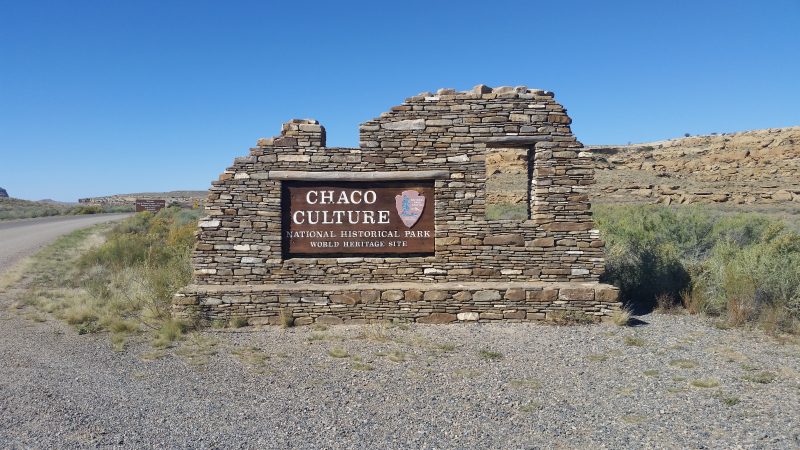
Having camped here multiple times before, we’ll share with you our favourite campsite and we’ll tell you which campsite to avoid! Chaco Canyon has been certified as an International Dark Sky Park and we have information on experiencing a presentation highlighting this distinction.
See the Dark in the Park Featured Programme section below and learn how to take advantage of the unique and free nocturnal astronomy presentation given by park rangers during your stay. This family fun event includes native folklore and stargazing through telescopes .
Watch Our Video and Learn More About New Mexico!
Beware of the Weather at Chaco Canyon
The number one influencing factor in driving, hiking and camping in Chaco Canyon is the weather. Before you undertake your trip, keep a very close eye on the weather forecast. Know before you go!
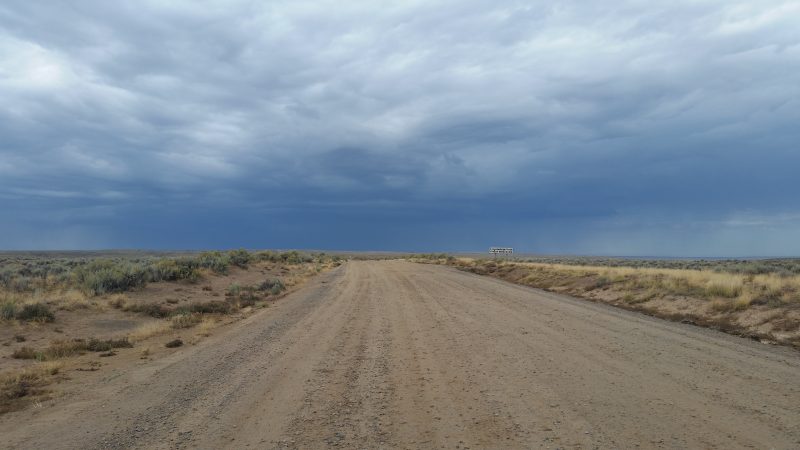
Also, keep an eye on the weather for the immediate 3 or 4 days preceding your trip. Dry conditions are required to tackle the road and to complete at least one of the Chaco Canyon hikes on the Peñasco Blanco trail. See Hiking in Chaco Canyon below for more information.
Within each Tips section below, the weather and it’s ability to drastically derail your plans tops the list each time. Most importantly, pay close attention to the weather while visiting Chaco Canyon. Thunderstorms, extreme heat or cold, snow and strong winds will ruin your time here.
Visiting Chaco Canyon
Directions: See Directions and a Breakdown of Road Conditions below – this includes directions from all points.
- 8:00 am – 5:00 pm, May through October
- 8:00 am – 4:00 pm, November through April
- Closed Thanksgiving, Christmas and New Year’s Day
Entrance Fees: The following fees are current as of October 21st 2018:
- $25 per vehicle (non-commercial), providing access to the park for 7 days.
- $20 per motorbike, providing access to the park for 7 days.
- $15 per individual travelling on foot or bicycle, providing access to the park for 7 days.
In order to eliminate cash payments all National Parks are in the process of attempting to implement a no-cash policy; because of this we recommend credit or debit card payment for entrance fees.
Telephone: (505) 786-7014
Website: www.nps.gov
Camping at Chaco Canyon
Some national parks have long waiting lists for camping reservations. When you have to wait a year to sleep next to a tree, something is wrong. – George Carlin
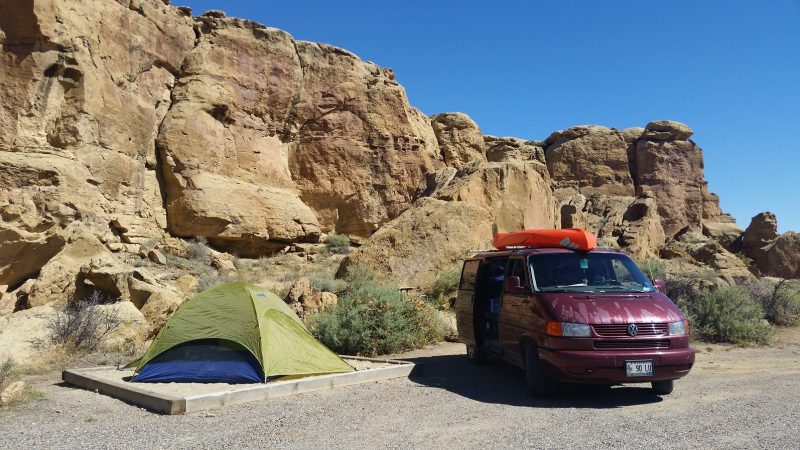
Gallo Campground (the campground at Chaco Canyon) has become an increasingly popular spot. During the Summer months and early Autumn it can be next to impossible to secure a campsite. There are very few non-reservable sites (only 8 in total). During this busy period we strongly recommended you book a site in advance. Go online to reserve a campsite at www.recreation.gov
RV or Tent Camping is $15 per night.
Online camping reservations must be made at least 3 days in advance. Without a reserved a spot online you will need exact cash for camping at Chaco Canyon – see update above. Camping fees must be paid at the visitor centre .
If the visitor centre is closed when you arrive, place any fees in the drop box at the entrance of the campground. The “iron ranger” (camping fee box) does not give change and the campground host will not handle payments.
Potable water taps are located by the visitor centre.
There are 2 blocks of plumbed toilets at the campground. In addition, pit toilets are located at each point of interest on the 9 mile loop drive through the park. All toilets are clean and well maintained, including the pit toilets. Plumbed toilets are also available by the visitor centre.
Gallo Campground Sites
There are a total of 49 sites and 2 group sites.
Reservable Sites:
For Tents or RVs: 25 Total
- Campsite #2, 3, 5 – 11, 18, 19, 20 – 28, 30 – 32, 34, 35
Tents Only: 12 Total
- Campsite #36- 43, 45, 46, 48, 49
RVs Only: 4 Total
- Campsite #13 -16
Group Campsites: 2 Total
Non-Reservable Sites: (i.e. First Come, First Served)
Tents or RVs: 5 Total
- Campsite #1, 4, 17, 29, 33
Tents Only: 2 Total
- Campsite #44, 47
RVs Only: 1 Total
- Campsite #12
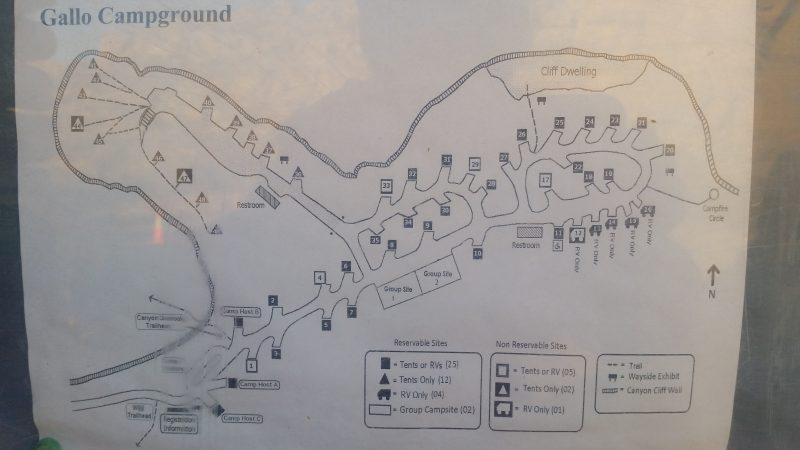
Each site at Gallo Campground comes equipped with a fire pit and a picnic bench, perfect for cooking and enjoying a meal after a long day of hiking. For that quintessential camping experience don’t forget to roast marshmallows over the campfire.
Chaco Canyon Camping Tips
- Be weather aware. Tent sites have a small, sand filled platform to place your tent upon, but even a small amount of rain will result in a deluge of run-off from the surrounding cliffs.
- Avoid campsite #4. All sites have their own wee trail (pardon the pun) to the bathroom, but for some reason campsite #4’s trail has become a shortcut/general all-purpose trail to the loo. Take it from our own first-hand experience during our stay at campsite #4. Fellow campers suddenly lost all sense of etiquette and traipsed through this site like a herd of lobotomized elk.
- Consult the campground host. Even if the sign saying “Campground Full” is is displayed check with the host anyway. Several first come, first served sites are available and you may be lucky enough to find one of these open (hopefully not site #4), but hey, beggars can’t be choosy.
- Bring firewood. You cannot gather firewood at Chaco Canyon. Also, be aware of fire restrictions, especially in the Summer months. Consider a camp stove – these may be permitted during burn bans at Chaco Canyon.
- Come fully prepared. The nearest major shop for stocking your camp kitchen is almost 80 miles away in Farmington.
- Bring extra blankets and warm clothes. It gets very cold here at night, even in the Summertime.
- No refunds for leaving early. Things change – weather and/or vehicle issues may cause you to break camp.
- Get up early. The gate to the loop road opens at 7:00 am. You may see herds of elk grazing, especially at dawn and dusk, though they may be seen throughout the park during the day.
- Campsite #44 is the pick of the campground. This is a tent site only and is non-reservable. Also, this campsite is one of the more private within Gallo Campground and includes a nice cave-like area behind it.
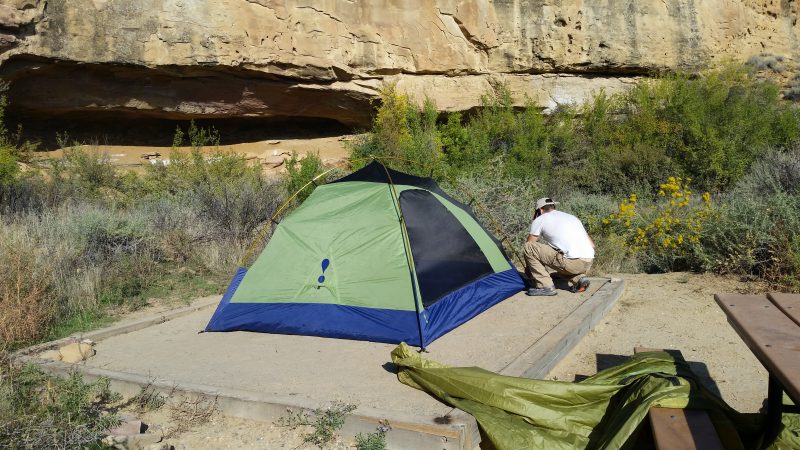
Chaco Canyon Camping Overview:
If you are looking for privacy, it is non-existent at this campground. Sites are close together with neither natural nor man-made barriers between them apart from perhaps a few scrub bushes. As a result of this, sites at Gallo Campground provide no shade.
This is a rather peaceful campground with quiet time being between 10:00 pm and 6:00 am. So if you are looking to rage it up and party while camping at Chaco Canyon, this is not the place for you.
Hiking in Chaco Canyon
Chaco Culture National Historical Park sits at an elevation of 6,200 feet. Acclimitise yourself to this coming from lower elevations, especially sea level.
There are 4 backcountry trails as well as the Una Vida trail, which is a short jaunt from the visitor centre. Hiking the backcountry trails takes effort and time however they are definitely worth it. These trails give access to even more ruins and each trail offers it’s own unique, stunning views. Give yourself plenty of time to complete any of these hikes.
Each backcountry trail requires you to fill in a backcountry trail permit/slip . These free permits are located at the start of each trail. Simply fill out the slip before setting out on your hike. One copy (green slip) is displayed in the windscreen of your vehicle, one copy (pink slip) comes with you and the original page (white slip) goes in the box at the beginning of the trail.
Una Vida Trail
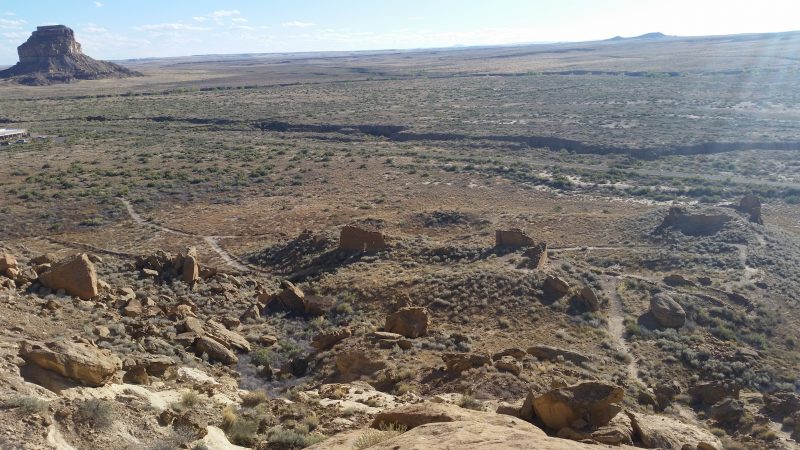
Trailhead Location: Accessed from beside the visitor centre
Ease/Difficulty: Relatively flat and easy
Distance: 1 mile round trip
Notable Features: Keep your eyes peeled for the petroglyphs on this trail. In order to see them be prepared to do a little climbing, nothing too strenuous but perhaps a little panting involved.
These petroglyphs are some of the clearest in the park. Beneath the petroglyphs is a large flat boulder offering a perfect vantage point to comfortably admire the cliff etchings and surrounding scenery.
Pueblo Alto Trail
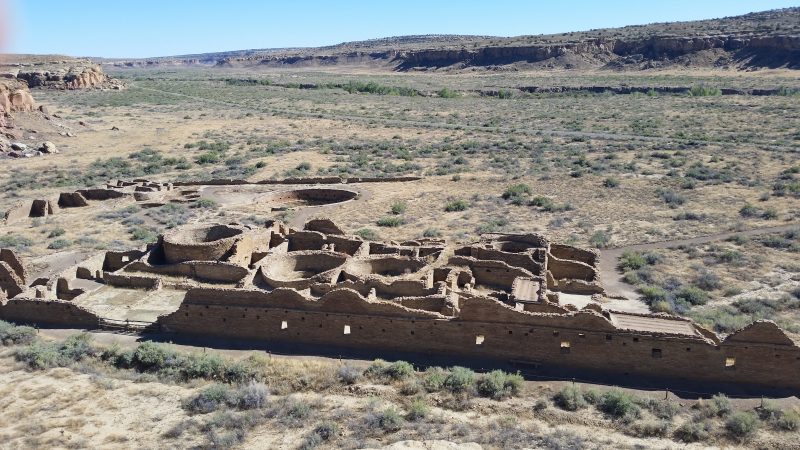
Trailhead Location: Access Pueblo Alto trailhead from the Pueblo del Arroyo parking lot. Your ascent to the ridge above starts behind the Kin Kletso ruins.
Ease/Difficulty: This is a relatively easy hike. The most difficult portion of the hike is the climb up onto the ridge (bench) but it is really not that tricky. Climbing up onto the ridge requires squeezing through a slotted canyon .
Elevation Gain: 350 feet
Distance: Pueblo Alto trail consists of 3 optional routes.
- Entire Loop – 5.1 miles
- Pueblo Alto Complex Route – 3.2 miles
- Pueblo Bonito Overlook Route – 2.0 miles
Notable Features: Pueblo Alto trail is possibly the most popular backcountry trail . You don’t have to complete the entire loop to seize the optimal Instagrammable snaps of the 2 mega-stars of Chaco Canyon – Pueblo Bonito and Chetro Ketl.
Even if you’re visiting Chaco Canyon on a day trip you can grab some snaps and be back to your car in no time. The overlooks of Pueblo Bonito and Chetro Ketl are located on the ridge above, accessed from the slotted canyon behind the ruins of Kin Kletso.

The trail begins in earnest atop the ridge with a fine view of Kin Kletso in the valley below. Pause here for a moment to catch your breath, only to have it taken away again by the views of Pueblo Bonito and Chetro Ketl just ahead on the trail.
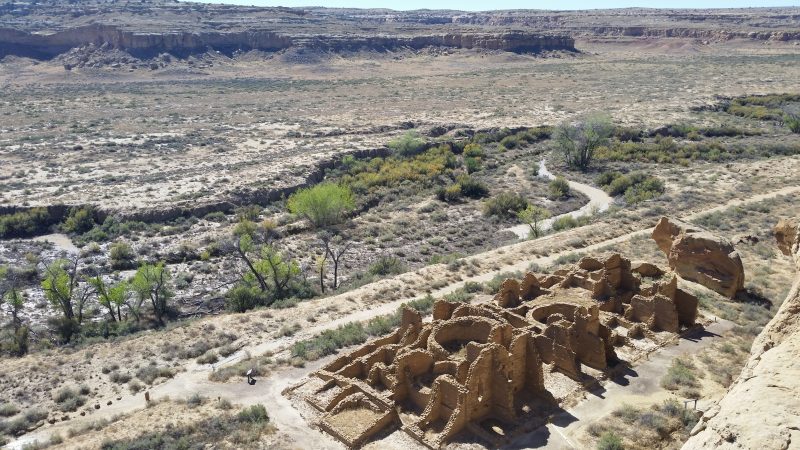
Keep your eyes peeled for shrimp burrows , evidence of ancient sea life forever memorialised in the sandstone of the region. These are everywhere .
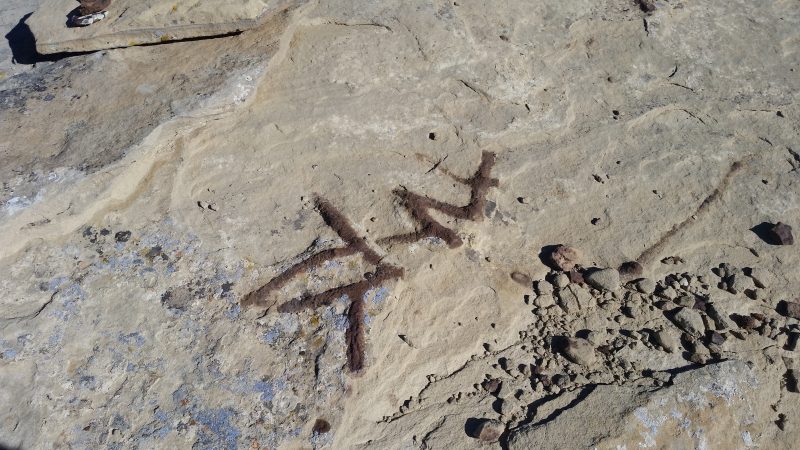
From this vantage point are fine views of South Gap. During the heyday of Chacoan Culture this was where multiple roads converged and entered the canyon. Exotic trade goods from as far as Mesoamerica made it to the region over these roads.
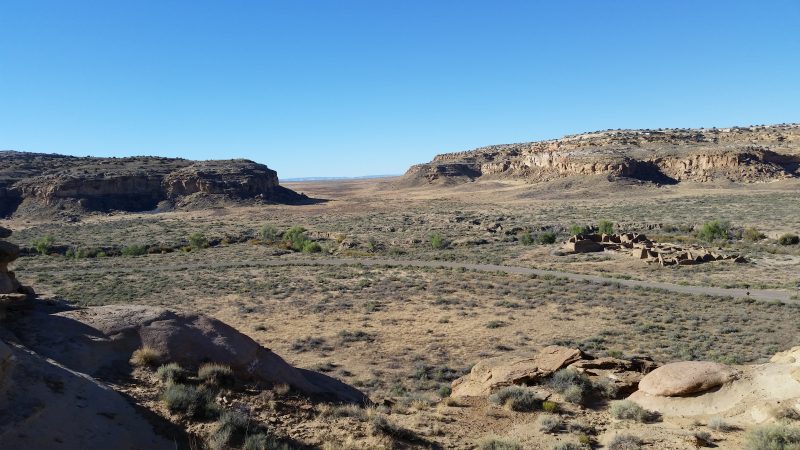
At the start of the loop trail you are treated to an overlook of Chetro Ketl, yet another great Chacoan House with multiple kivas, which were used during religious ceremonies. This loop route features another very narrow slotted canyon to conquer .
Another striking feature to look for on the loop trail is Jackson Stairway . Named after a photographer with the U.S. Geological Survey in 1877, these steep stairs are certainly not for the feint of heart. Hopefully back in the day there were at least some kind of handrails to grasp onto. Naturally the park service does not want anyone trying the stairway these days.
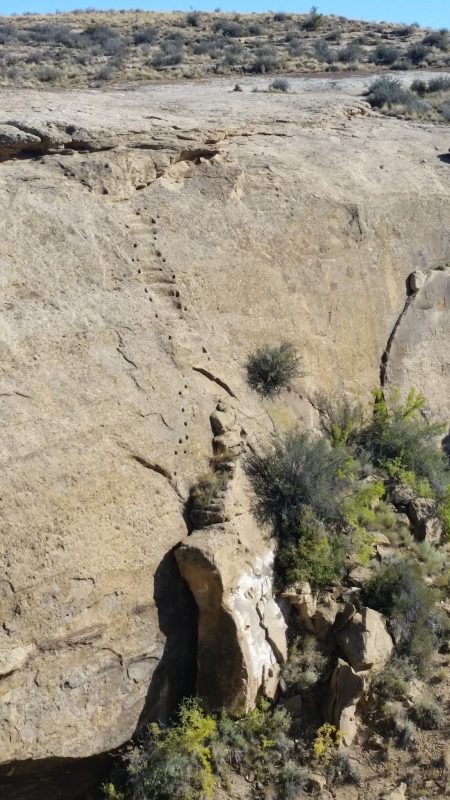
Pueblo Alto is situated at 6,440 feet in elevation. Both the loop trail and the Pueblo Alto Complex trails encompass the collection of ruins known as Pueblo Alto. The complex has panoramic views of the surrounding landscape; this commanding presence was intentionally chosen to communicate with other great houses far away, also located on natural elevated features.
Peñasco Blanco Trail
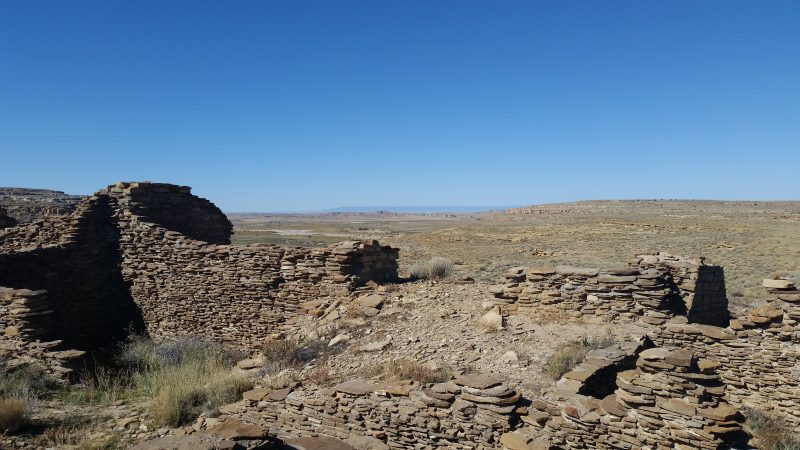
Trailhead Location: The Peñasco Blanco trailhead is also accessed from the Pueblo del Arroyo parking lot.
Ease/Difficulty: The Peñasco Blanco trail is relatively easy and flat with a few minor ups and downs until you cross Chaco Wash. The terrain of the trail is a mixture of dirt and sand.
If you plan on crossing the wash during this hike make sure the weather has been dry for at least 3 days preceding your trip. Chaco Wash fills quickly to a depth of 4 feet or more with slick mud on the bottom so use extreme caution when crossing. Also, never attempt crossing Chaco Wash when flowing water is present .
Once you cross the wash the trail briefly climbs to the Supernova Pictograph and climbs again as you continue to the ruins of Peñasco Blanco.
Elevation Gain: 200 feet
- At 7.2 miles round trip, this is the longest trail in the park if you cross Chaco Wash and continue to the ruins of Peñasco Blanco
- Hiking to the petroglyphs (see below) is 4.0 miles .
Notable Features: The first feature you encounter on the trail are the ruins of Casa Chiquita about 1 mile in.
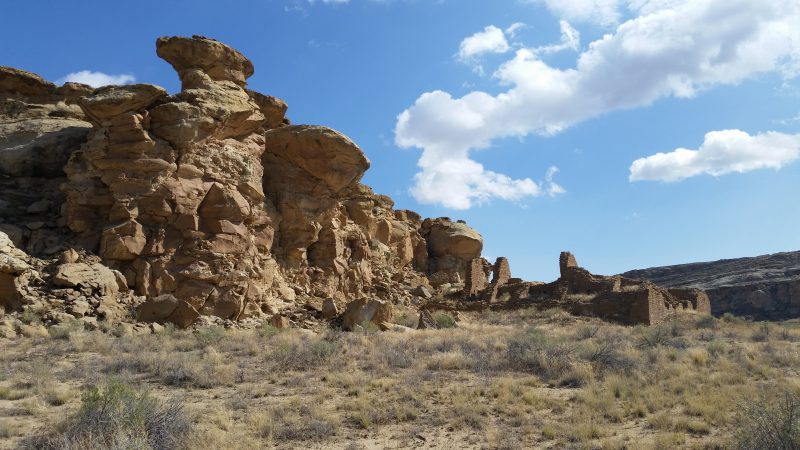
This trail features an extensive section of petroglyphs along the cliffs. These are well signed and if you have invested in the booklet – the Backcountry Trail Guide (available at the visitor centre) – you’re privy to detailed information on where exactly to look and what it is you are looking at. The petroglyphs are a combination of Pueblo, Navajo and European-American etchings.

Once across the wash you are rewarded with a view of the Supernova pictograph (rock painting). Depicted are a star, crescent moon and a human hand. You’ll also find a concentric circle painted in red and yellow. Allegedly, the pictograph represents a stellar explosion in 1054 A.D.
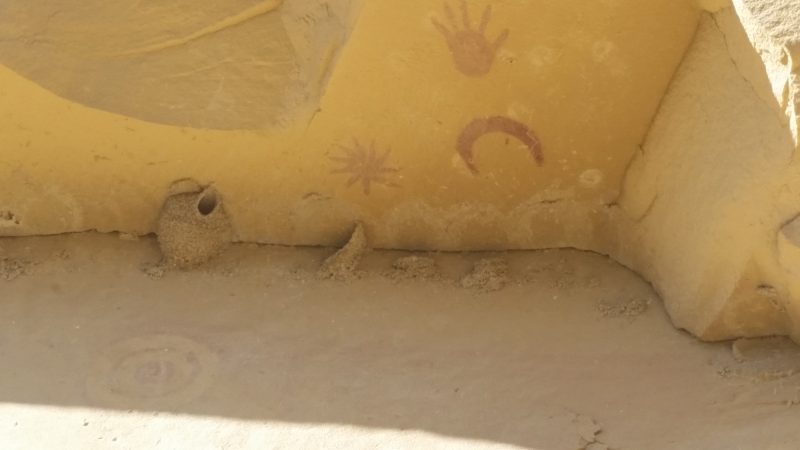
The ruins at Peñasco Blanco provide more incredible views of the surrounding landscape. Enjoy those views knowing you’ll almost certainly have the Peñasco Blanco ruins to yourself – this section is the least utilized Chaco Canyon hiking trail.
South Mesa Trail
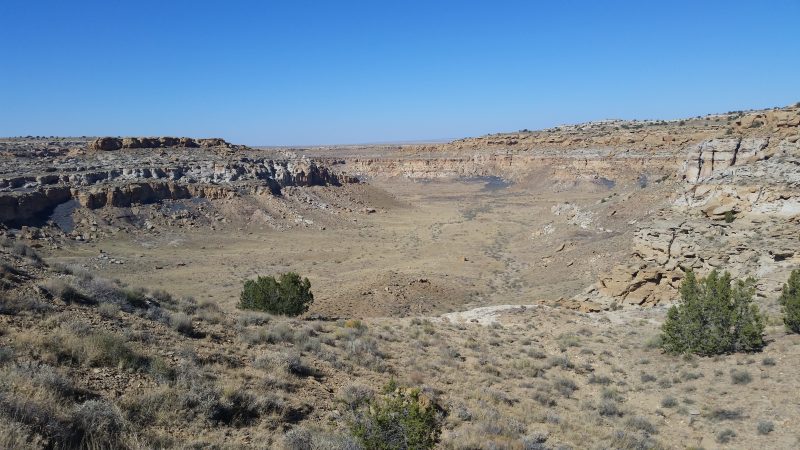
Trailhead Location: Access South Mesa trailhead from the Casa Rinconada interpretive trail.
Ease/Difficulty: The slight elevation gain on this trail isn’t difficult or technical. This well-marked trail is comprised of dirt, loose stones and sand.
Elevation Gain: 450 feet
- Entire Loop – 3.6 miles round trip
- Tsin Kletzin – 2.6 miles round trip
Notable Features: This was our favourite Chaco Canyon hiking trail, followed closely by the Pueblo Alto hike. The views are fantastic during this hike and the walk back through the South Gap is beautiful.
Wijiji Trail
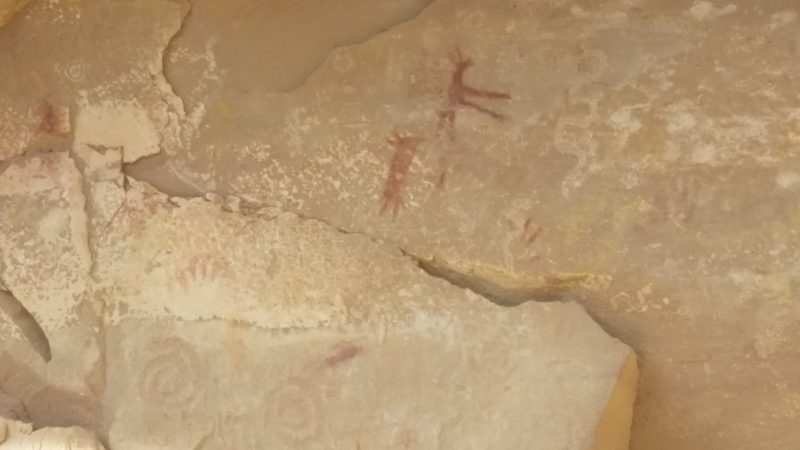
Trailhead Location: Wijiji trailhead is located 1.25 miles east of the visitor centre.
Ease/Difficulty: Lovely easy hike
Elevation Gain: Level
Distance: 3.0 miles round trip
Notable Features: Not far from the Wijiji ruins is a short trail which leads to a pictograph of two red animal images and some negative handprints. It’s very likely you’ll have this entire site (and hike) all to yourself.
We hiked in after a brief shower of rain. The photo below provides insight into how mucky these trails may become in a very short period of time. That thick mud made for a rather tough hike due to the extra added weight on our boots.
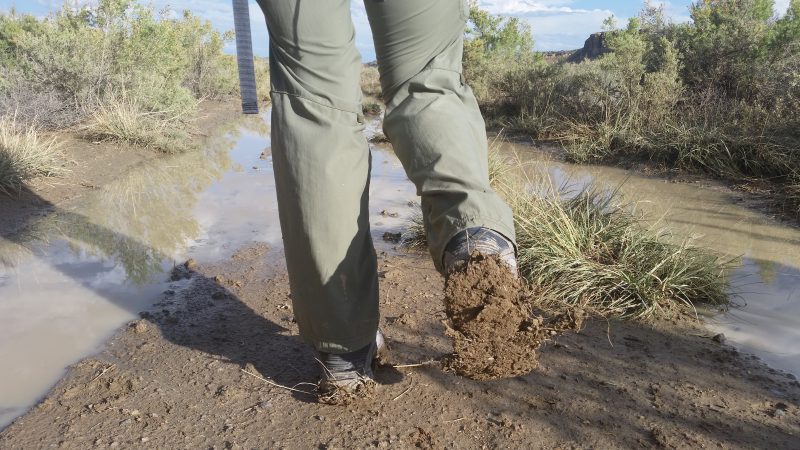
Wijiji Trail is easily accessed from Gallo Campground via a short 5 minute walk. This easy trail makes for an ideal early morning or evening hike . Take advantage of the ease and proximity of this trail when camping at Chaco Canyon.
Tips for Hiking in Chaco Canyon
- Know the weather forecast before your hike. The visitor centre provides projected weekly weather conditions, along with daily updates. Hiking in a light shower can be o.k. but this is not the place to get caught in a thunderstorm, especially if you are up on the ridges (benches). Ensure you have at least 3 or 4 days of dry weather before your planned hikes to allow the ground and the wash to dry out.
- Use an app. We recommend AllTrails which is free to download and highlights over 50,000 trails worldwide. What’s more, the AllTrails app even works offline. Simply add any trail as a favorite and the app guides you along using GPS.
- Invest in the Backcountry Trail Guide. These are available at the visitor centre and are indispensable while hiking in Chaco Canyon. The Backcountry Trail Guide thoroughly explains many interesting features within the park, both natural and man-made.
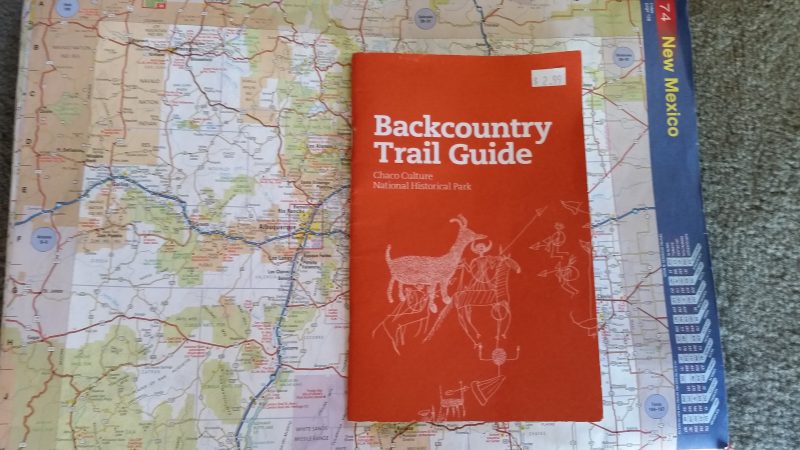
- Charge your devices. Imagine your disappointment when you go to take a photo, only to see the drained battery symbol.
- Stay hydrated. Carry plenty of water as well as a hat, sunscreen, sunglasses, binoculars and snacks during all hikes.
- Have proper footwear. Although these hikes aren’t technical, sturdy comfortable hiking boots or trail shoes make all the difference.
- Take your time. Hiking at an elevation of over 6,000 feet in the high desert environment is grueling.
- Leave the trail as you find it. Do not take anything from the trails – pottery, plants etc. You are being watched from afar by rangers with binoculars! You will almost certainly get caught.
- Cairns are strategically placed as markers almost everywhere. Where cairns don’t exist, the trail is rather obvious or is marked by water bars/pans. In general, the trails here are very well-marked.
The Road to Ruins: Driving to Chaco Canyon
The reputation of this road precedes it. Although the road to Chaco Canyon is formidable, with a little planning and some slow, cautious driving you will conquer it. Having a high clearance vehicle makes sense however compact cars make the trip easily, also.
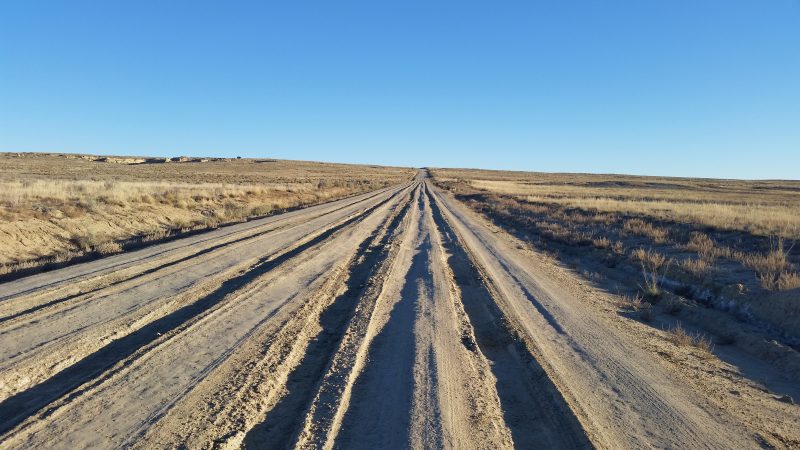
At this point you are likely wondering why the road to Chaco Canyon isn’t completely paved. Similar to countless others before me I posed that question to park rangers, likely exasperated by this common query. The reality is the roads to Chaco Canyon pass through private land and it’s a contentious dispute yet to be hammered out in the form of a smooth paved road.
Directions to Chaco Canyon and a Break-Down of Road Conditions
Chaco Canyon National Historical Park is reached via two very different routes : an east route via US Highway 550 and a south route via Navajo Service Route 9 , also listed as NM Route 57 on many maps. However, which route you take depends on where you are coming from.
Each route, along with potential road conditions, is detailed below. The east route is best approached from Albuquerque, Santa Fe, Taos and points east , while the south route is best approached from Gallup, Grants and points south of these cities as well as Farmington .
East Route Directions to Chaco Canyon and Road Conditions:
Coming from north or south on U.S. Highway 550 , follow signs indicating the turn for Chaco Canyon National Historical Park; this turn puts you on county road 7900. Continue on this paved road for 5 miles, then turn right on county road 7950.
This paved road continues for about 4 miles before transitioning to gravel. County Road 7950 then deteriorates rather quickly for the next 8 miles. Above all, stay alert and take it very slow .
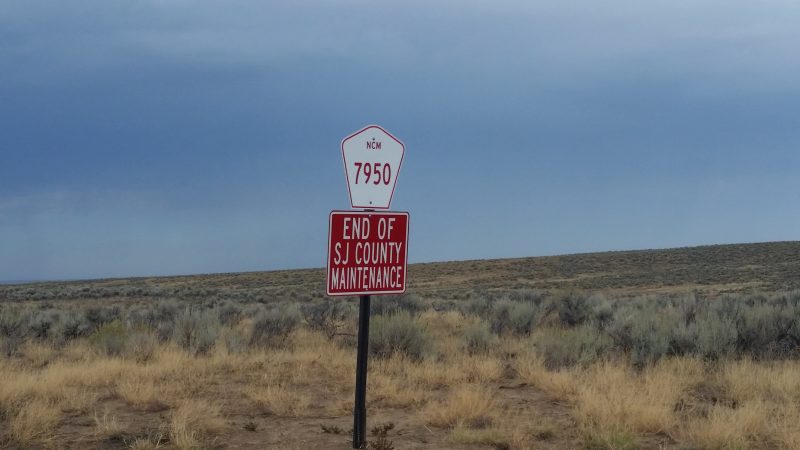
A sign (see above) indicates the end of county maintenance and from here the road condition increasingly worsens. For the next 4 miles expect very deep ruts during the drive and, after heavy rains, washed-out sections. To sum it up, expect the worst during this drive and be prepared for it.
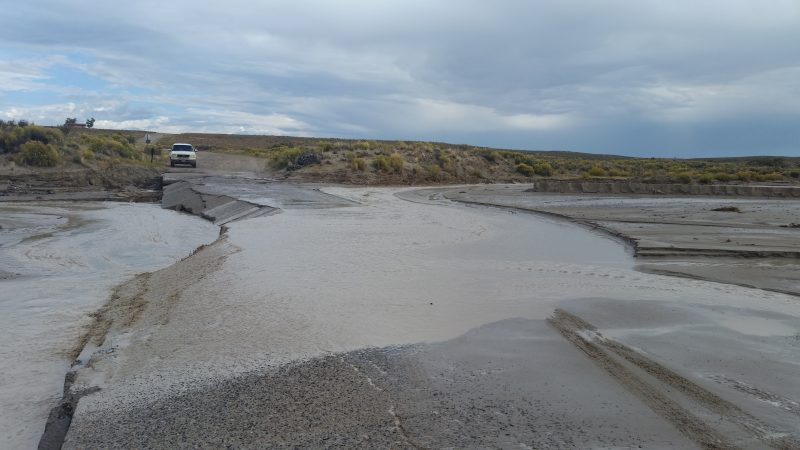
The last 2.5 miles of this road is mercifully paved before reaching the entrance of Chaco Canyon National Historical Park. Overall, it is 21 miles from U.S. Highway 550 to the last 2.5 miles of paved road into the park.
South Route Directions to Chaco Canyon and Road Conditions:
Coming from east or west on Navajo Service Route 9, confusingly shown as NM Route 57 on some maps; follow signs indicating the turn for Chaco Canyon National Historical Park. This turn puts you on Navajo Service Route 14, also shown as NM Route 57 on some maps. Continue 22 miles to the park entrance.
No matter the name, this dirt road is most noteworthy for being both a direct route to the park entrance and lightly traveled compared to the east route mentioned above. Expect washboard surfaces, plenty of dust and a few rough, rocky patches during this drive.
Tips for Driving to Chaco Canyon
- Keep an eye on the weather. It doesn’t take much rainfall to wash out public access roads to Chaco Canyon. Your vehicle can easily become stuck in the mud/ruts and flash floods are a reality. Use common sense during your drive and realistically know your vehicle’s limitations.
- No 4×4 needed . A high clearance vehicle is advantageous but not necessary during the drive to Chaco Canyon.
- Have a spare tyre . Also, know how to change a flat if you need to.
- Give yourself time . Allow 1 to possibly 2 hours to tackle this drive, depending on your vehicle’s constitution and the condition of the road.
- Watch out for livestock . Up to the point you enter the park, be aware of open range on both sides of the road . Open range is fairly self-explanatory – livestock is not fenced in and therefore may be present on the road. You will be responsible for the value of any animal you hit!
- See tip #1 again!
The Dark in the Park Featured Programme
Every Friday and Saturday evening from April through October the park features a programme highlighting the night sky at Chaco Canyon; depending on staffing this Dark in the Park talk may also be held on Tuesday evenings.
The visitor centre has a list of other available walks, talks and audio visual programmes on offer for the foreseeable week. Naturally, due to the increase/decrease in daylight hours, the Dark in the Park talk time changes on a weekly basis so check with the visitor centre for current times.
This very informative and entertaining talk comes with a strong Drifter’s recommendation. Park Ranger J.B.gives the presentation and he pioneered the astronomy programme in the park – he’s a wealth of knowledge on the night sky at Chaco Canyon.
Participants get to look through several telescopes including one in the observatory. Rangers guide you and your eyes on a galactic journey through the lens of each telescope, so allow up to two hours for the presentation and the hands-on telescope time.
If you prefer a dark sky and optimal viewing of the stars and the milky way, avoid camping here when the moon is full; this provides it’s own natural form of light pollution. The dark sky in New Mexico is incredible at night!
Chaco Canyon is the fourth darkest park in the U.S. Go online to find out where you’ll find the top 10 darkest skies in the US , or internationally. Should your preference be a lovely moonlit stroll, you couldn’t pick a better place than Chaco Canyon for a romantic ramble.
The Allure of Visiting Chaco Canyon
Hopefully the information and tips we’ve provided set you up for a successful and memorable Chaco Canyon camping trip. We also hope this has inspired you to hit the trails. Come fully prepared to experience Chaco Canyon and you’ll be planning to return before you even leave the park.

Visiting Chaco Canyon is an amazing experience which subtly lures visitors with it’s mystical ruins and peaceful solitude. Add to this the shifting colours of the sandstone cliffs as the sunlight strengthens and wanes and you’ll soon see why this setting has attracted folk for centuries.
Throw in the rather fantastical and whimsical rock formations whipped, gouged, cajoled and caressed through millions of years of wind/rain erosion, and you have a captivating landscape begging to be explored. New Mexico is full of enchanting locations like this waiting for you.
Pin Me Now!
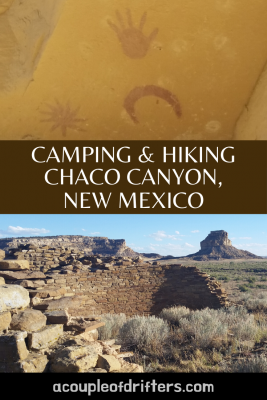
28 Comments
Hi! I am from NM and have been to Chaco Canyon twice in my life. The first was when I was a middle-schooler and my folks took us on a 7 day trip to Chaco during Spring Break. First of all, the road did not faze us. We had driven over much worse and longer dirt roads on our family adventures. The road was dirt from Highway 500 on in to Chaco in the early 70’s. We went to all the sites and took our time. My Dad, who felt incumbent to teach us things, had all kinds of information. We hiked all over the place and had a ton of fun. I also went when I was in college with some friend over a long weekend. I don’t remember the road being all that bad then, either. I guess it is my perspective. I take a regular sedan places most people would only take a high clearance vehicle. It is knowing how to drive on NM dirt roads.
Chaco is an amazing place. I suggest anyone who likes Chaco to go the Solstice Project website: https://solsticeproject.org/ Also they have a film out called The Mystery of Chaco Canyon, which is about the Chacoan peoples’ use of Sun cycles (Solstices and Equinoxes) and Lunar cycles (Max and Min on the horizon) to align their buildings. It is amazing. And it has to do with other sites in the 4 corners area, too. Also the roads. One of the things the Project does is consult with indigenous peoples in the area (Pueblo and Navajo) about Chaco. I appreciate their perspective deeply.
Thank you for such a balanced travel blog.
Hi Margaret. Indeed, those used to driving on unpaved roads likely wouldn’t be fazed by the two different access roads to Chaco Canyon. For this article we felt the most important factor to consider when planning any trip to Chaco (either driving, camping or hiking) would be the weather, especially during or after heavy rains. The road off US Highway 550 features a brief paved section which can and does become completely covered with flowing water after heavy rains. This portion was indeed flooded and even partially collapsed on our last visit – we include a photo of this in our article to prepare visitors for that possibility as this is not something to be taken lightly. With caution, a sedan could make it over either of the access roads to Chaco Canyon – hopefully those reading this article who do not have a high clearance vehicle will see our mention of this and will be encouraged to carefully get here on the road to the ruins. Despite our gingerly driving on one of the unpaved roads to Chaco, we experienced some minor structural damage to our van – we were much luckier than the few broke down vehicles we saw along the way. Thank you for the information from the Solstice Project! We especially find ancient road systems to be fascinating yet largely unsung attractions. We’ve found it difficult to find portions of Mayan sacbes on our travels to Mexico and Central America. We just left Peru a few days ago and are in Ecuador for a brief time – we return to Peru in a few weeks and look forward to seeing some intact portions of ancient Incan roads during our next visit there. Again, we appreciate the info on the Chacoan roads from the Solstice Project – your link could be of interest to others as well.
Your Drifters, Fiona and Jerry
Jerry & Fiona. We love reading your posts and comments from your followers. Your photos and images of all the beauty your adventures capture. Please continue to posts more photos in the future While in New Mexico. Love, Mom& Dad
Thank you! We promise to share more photos of our travels, in New Mexico and beyond!
Also, we thank you for your continuous support of everything we do – it means so much to us!
Fiona and Jerry,
I’ve been to Chaco four times since 2011. It was April in 2011 and the wind was ferocious. The road coming in from the East is even more so. It was not fun. Speed limit signs up to 25 mph, I drove at 10 mph. I knew there was a southern route but didn’t consider it until about three or so years ago. It appears to be graded as there are ranches in the area, and my teeth didn’t rattle. I love the area, hiked to Wijiji. Unusual ruins. Watch out for rattlesnakes, although I saw only one basking in the shade of a small bush. I have a bad habit of always looking down, good thing I did this time. He may have been very annoyed at how close I was. I did get a couple of neat pictures. That last night on the it rained, and rained. I was staying in the campground and wondered if I could get out. I did see cars coming in. People at the visitor center assured me it was reported the road was in good condition. I can’t tell you where it is, it’s very prominent, but there’s a cement something, wide on the road, a little deep. It’s to water to flow through and not wash out the road. No problem getting through. That was my last trip on the east road. I went south the next time. And I want to hike to the northern ruins. It’s quite a hike but mostly on flat.
Those paintings you call pictographs sure look like carvings, petroglyphs. Of course I could be wrong, you photograph misses some of that detail.
Thank you for this wonderful article. When I finally out of here post Covid, I’m heading south, or west, or southwest (I live in northern Colorado). It’s hard to decide. So much to see, so little time.
Hi Darlene, Thank you so much for the lovely comment!
Yes, springtime winds in much of New Mexico can be quite robust! The east road in can be a challenge to some vehicles, ours included! It rained once during a particular camping trip of ours as well, so we know how much of a challenge that can be. We know of the concrete “bridge” you are talking about and, on the particular trip of ours where it rained, we had to take our time traversing it on the way out of the park as the water was rushing fast. We hope your next trip to Chaco Canyon includes all the hikes you can do! The paintings of the hand and the moon are indeed pictographs and not petroglyphs.
Thank you again for the comment and we hope you make it back to Chaco Canyon soon!
Thank you for providing this information. Sure brought back some fond memories. We were out at Chaco in July 1989 & 1999. At that time, you didn’t need reservations for a campsite because there weren’t many people crazy enough to make the trip out there yet. All you had to do was show up and pick out a spot that wasn’t already occupied.I think there was only one rest room at that time but it really wasn’t an issue. We made the hike out to Penasco Blanco and South Mesa and what stands out in my mind were those pesty gnatts that would constantly try to get in your ears and behind your glasses. Also the thunderstorms that moved in around dinner time and stayed throughout the night. The force of the wind flattened our tent and broke one of the fiberglass tent supports, then there was the stream of water that came through the floor of the tent. All in all, we wouldn’t change a thing. It was a great experience. Was the only place I’ve ever been where I could see stars right down to ground level!
Al & Loreen,
It doesn’t sound like too much has changed over the years, right down to the occasional flooded tent! As you know, the South Mesa Trail was our favorite hike – we’ve done that trail in both directions and it gets better each time. Are you planning a trip there? I know they are closed now, but we hope you have a visit in the future planned. There’s another road to the the park – it’s handy if you’re arriving from the Gallup/Grants area and, although it’s still rutted and gnarly, we think it’s in better condition than other one!
Do check out the free night sky programme when you make it back. Yes, the dark sky is incredible there! Thanks for the great comment!
Your Drifters, Fiona and Jerry.
Love this post! I had the chance to visit Chaco a couple years ago and just loved it. Did not make the Penasco Blanco Trail, but did manage the entire Pueblo Alto and South Mesa loops. Sea fossils are amazing on the Pueblo Alto trail, including cool impressions of mollusks, along with the worm trails. Jackson Stairway – definitely not possible! In fact, the handholds (prior to the “steps”) were specifically designed so that if intruders tried to climb the wall, not knowing the exact order of which hand or foot to put there, would get to the top, not know how to proceed, and fall down. Eek! Per a ranger’s suggestion, I did the South Mesa Trail “backwards,” and thought it worked nicely. The protected spots along the way, just above the South Gap. looked to me like prehistoric campsites. I remember seeing lines in the rock from sharpening of tools. Maybe there was some info in the Backcountry Trails book. (I should have gotten it!) Loved the view of Shiprock (waaaay in the distance, faint on the horizon) from Tsin Kletzin.
Thanks for all the info; I feel as if I had another visit there. 🙂
Cindy, You make it seem like you were there just the other day, along with us! You taught us something about the Jackson Staircase; that information was not in our backcountry guide, so thanks for that! We certainly recall seeing some of the little things you mention, like the score marks in the rocks where tools were sharpened. We are both so happy you enjoyed Chaco Canyon as much as we did; we could have spent weeks there re-hiking all those trails and taking in all of the views along the way. When were you there? Thanks again so much for reading this post and sharing your experience of Chaco Canyon. Your Drifters, Fiona and Jerry
Hi guys! I’m sorry I never got back to you! I was at Chaco in the spring of 2015. Recently came back from hiking to Keet Seel at Navajo National Monument and already planning to get to Horseshoe Canyon (part of Canyonlands) and Cathedral Valley in Capitol Reef. The Southwest is endlessly fascinating!
It sounds like you enjoy hiking in the Southwest as much as we do. We have some more recommendations for hiking around Albuquerque on our blog, too. Let us know how your other hikes go.
Hi Fi and Jerry,
Thankyou for sharing great photos of stunning scenery.
Keep safe, D and Susie
Thanks D and Susie for your support. Tomorrow (Oct. 30th) we finally cross the border into Mexico and we can’t wait. Hopefully there’ll be even better photos to follow. Finally the kayak will see some water! You get some strange looks driving through the desert with a kayak! Your Drifters, Fi and Jerry
Fiona, what a fascinating and informative post. This was very informative and gives you a feel for how remote the Chaco Canyon is . I also was amazed by the photography. Fiona, being you are an Archaeologist this is a dream come true for you, I know Jerry loves this as much as you. Safe travels you two drifters.
Donna, They say getting there is half the fun! It is certainly true. I have always wanted to visit this place, but it never happened when we lived here in New Mexico. We are both so happy to have the time to do it now. The hikes were amazing and so was the scenery along the way. I am glad you enjoyed the photos. Thanks again for following and sharing! Your Drifters, Fiona and Jerry
Wow. Just wow. Fascinating and informative! Love the muddy boot details. Your stories are really fun guys.
Dave, As you can see, you must keep an eye on the weather at Chaco Canyon. It really is a beautiful place and one of the less visited corners of the state, for some rather jolting reasons! Thanks again Dave for reading and enjoying our posts. Hello and Love to everyone at PWM! Your Drifters, Fiona and Jerry
Fiona, Thank you for taking us on this journey. Sean and I will add it to the list of “Need to see places”. Maybe if I’m lucky, I will get to Ireland first, so that we can roam the land of my ancestors.
I continue to wish you and Jerry well, and hope to read more soon Travel safely. Best regards, Kerry and Sean
Kerry and Sean, We hope you make it to Chaco Canyon next time you both are out west. Just be prepared! You will love Ireland…it is only a 6 hour flight from the east coast. If you need any tips on Ireland, just give us a shout! Thanks again for following our blog. We really do appreciate it! Your Drifters, Fiona and Jerry
Fiona, what an extensive post about Chaco Canyon. Until now I was unaware of it. Dark night skies are something to behold. Two of my favorites…Oil Creek Campground out of Titusville Pa and Lake Kipawa in Quebec (fishing trip). Even though none of the pics in your post showed the Griswold umbrellas, I bet you aired them out a time or two. Nice work on the van Jerry. Love. DAD
David, Thanks for hanging in there and reading such a lengthy piece. The hikes (and the night skies) were indeed worth every struggle to get there! Next time we are in Pennsylvania you will have to show me your favourite night-time sky. We have yet to use the umbrellas and hope the only use they get is for sun-shade on the beaches of Baja! Jerry was quite proud to have fixed the van…he learned from the best. Your Drifters, Fiona and Jerry
Buddy, I haven’t seen you in probably a quarter of a century, but I wish you guys nothing but the best, and safe journeys. I anticipate your posts now, and hopefully we will see one another again 🙂
Brad, It has been about a quarter of a century. How does the time slip by so quickly? Reading your comment made me think of all the trouble we got into as kids and all the adventures we went on. Those adventures stuck with me, and I am so fortunate to be able to continue the adventure with Fiona. I hope to see you when I am back in the Shenango Valley. We both thank you for looking at the blog and following along as we go. You made my day by getting in touch, and I thank you for all of our past adventures together as we were growing up. Your Drifters, Jerry and Fiona
I am always impressed at the variety of food you have access to in your travels. As someone who has spent almost all of his life having to eat in what are called “South of the Border” restaurants, your pictures of different foods wants me to sue them for false advertising. Keep the pictures coming. I can always drool! Lily & I caught you as you were backing out to leave on your latest adventure Thurs morning. She will miss your kindness. Bill
Bill, We hate saying goodbye just as much as you do. Pulling out of the driveway that morning and waving to you and Lily was all we could do to prevent us from turning into a bunch of sobbing individuals! Fiona and I certainly enjoyed being your neighbor for 14 years, and we thank you for everything. Please keep reading, for we hope to continue to wow you with more and more food photos. So, we wish you and Vicki a fond farewell, and give Lily and Jess all the hugs and kisses you can from us. We will miss you all. Lots of love, Your Drifters, Jerry and Fiona
http://digg.com/video/longest-drivable-distance-on-earth
Thought you might want to take this trip :). Bill
Bill, Thanks for the video. You know us; we are just crazy enough to take any route and the urge to seek out this journey is quite compelling! Is this a future challenge in the making?!?! Something tells us you would have done a journey like this back in the day, for you are someone who likes an adventure as well. We hope to see you on that road one day! Thanks for your support and keep on following us on our blog. Give our love to Vicki and the pups. Your Drifters, Jerry and Fiona
Leave a Comment Cancel
Your email address will not be published. Required fields are marked *
Email Address
Save my name, email, and website in this browser for the next time I comment.
- Skip to primary navigation
- Skip to main content
- Skip to primary sidebar
- Skip to footer
TravelAwaits
Our mission is to serve the 50+ traveler who's ready to cross a few items off their bucket list.
Returning To My Roots: National Park Ranger Revisits Chaco Canyon
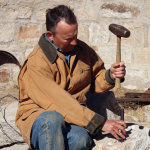
- Activities and Interests
- Destinations
- National Parks
- United States
- United States National Parks
I camped near a shallow wash on the border of Colorado and New Mexico. My small sagebrush fire cast a pale glow into the growing twilight. Nighttime in the high desert is both fascinating and a bit scary. Nocturnal creatures emerge and the spirits of the old ones seem close.
The next day, I would strike out for Chaco Culture National Historical Park , often called Chaco Canyon, a place I’ve waited many years to see again. In the morning, I left the paved highway near the Nageezi trading post and headed for the park. A freezing rain pelted my pickup and dark gray clouds hung low over the mesas. The sleet gave way to a driving snow as I descended into the canyon.

The Beginning
I first visited Chaco in the summer of 1986 after leaving an unfulfilling job in search of a different career path. I learned about it from a friend who visited the site and spoke of its remoteness and solitude. For years, I had explored out-of-the-way places in the Southwest, but now, after learning of this mysterious national park, my spirit of adventure was rekindled.
I decided that, not only would I travel there, I would see about getting a job at the park. After researching the job postings for national park employment, I applied and discovered my three college semesters studying history and archaeology qualified me for a summer job as an archaeological assistant at the park. During the next two summers, I worked on several projects and gained insight into the lives of these ancient and mysterious people who, for thousands of years, eked out an existence in this bleak, northern New Mexico country.
Those two summers gave me a rare opportunity to work on projects designed to protect the park’s resources and, as a special treat, to visit remote sites far off the beaten path. Working at Chaco fulfilled my long-dormant dream of becoming a National Park Service ranger. I had found my bliss! Over the next 25 years, I had the good fortune to work at seven national parks and monuments before retiring several years ago. It was an exhilarating experience and one I’ll always cherish.

The Chaco Saga Begins
It was here in a wide, shallow canyon that a culture we now call Ancestral Puebloan developed, flourished, and withered away under a harsh, desert sun. The story at Chaco represents a 10,000-year gradual progression from nomadic hunter-gatherers to more sedentary farmers and artists. For centuries, the people, traveling on ancient migration routes, hunted animals and gathered seeds for food. Over time, they acquired skills as farmers, master stone masons, and most importantly, leaders in the establishment of the canyon as an economic, trading, and spiritual center for the entire region. Artifacts found at Chaco show a trade network extending west to the Pacific Coast and as far south as Central America.
Around 500 C.E. (formerly termed A.D.), the cultivation of crops arose and greatly reduced their need to hunt and gather. In 900 C.E., in a burst of cultural florescence, they began constructing great cities. They quarried sandstone blocks to build a dozen stone cities in a 9-mile arc across the central portion of the canyon. This high-density cluster represents the zenith of their architectural mastery. Over 400 miles of well‑engineered roads connected these cities to 75 smaller town sites. The ruins of multi-story communities at Penasco Blanco, Chetro Ketl, Pueblo Bonito, and others bear mute testimony to the intricate craftsmanship of these desert dwellers.
Pueblo Bonito, perhaps the greatest, freestanding masonry structure ever constructed in North America until the 18th century, contained over 800 rooms and rose, in a stair-step fashion, to a height of five stories. Carefully designed and constructed between C.E. 850 and 1150, Bonito is the finest example of the unique Chacoan architecture.

The Glory Fades
Today, it’s hard to imagine as you look at its crumbled walls, its rooms choked with weeds and dust, that this was once the crown jewel of a magnificent empire. At their peak, the Ancestral Puebloan culture created Bonito and other great cities as monuments to the glories of their civilization.
The Chaco People were farmers in a harsh land. Rainfall averages a scant 10 inches per year with most falling during severe, late‑summer thunderstorms. They designed intricate water-management systems to irrigate crops of corn, beans, and squash on the canyon floor.
Despite these advances, the winds of change would sweep across the canyon and forever alter their way of life. Although they were masters at desert agriculture, a prolonged drought from 1130–1190 ended their agricultural experiment in the desert as they slowly succumbed to an ever-changing climate. Compared to the measured rise of their culture, its end was swift.
After 1150, construction of new buildings ceased and the people abandoned their magnificent cities and dispersed throughout the region. By 1250, the collapse of the Ancestral Puebloan culture at Chaco Canyon was complete.
Their innovations in agriculture, architecture, and social organization are models for modern society. But, in the end, they stripped the scattered trees from the land for building materials and fuel, lowered the water table by neglecting to control gully erosion, and depleted the native plants and animals to feed the population. Once again, they became nomads to complete the great circle from which they began.

Reflections On Revisiting
During my recent visit, I hiked to an outlying site called Wijiji. While working at Chaco, I often went there to meditate within this ancient culture. There was something both exciting and disquieting about Wijiji. On a visit years before, as I sat against its ancient wall, I heard strange voices and felt a presence that sent chills up my spine. I can’t explain what happened to me that day but I still shiver when remembering that feeling.
This time, I was also spooked by what I thought was something moving throughout one of the room blocks at Wijiji. It was dusk and my rational mind rejected what I had just seen, but the imagination works on a level beyond logical thought. While hiking back, I pondered what had happened and thought of the world that lies beyond our rational minds. It’s a place of images and ghosts that defy definition. Once again, the magic of Chaco had come to me.
On my last night at Chaco, I stood in a shower of moonlight amid the deserted room blocks of Pueblo Bonito. I wondered about its ancient inhabitants. Did they, like us, believe their great cities and their glorious civilization would last forever?
The months I’d spent at Chaco years ago convinced me that the spirits of the Ancestral Puebloans still dwell in this most hallowed place. When you visit Chaco, take time to relax, to savor the magic of the desert. With a gentle wind and a bright moon overhead, unhook your logical mind and listen — you may hear strange voices carried on the evening breeze.
The stark beauty of these ancient ghost towns will heighten your spirit of adventure and rekindle the priceless sense of imagination so often lost in the passage from childhood to adulthood.
Read more on visiting Chaco Culture National Historical Park .

Pat also takes pleasure in writing about the fascinating people and places in the West.
- Travel Blog
- Film in Farmington
- Sports Facility Guide
- Meetings in Farmington

- Guided Tours
Farmington, New Mexico is a hub for unique attractions, history, culture, and outdoor adventure. Whether you are looking to get outdoors to enjoy an authentic southwestern adventure, or prefer to walk through the pages of ancient history, we can help you find the guided tour that’s right for you.
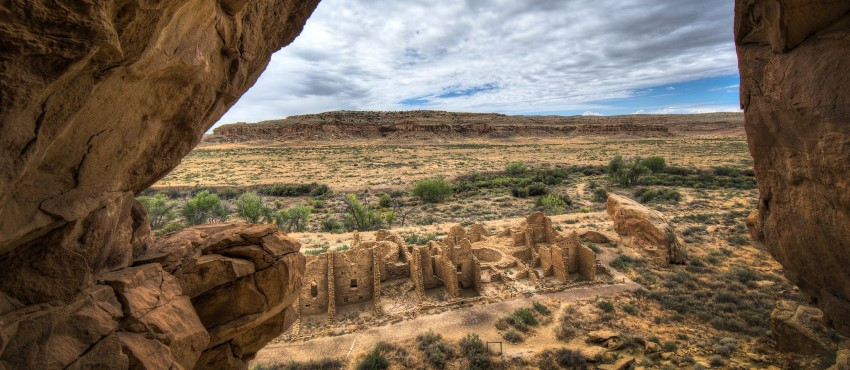
Our local tour and guide companies can accommodate groups or individuals, so we have something for all vacationers. Whether you're looking for a family-friendly getaway or couples retreat, Farmington offers several options for guided exploration.
Discover our Members and #PlayFarmington

AAM’s Mild to Wild Rafting & Jeep Tours, Inc.
Durango, CO
800-567-6745
Colorado adventure based trips are available throughout the year. Call or visit Mild to Wild’s website for information and rates regarding their water rafting and jeep tours.
Visit Website
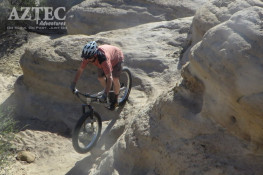
Aztec Adventures
970-759-2126
Aztec Adventures is an event and tour guiding service focused on cycling experiences throughout San Juan County, New Mexico. Promoters of the Durango ~ Farmington Bicycle Tour, Galactic Grinder and Roost the Ridges an Enduro Style race. Also, they offer day and overnight tours of a variety of experiences. Ranging from cultural tours, gravel rides, singletrack trails, skills lessons, and more.

Bear Automotive Off Road Adventures
109 E Pinon St Farmington, NM 87401
505-716-1621
Bear Automotive is your go-to for off road adventures! This one-stop shop is a must for those looking to experience the epic off-roading found in Farmington, New Mexico! From ride-along and guided 4x4 tours, to UTV and Jeep rentals this adventure company has you covered.

Desert River Guides
109 E Pinon St, Farmington, NM 87401
505-427-7734
Let local rafting experts guide you on a memorable river experience! Desert River Guides offers a variety of family-friendly and scenic floats along the Animas River and the San Juan River in the Farmington area.
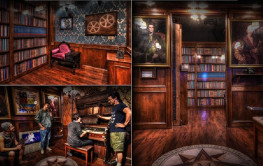
Escapology Farmington
4601 E Main Street Farmington, New Mexico
505-675-0303
Farmington's original premium real-life escape game experience! Located in the Animas Valley Mall, up to 6 players will be challenged in this new attraction by working together to find clues, solve puzzles, and unlock locks that will free them from the game room. Do you have what it takes to escape? Open Wednesday - Sunday.
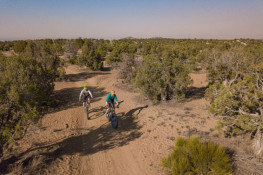
High Desert Mountain Biking Tours
Farmington, NM
505-860-3181
Experienced and new riders will enjoy working with High Desert Mountain Biking Tours! Let local mountain bike enthusiasts help you discover the best trails for your ability and or tips and training for mountain biking in the area.
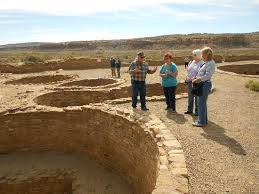
Journey Into The Past Tours
6131 US-64, Bloomfield, NM
505- 632-2013
Journey Into The Past Tours offers a unique opportunity to learn about and experience the amazing archaeological treasures of the southwest.
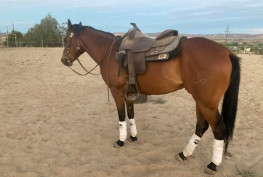
Mullen’s Equestrian Services
47 Road 4785 Bloomfield, NM
505-635-0812
Enjoy a scenic trail ride or riding lessons with local professional horse trainers and instructors. Mullen's Equestrian Services is a well-known and respected equestrian service throughout northwest New Mexico. This team is ready, willing, and able to help you create a memorable experience!
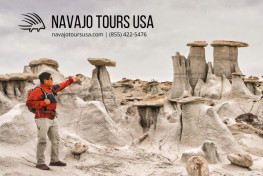
Navajo Tours USA
Nageezi, NM
855-422-5476
Embark on an enriching hike through the Bisti Badlands with Navajo Tours USA. The 5-hour tours provide insights into both the history of the landforms and their Indigenous cultural significance. Enjoy additional tour offerings to Chaco Canyon, the surreal Ah-Shi-Sle-Pah Wilderness, and the majestic Shiprock Peak. Photo enthusiasts are encouraged to pack their gear to capture the spellbinding moments!

Roadrunner Flight School
1090 W Navajo St, Hangar 10 Farmington, NM
505-860-1029
Take to the skies with Roadrunner Flight School! As the only privately owned flight school in Farmington, New Mexico. They are passionate about bringing quality flight training to this area and offer training, discovery flights, and airplane rentals.
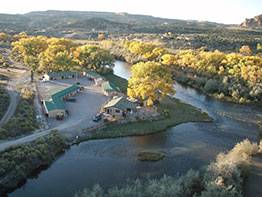
Soaring Eagle Lodge
48 Road 4370, Navajo Dam, NM
505-632-3721 or 800-866-2719
Soaring Eagle Lodge, nestled on the banks of the San Juan River, is Navajo Dam’s only riverfront lodge. The river is world-renowned for year-round fly fishing at its best. They offer lodging, meals, guide service, fly fishing instruction, float trips, fly shop, private river access on the Jacquez Ranch, and much more. Cabins are reserved for anglers in the high season.
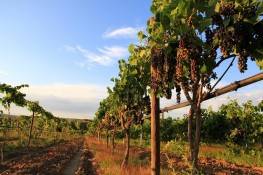
Wines of the San Juan
233 Highway 511, Blanco, New Mexico 87412
505-632-0879
Visit Wines of the San Juan and experience exceptionally crafted wines beneath towering sandstone cliffs, and marvel at the curiosity of their friendly peacocks!
- Outdoor Adventures
- Native Culture
- Self-Guided Tours
- Performing Arts
- Four Corners
- Family Adventures
Chaco for Life Tour | Denver, CO
Fri jun 28 2024 at 10:00 am to sat jun 29 2024 at 04:00 pm, rei flagship store | denver.
Event Venue & Nearby Stays
REI Flagship Store, 1416 Platte St, Denver, CO 80202-6161, United States,Denver, Colorado
Discover more events by tags:
Sharing is caring:.

IMAGES
COMMENTS
Chaco Impenetrable - Eco Tur, J.J. Castelli, Chaco, Argentina. 5,694 likes · 4 talking about this · 57 were here. Chaco Impenetrable" ARGENTINA"- ÚNICO -...
The Chaco Safari Tour is for those who lust after real adventure. It gets you out in the wilderness in one of the most fascinating yet hostile environments on earth were large mammals abound. Visiting remote national parks Defensores del Chaco, Médanos del Chaco and Teniente Enciso we´ll be looking for Jaguar, Puma, Tapir, Chaco Peccary and ...
Hotel Eco Tur, Bermejo, Chaco, Argentina. 3,608 likes · 1 talking about this · 178 were here. Calido, ideal para descansar, mucho verde con arboles autóctonos inmensos. in lugar para huéspedes felices!!! Hotel Eco Tur, Bermejo, Chaco, Argentina. 3,608 likes · 1 talking about this · 178 were here. ...
For the ecotourist, Chaco provides an opportunity to see some very rare wildlife. Chaco's northernmost district, home to the Defensores del Chaco National Park, is called Alto Paraguay. Alto Paraguay is home to jaguars, puma, tapir, tagua, giant anteater and the night monkey. The large region is also home to over 500 species of native birds.
Chaco Impenetrable - Eco Tur, J.J. Castelli, Chaco, Argentina. 5.702 Me gusta · 9 personas están hablando de esto · 57 personas estuvieron aquí. Chaco...
Chaco Canyon Day Tour - Heritage Inspirations. Full-Day Tour Available in Albuquerque, NM, Chaco Canyon, NM: Saturday. 7:15 am - 5:45 pm. March 1 - November 30: (Not offered in July and August) $325 per person + tax*. VARIED PRICING: Hotel Chaco guests $299 + tax tour price per person.
Chaco Canyon was a good place to settle in ancient times. In the middle of a high desert where not much grows, Chaco Wash offered enough water for the survival of large groups. The first evidence of people living here dates back 4000 years, although they built nothing lasting until 400-500 AD.
Make your first stop the Visitor Center. From there, a 9-mile loop road accesses five major Chacoan sites, including Pueblo Bonito. Guidebooks for these sites can be purchased at the park store inside the visitor center. Pets are not permitted on these front country trails. The only exception are service animals. Overview of Chetro Ketl.
Campsites are located in the eastern section of Chaco Culture National Historical Park. 7 Must-do Things To Do at Chaco Canyon. Chaco Culture National Historical Park's remote location makes it a great place to enjoy history, nature, solitude, and night skies. For these reasons, Chaco Canyon is an ideal place for hiking, cycling, and camping.
Chaco Culture National Historical Park is a unique cultural place, designated as a UNESCO World Heritage Site. Chaco Canyon was the center of a thriving ancestral Puebloan culture a thousand years ago. The monumental scale of its architecture, the complexity of its community life, the high level of its community social organization, and its far-reaching commerce created a cultural vision ...
Make Sure Your Car Can Handle Dirt Roads. You need to drive about 20 miles on a dirt road to reach Chaco Culture National Historical Park. You don't need a four-wheel drive to get through it, but a high-clearance vehicle is helpful. However, most cars can make it in good weather; just don't drive your brand-new low-clearance luxury car out ...
Pricing List. Two adults $157 / person $314. Maximum 10-12 people per tour. Youth Age 13-17 $84. Children Age 7-12 $54. Six years and under FREE. BOOK NOW SUBSCRIBE. Chaco Canyon. Chaco Canyon.
Inside Chaco - Tour | Chacos. Sizes and colors are limited and cannot be exchanged or returned. Use Code: BYESUMMER ». BYESUMMER. From August 22nd, 2024 through September 2nd, 2024 at 11:59pm PST, receive 20% off for full price product and 40% off sale product at chacos.com. Enter coupon code BYESUMMER at checkout to activate.
Formally dubbed Chaco Culture National Historical Park, it can only be accessed by a rough dirt road, which scares away tour buses and pansy drivers, keeping annual visitor numbers down to a scant ...
Chaco Culture National Historical Park, also known as Chaco Canyon, is a 1,000+ year old UNESCO World Heritage Site in northwestern New Mexico. It's a collection of ruins built by the Ancestral Puebloans that inhabited this region from about 900 AD to 1150 AD .
A trip to Chaco Canyon requires thoughtful planning and preparation. From choosing the best time to visit for pleasant weather to arranging accommodations and guided tours, our comprehensive guide ensures an unforgettable and seamless experience. Remote and Isolated: Chaco Culture is located in a remote and isolated region.
Last Updated on: 19th June 2023, 06:41 pm Before you visit the UNESCO World Heritage Site Chaco Culture National Historical Park in New Mexico, here's a list of everything you need to know - from access to biking to hiking to camping to soaking in the essence of Ancestral Puebloan culture on a journey into a canyon sacred for thousands of people between AD 850 and AD 1250.
Eco Tour;Hotel EcoTur is a hotel in Chaco. Eco Tour;Hotel EcoTur is situated nearby to Playón Deportivo and Registro Civil. Mapcarta, the open map.
Storm Clouds Gathering Over Chaco Canyon. Also, keep an eye on the weather for the immediate 3 or 4 days preceding your trip. Dry conditions are required to tackle the road and to complete at least one of the Chaco Canyon hikes on the Peñasco Blanco trail. See Hiking in Chaco Canyon below for more information.. Within each Tips section below, the weather and it's ability to drastically ...
The story at Chaco represents a 10,000-year gradual progression from nomadic hunter-gatherers to more sedentary farmers and artists. For centuries, the people, traveling on ancient migration routes, hunted animals and gathered seeds for food. Over time, they acquired skills as farmers, master stone masons, and most importantly, leaders in the ...
109 E Pinon St Farmington, NM 87401. 505-716-1621. Bear Automotive is your go-to for off road adventures! This one-stop shop is a must for those looking to experience the epic off-roading found in Farmington, New Mexico! From ride-along and guided 4x4 tours, to UTV and Jeep rentals this adventure company has you covered.
Chaco for Life Tour | Denver, CO at REI Flagship Store, 1416 Platte St, Denver, CO 80202-6161, United States,Denver, Colorado on Fri Jun 28 2024 at 10:00 am to Sat Jun 29 2024 at 04:00 pm
20218917209 - Eco Tour Cusco E.I.R.L. Find us on: Garcilaso Street No. 210, Inside Of. 109. We answer your questions: [email protected] Our Services Certified: Sales +51 984 990 052 ...